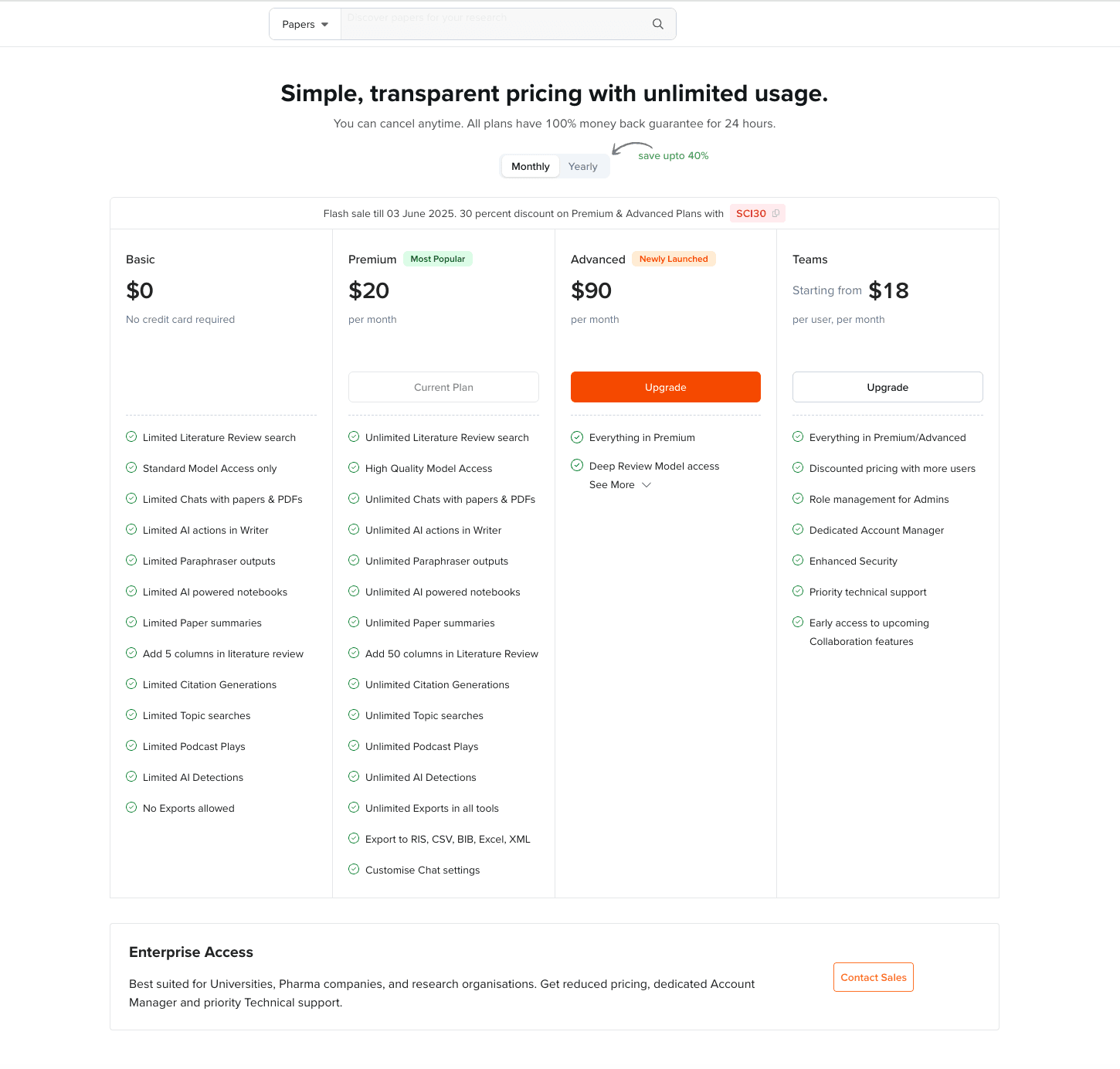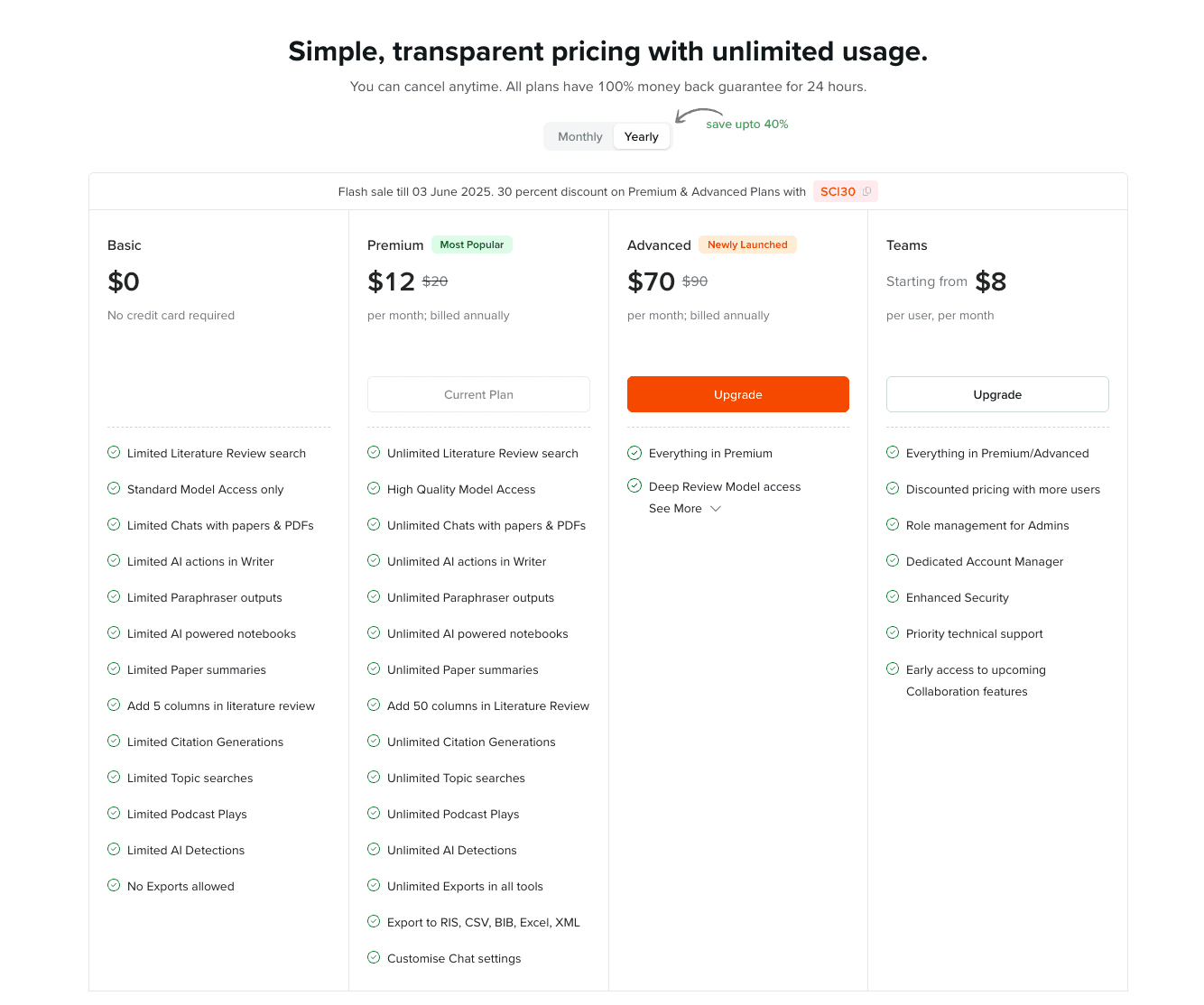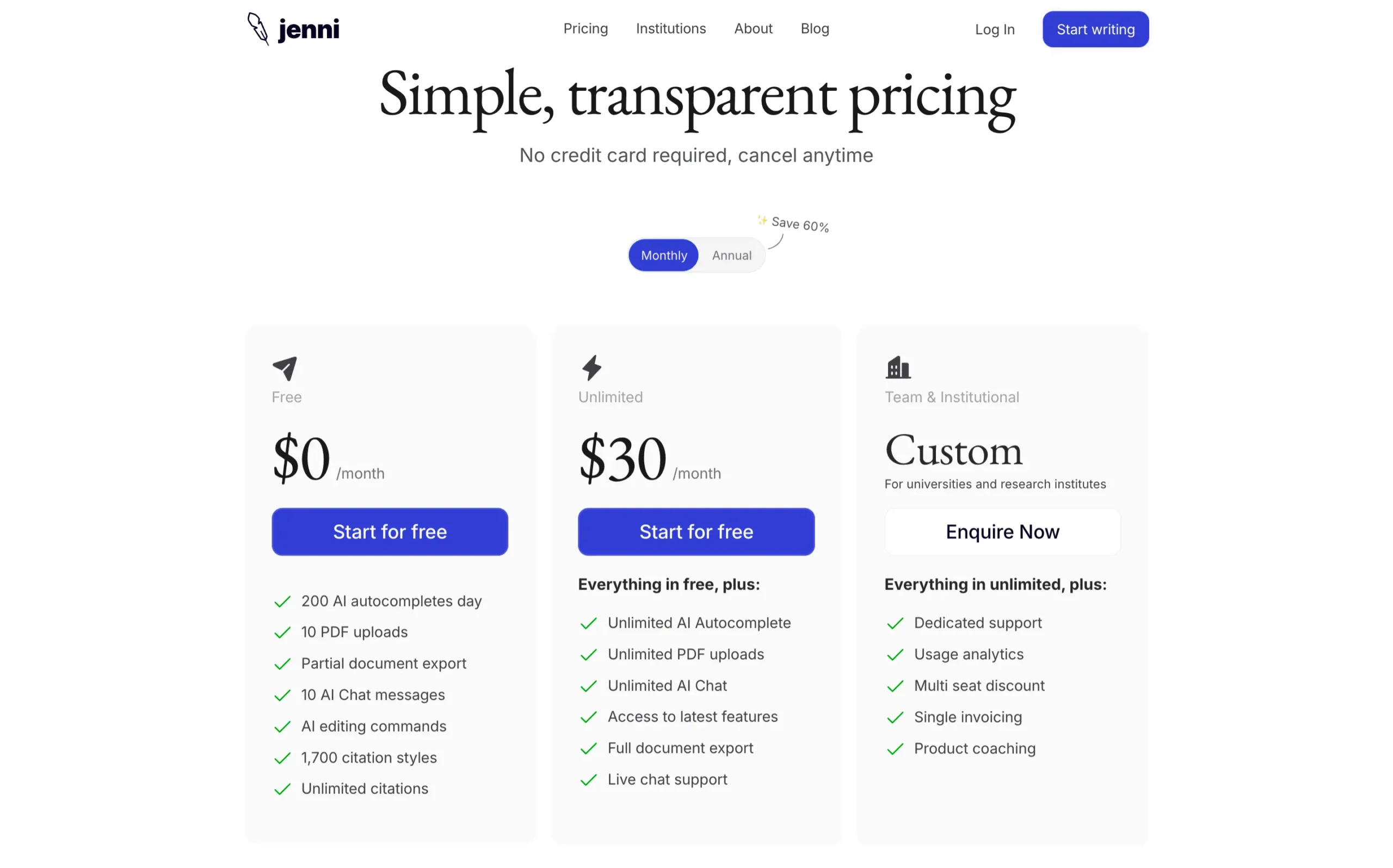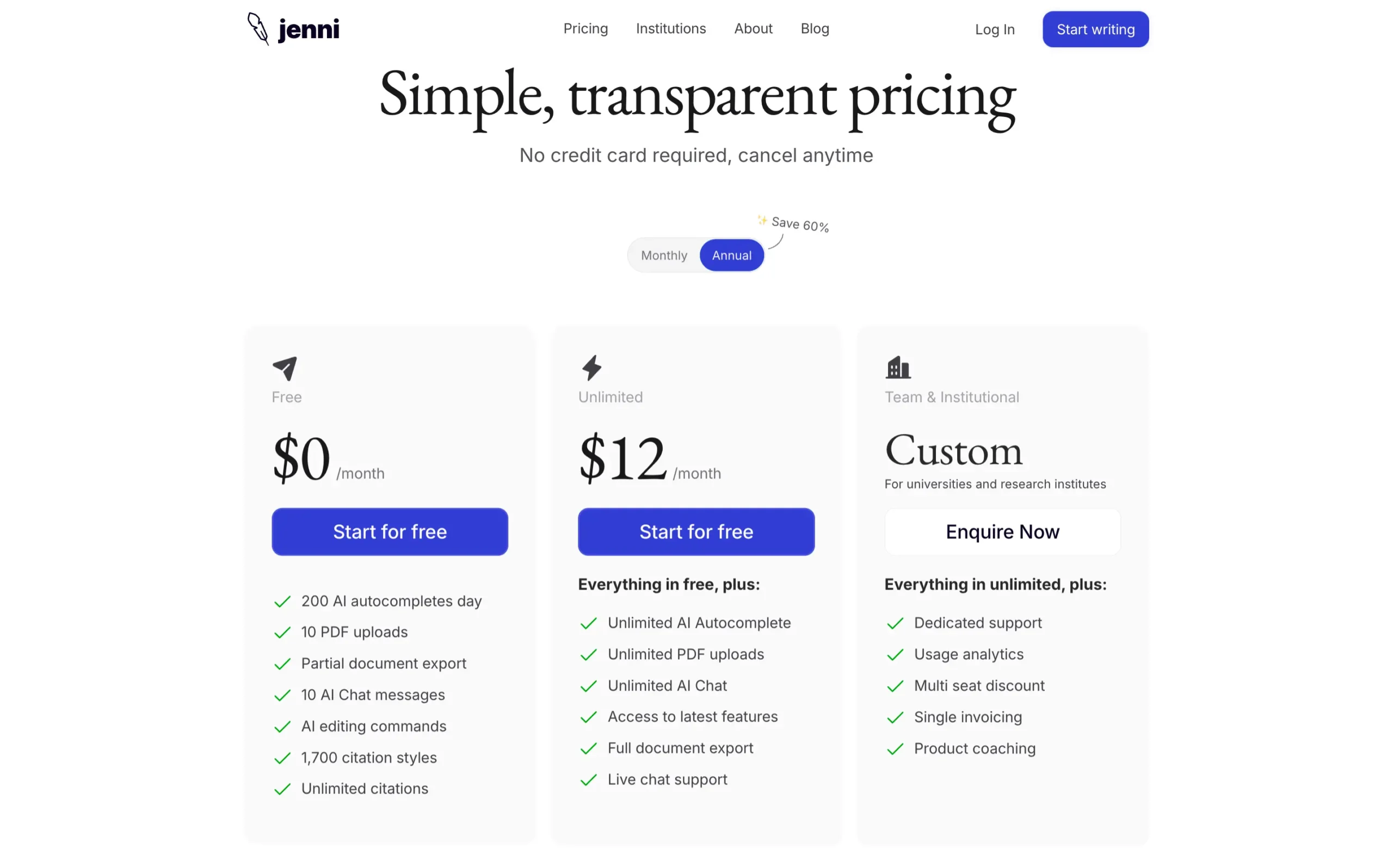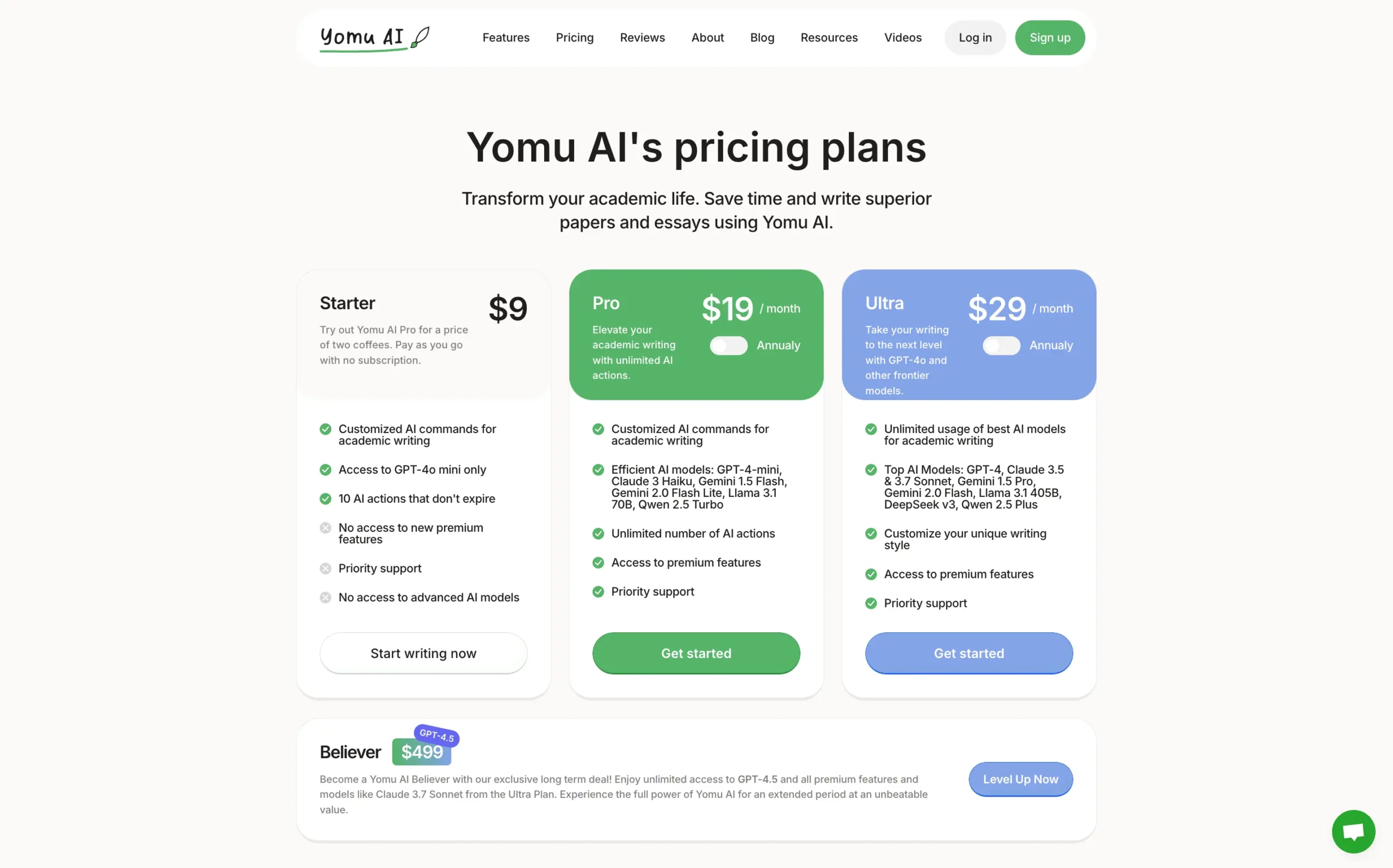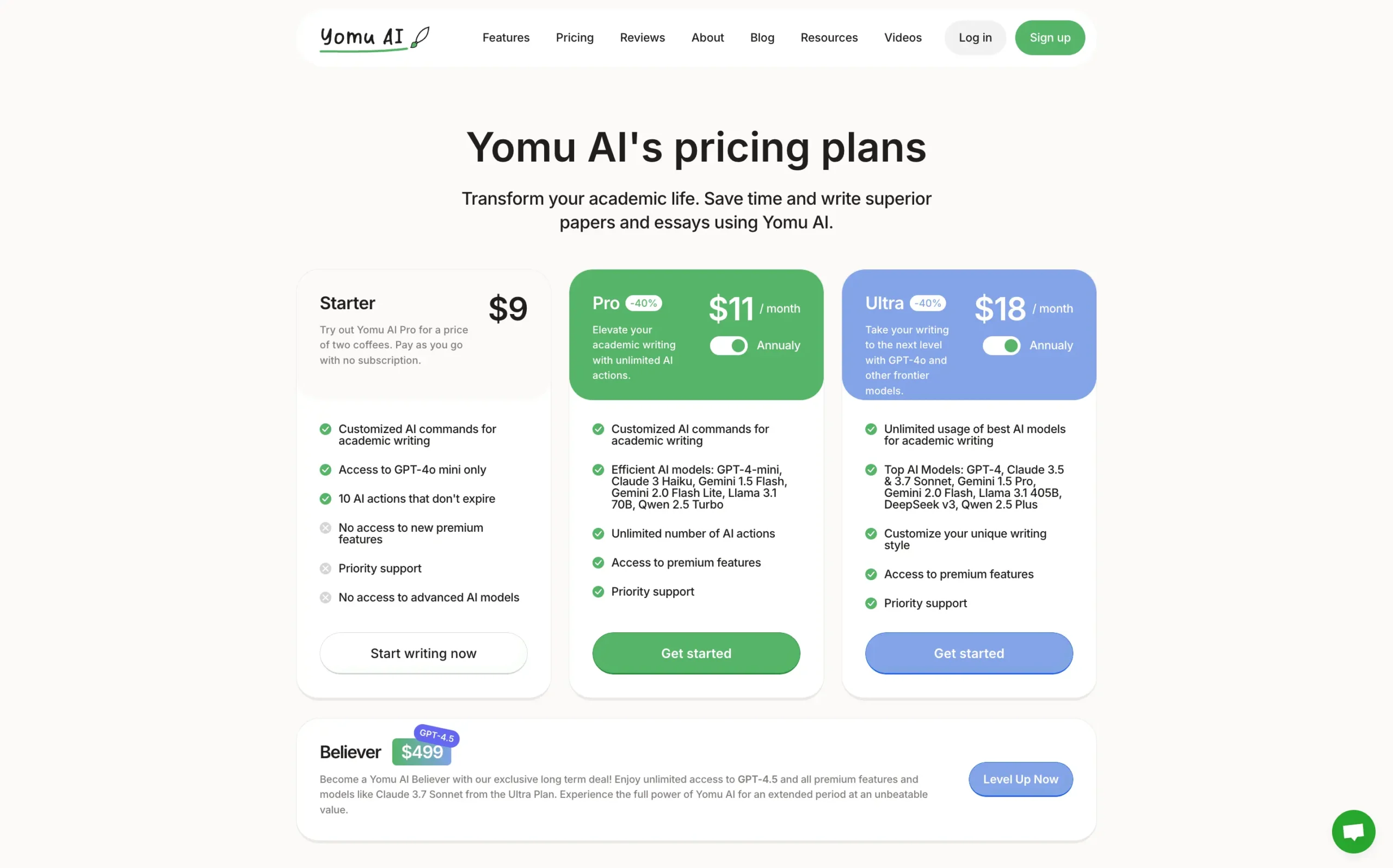The 5 Awesome AI Research Paper Writers To Write Exceptional Academic Papers

You sit before a blank document. The cursor blinks. Your thesis deadline approaches, and academic writing feels designed to break human spirits.
You are not alone.
A 2018 survey of 7,000 researchers found that nearly 76% struggled with manuscript preparation.
The problem is clear: academic writing demands rigid rules nobody teaches properly, citations that one misplaced comma destroys, and formal language that turns simple ideas into tortured prose.
AI research paper writers promise to fix this.
Most are garbage.
They invent citations, butcher academic tone, and produce generic fluff that any professor spots immediately.
I tested every major AI research paper writer. I fed them identical prompts, checked their citations, and measured their actual usefulness for real students writing real papers.
I discarded the frauds and failures.
Five tools survived. These AI assistants can genuinely help you write better papers faster.
I will tell you exactly what each tool does well, where it fails, and who should use it.
Your blank document waits. Let’s fill it.
Best for serious academic writing

Paperpal
Perfect for: Students and researchers needing verified citations and comprehensive writing support
Pricing: $139/year ($25 monthly)
AI assistant with real citations from 22+ years of publishing data. Offers grammar checking, source finding, plagiarism detection, and journal formatting.
Best for literature reviews

SciSpace
Perfect for: Researchers conducting comprehensive literature analysis and systematic reviews
Pricing: $144/year ($20 monthly)
AI research platform with dynamic tables organizing 100+ papers automatically. Access to 285 million research papers and analysis tools.
Best for clean writing assistance

Jenni AI
Perfect for: Writers wanting minimal interface with contextual AI suggestions and progressive support
Pricing: $144/year ($30 monthly)
Minimal interface AI writing assistant that provides suggestions when stuck. Maintains user control while offering contextual help and citation support.
What are the best AI research paper writers?
How I picked
The truth: Most AI writing tools exist to extract money from desperate students. They promise academic excellence and deliver sophisticated plagiarism.
The good tools—Paperpal, SciSpace, Jenni AI—do less but do it honestly.
The best AI research paper writing tools at a glance
| TOOL | BEST FOR | STANDOUT FEATURE | PRICING |
| Paperpal | Serious academic writing | Real citations from 22 years of publishing data. No fake sources, no academic fraud. | $139/year ($25 monthly) |
| SciSpace | Literature reviews | Dynamic tables that organize 100+ papers automatically. Access to 285 million research papers. | $144/year ($20 monthly) |
| Jenni AI | Clean writing assistance | Minimal interface that helps without hijacking your thinking. Suggests when you’re stuck. | $144/year ($30 monthly) |
| Yomu AI | Breaking writer’s block | Fast draft generation with clean interface. But you must add real citations yourself. | $132/year ($19 monthly) |
| MyStylus | Budget-conscious students | Ten tools in one package with full free trial. Quality scattered across many features. | $131/year ($24 monthly) |
Wait — which problem hits hardest?
I tested every AI research tool. Three actually work. Pick your biggest struggle and I’ll show you the one that fixes it.
No thanks, I’ll struggle through itYou need real citations, not AI guesses
Most AI tools invent sources. Professors notice. You lose points.
Paperpal learned from 22 years of actual published papers. It doesn’t fake citations. It knows them.
Your exclusive discount: DZ30Copied! saves you 30% on your first payment. That’s $41+ back.
Stop drowning in research papers
Literature reviews shouldn’t take months. SciSpace organizes 100+ papers automatically.
Access 285 million papers. Dynamic tables that populate themselves. Analysis that would take you weeks happens in minutes.
Your exclusive discounts: DHRUVIR40Copied! for 40% off yearly or DHRUVIR20Copied! for 20% off monthly.
Writing help without the hijacking
You don’t need AI to write your paper. You need it to stop staring at blank pages.
Jenni suggests when you’re stuck. Stays quiet when you’re not. Clean interface. No distractions. Your thinking, better written.
Save 60% with annual billing: Pay yearly and get it for just $12/month instead of $30/month. That’s $216 saved.
#1 — Paperpal
Available on: Web, Microsoft Word Add-in, Chrome Extension (for Overleaf), Google Docs
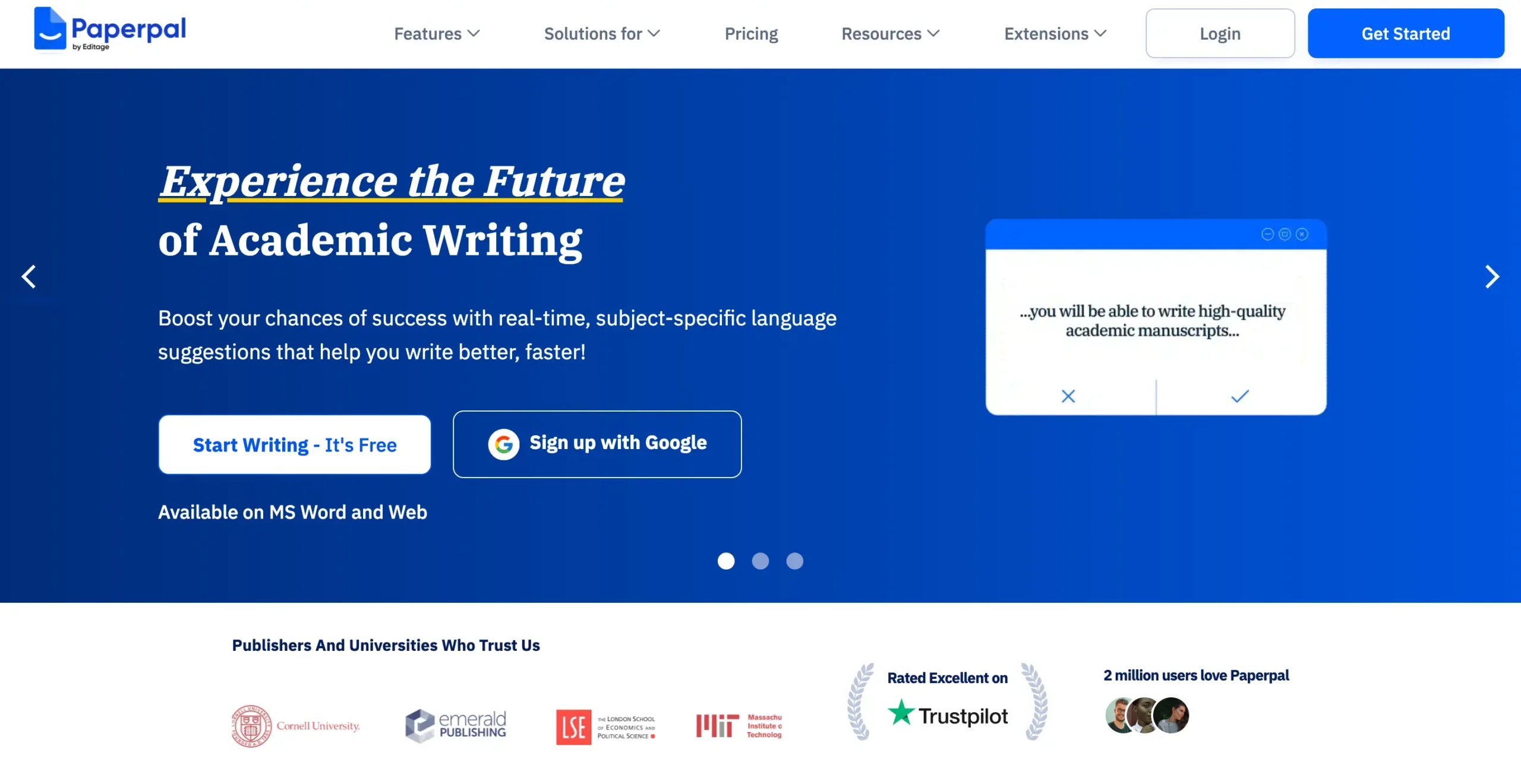
Pros
Cons
Paperpal is an AI research paper writer, but it is much more than that — a complete academic writing assistant and my top recommendation for anyone who takes research seriously.
This matters because most AI writing tools lie. They promise academic excellence and deliver corporate nonsense dressed in scholarly clothes.
Paperpal built its system on twenty-two years of actual publishing data. Real papers. Real citations. Real academic standards.
The difference shows immediately.
Paperpal does what academics need: writes papers, checks grammar, finds sources, formats citations, and catches plagiarism.
It does not pretend to cure loneliness or revolutionize human thought.
Once you sign up and complete the onboarding process, you see a dashboard page like this:

Clean. Simple. No bright colors or animated distractions. The easiest way to start is to click “New Web Document” on the dashboard home page.
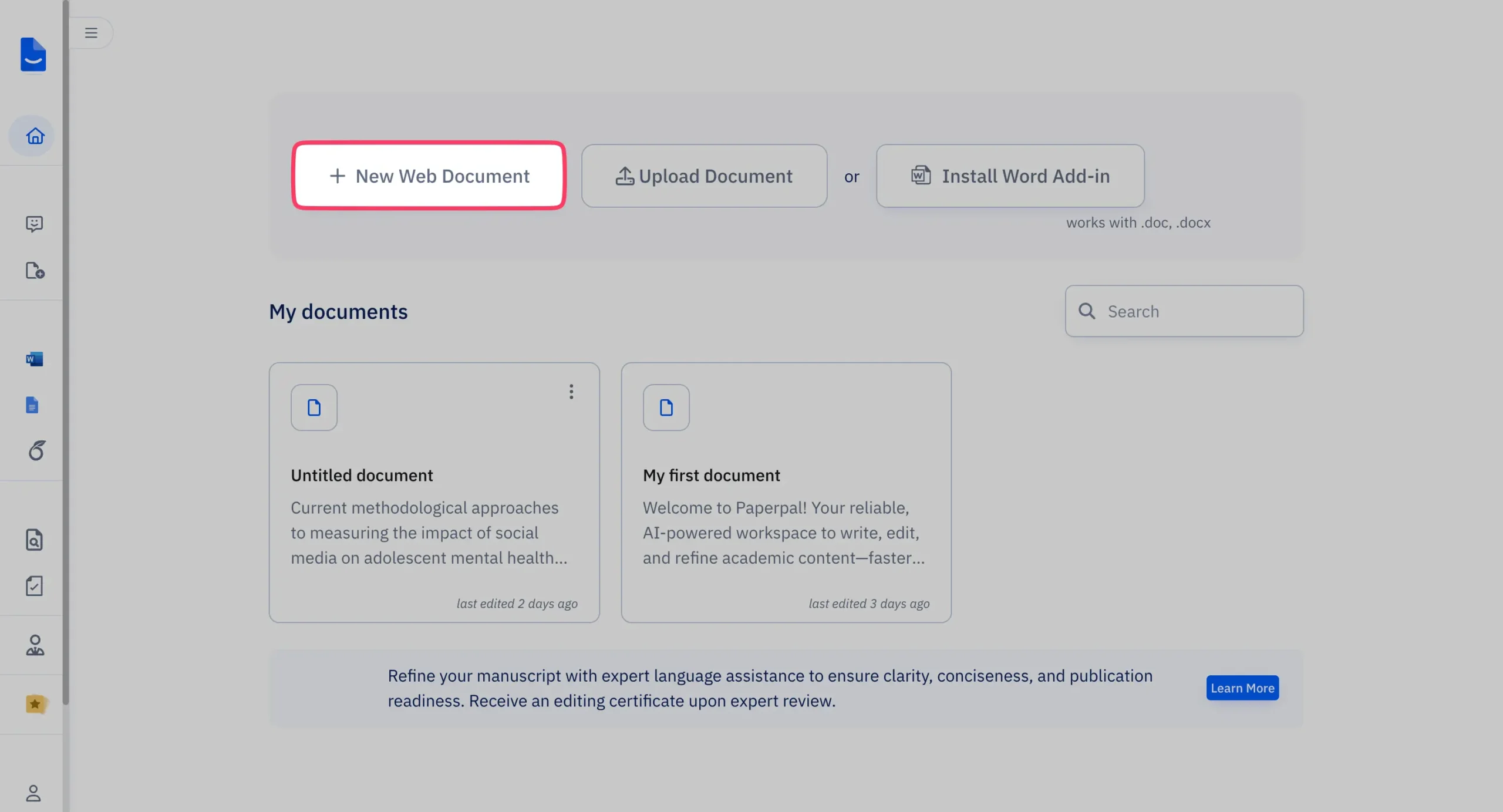
You are forwarded to a blank document, the main Paperpal editor, where you will spend most of your time.

You see three panels: a collapsible sidebar, the main editor, and a feature panel on the right. Everything has its place. Nothing fights for your attention.
The right sidebar gives you access to all the important Paperpal features.
Paperpal works inside Microsoft Word, Google Docs, and Overleaf through dedicated add-ins. Write in your preferred environment. The AI suggestions appear in real-time.
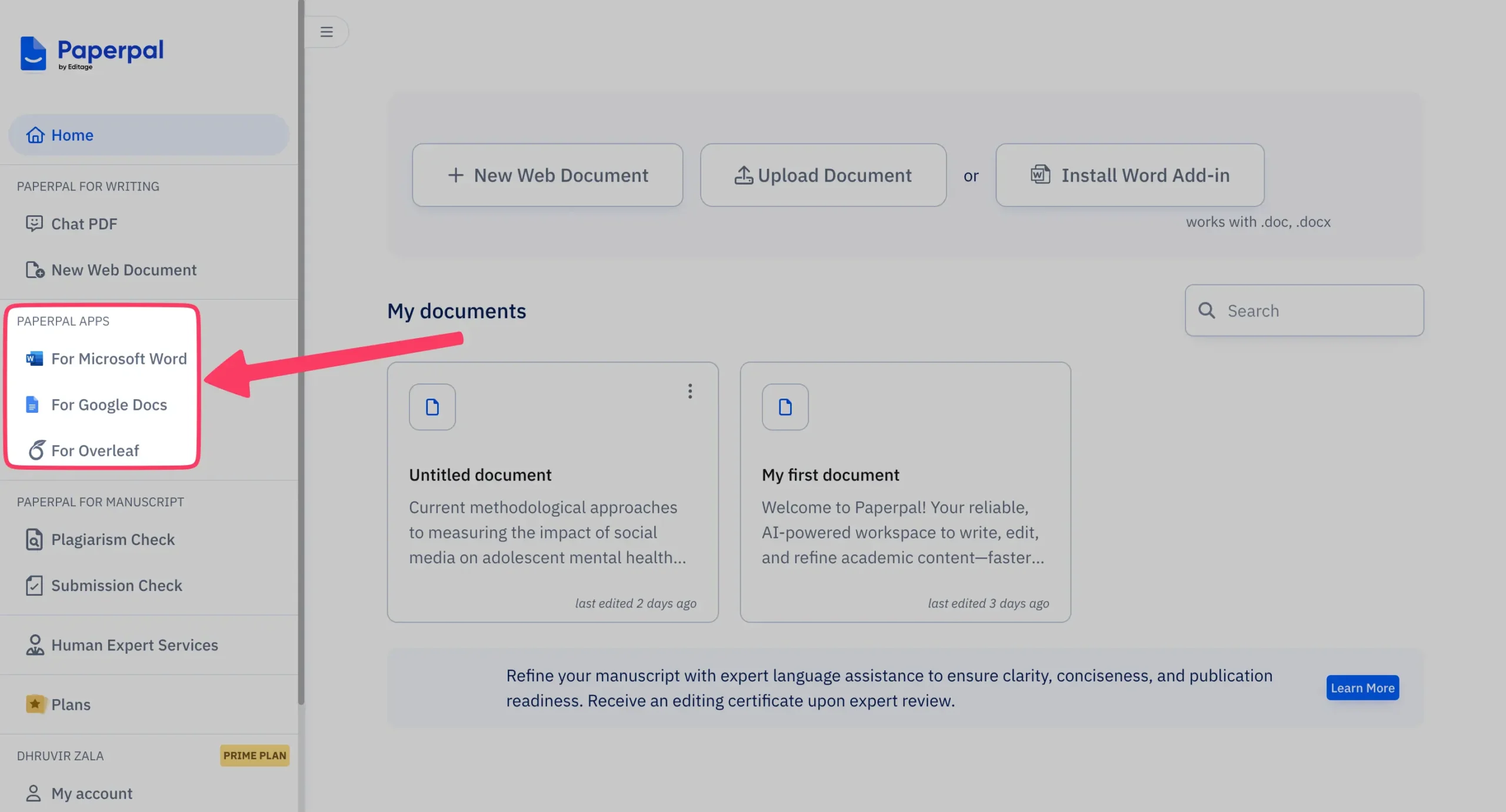
For those who stare at blank pages in terror, Paperpal offers templates.

Research outlines, grant proposals, and academic emails. Basic but functional.
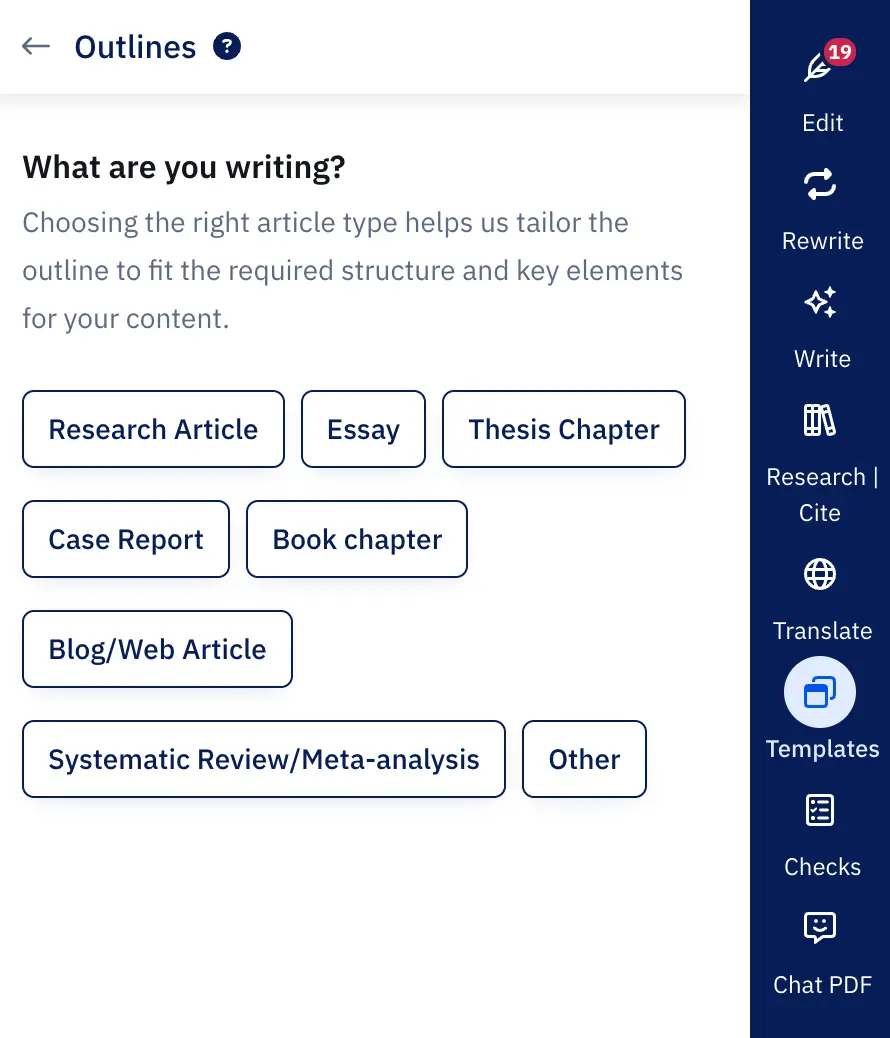
Let's say I want to create an outline for an essay.
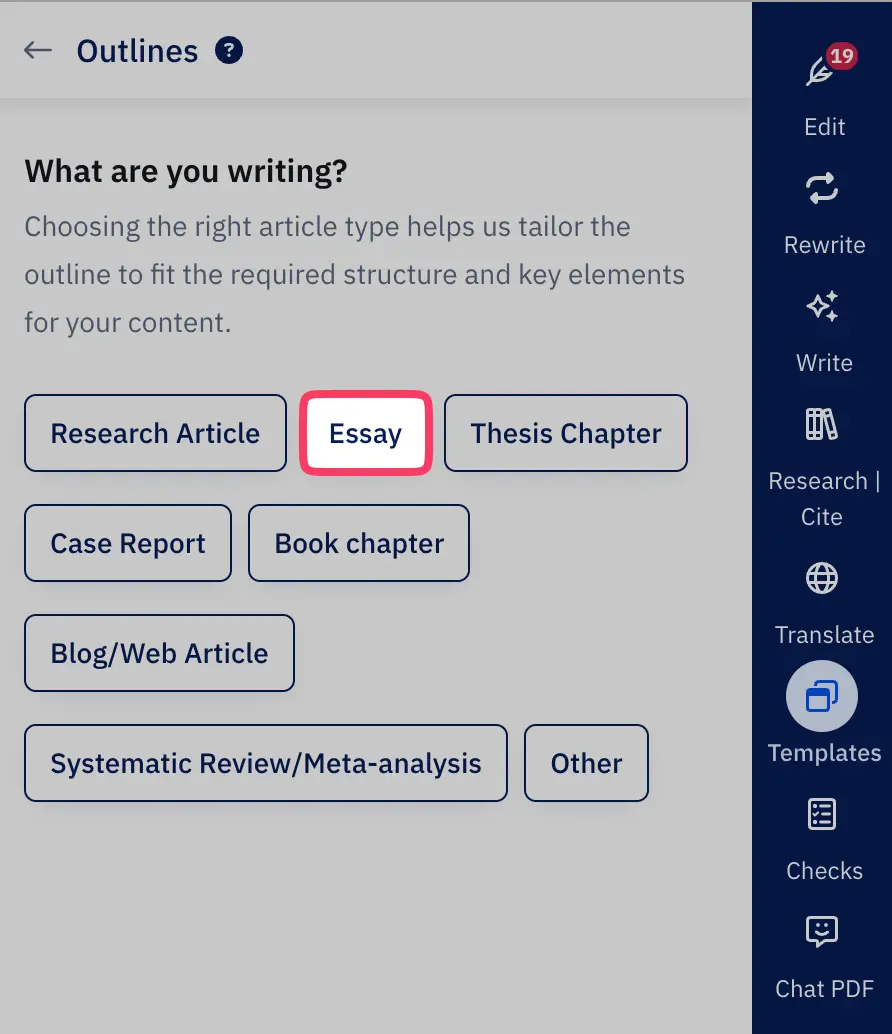
Paperpal asks for my essay's subject area, then asks me to describe the topic briefly.
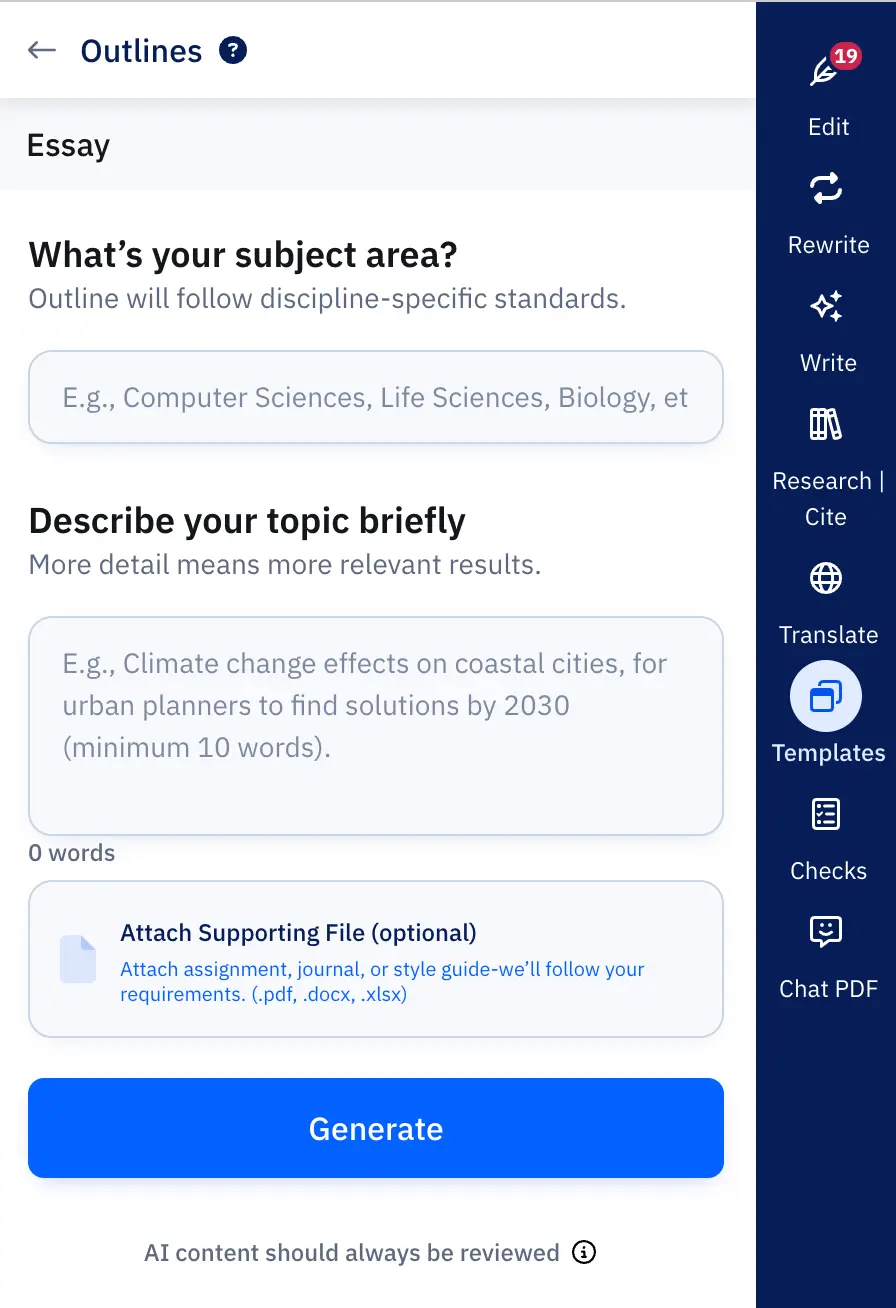
I tested the essay outline generator with this prompt:
Subject area: Digital Technology and Society
Describe your topic briefly: The impact of artificial intelligence on employment patterns in developed economies: examining both job displacement in traditional sectors and the emergence of new categories of work, with a focus on policy recommendations for workforce transition and retraining programs.
Once I hit 'GENERATE', Paperpal immediately starts generating a detailed outline with main headings and sub-points.
Logical flow. Proper academic organization. A solid framework for actual thinking.
Click “New Web Document” and you get a blank page. Type normally until you need help, then press '/'. The AI appears.
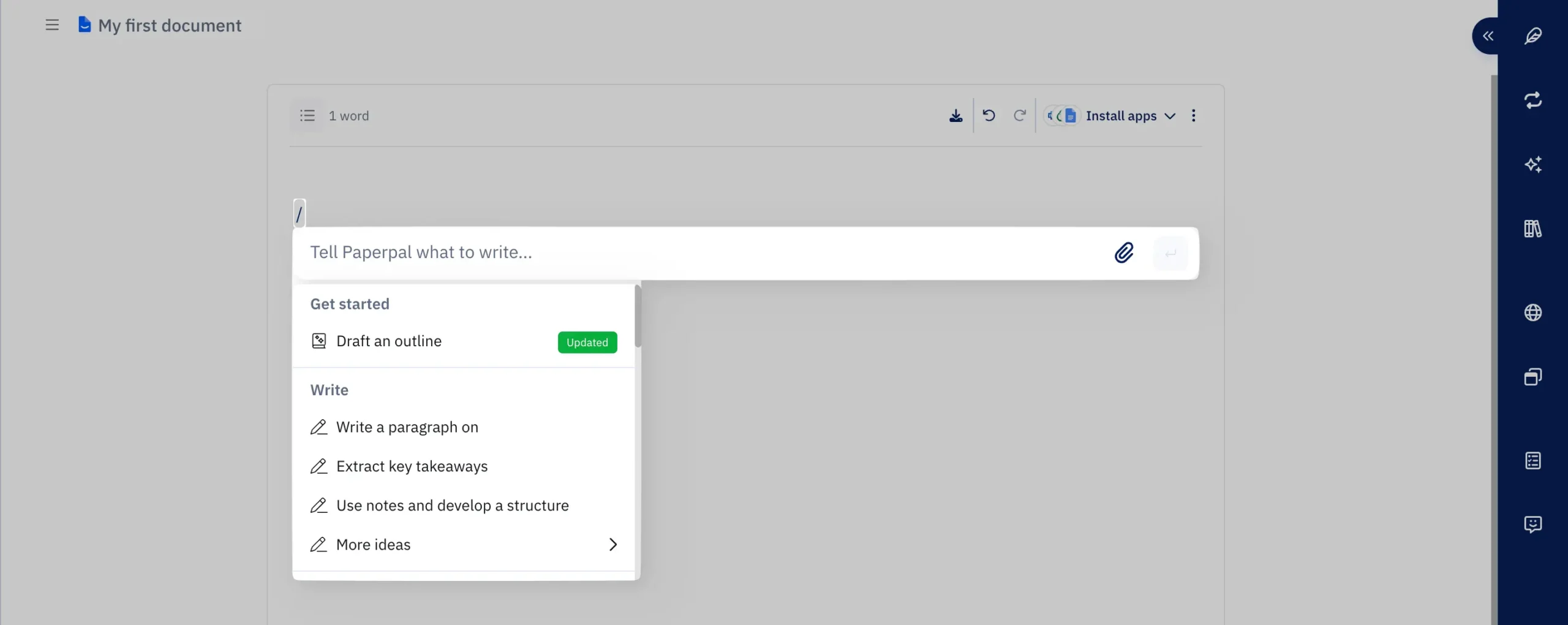
Ask Paperpal to write a paragraph about unemployment in the digital age. It produces academic prose with proper structure and reasonable arguments. Ask it to rewrite your clumsy sentence.
It returns something clearer.
Paperpal understands academic writing because it learned from academic writing. This seems obvious until you try other tools trained on internet garbage.
Type a question about your research topic. Papepal's 'Research | Cite' feature searches its database of papers and returns answers with proper citations attached.
You can search for research papers by keyword, title, or DOI. The system connects to real research papers, not Wikipedia summaries or blog posts.
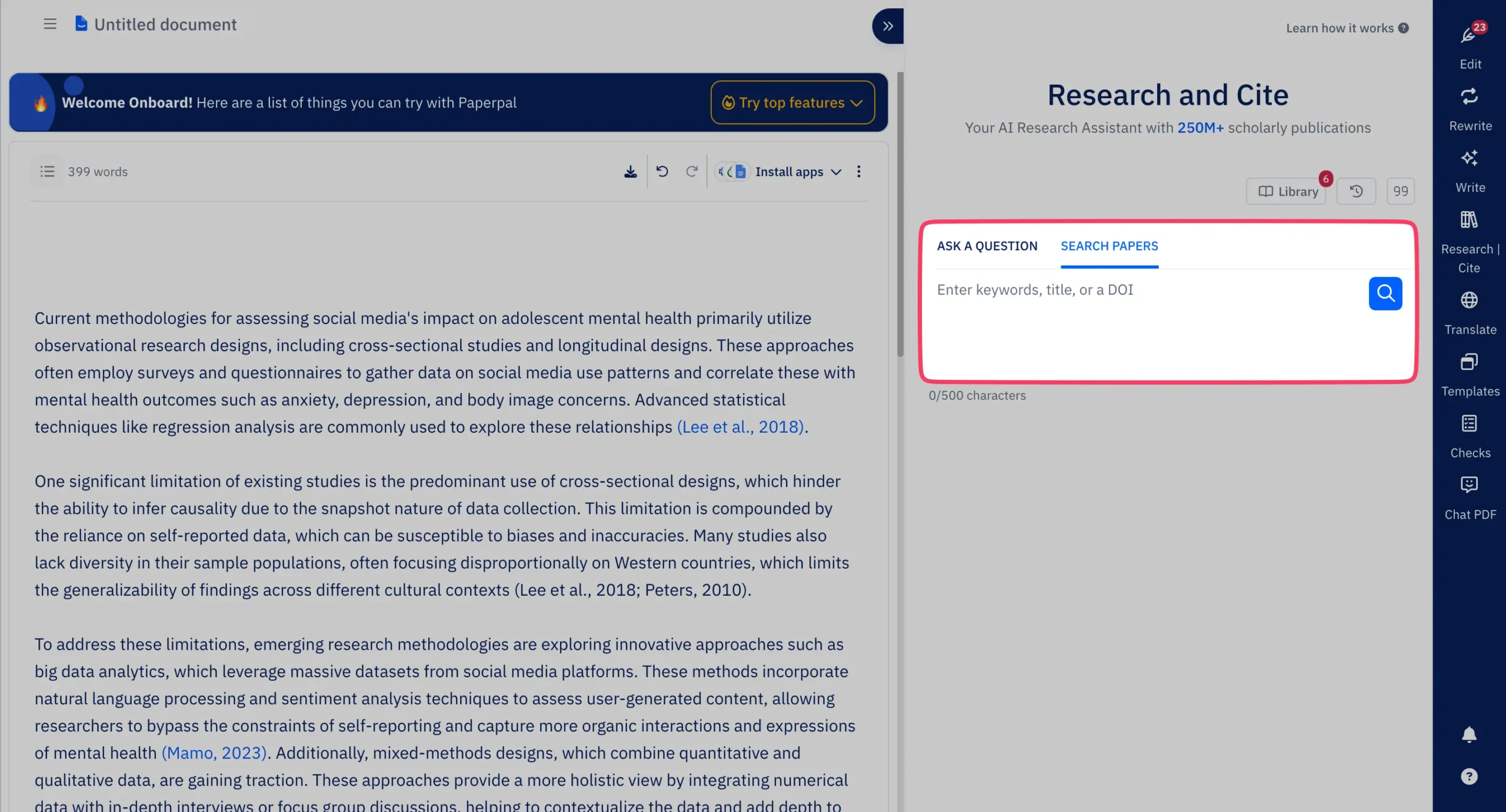
Citation formatting covers 10,000+ styles. Pick your journal's requirements and forget about it.
Moving ahead, Paperpal has a Chat PDf feature.
Upload a research paper inside Chat PDF. Paperpal reads it, summarizes it, and answers questions about it.

Highlight confusing passages and ask for explanations. This feature works. I tested it with a dense business paper. Paperpal correctly identified the main arguments and explained technical concepts in plain language.
Before submission, Paperpal enables you to run three checks.
1. Plagiarism detection compares your work against published sources.
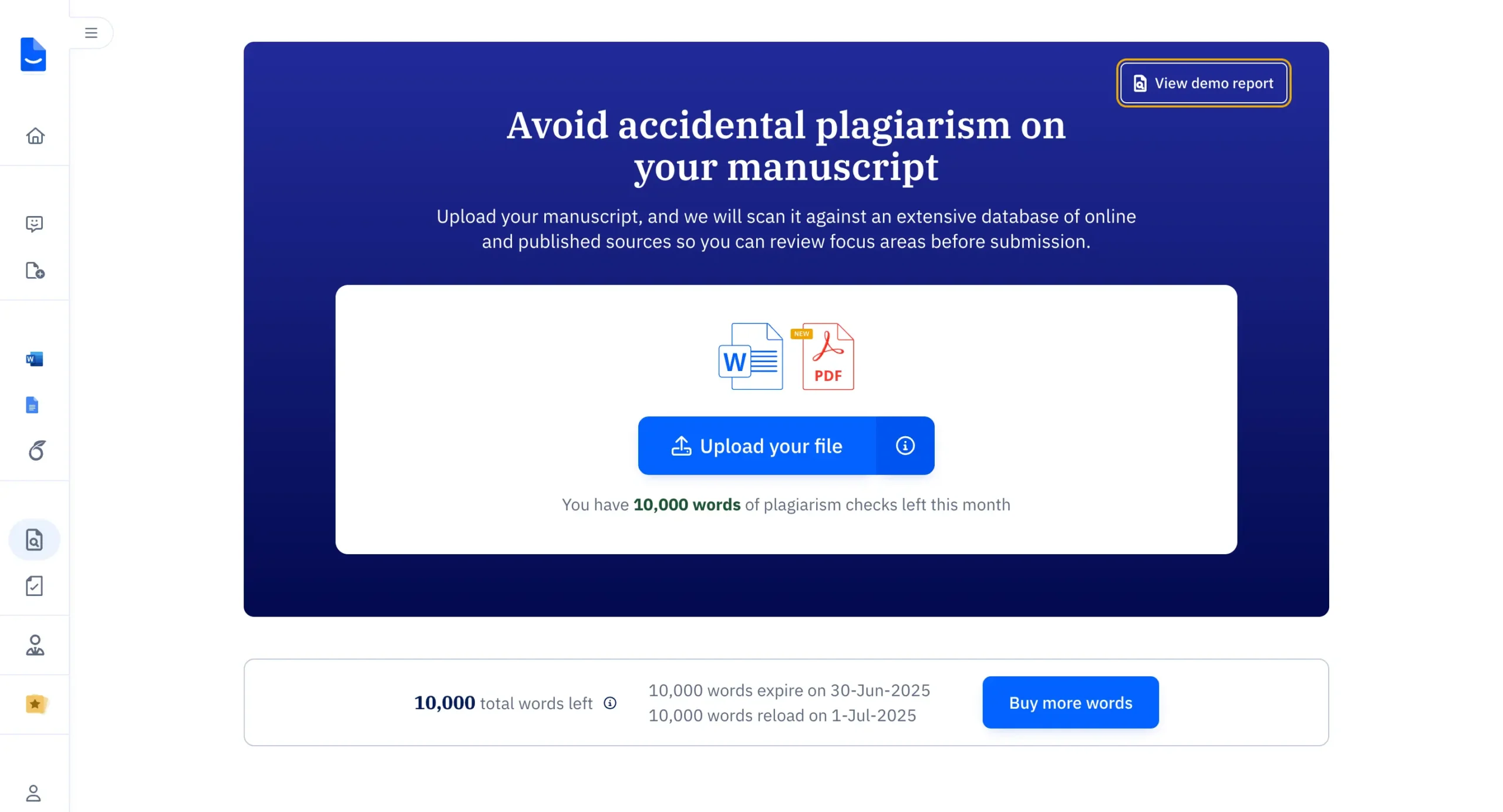
2. Journal submission check ensures your paper meets specific journal requirements.
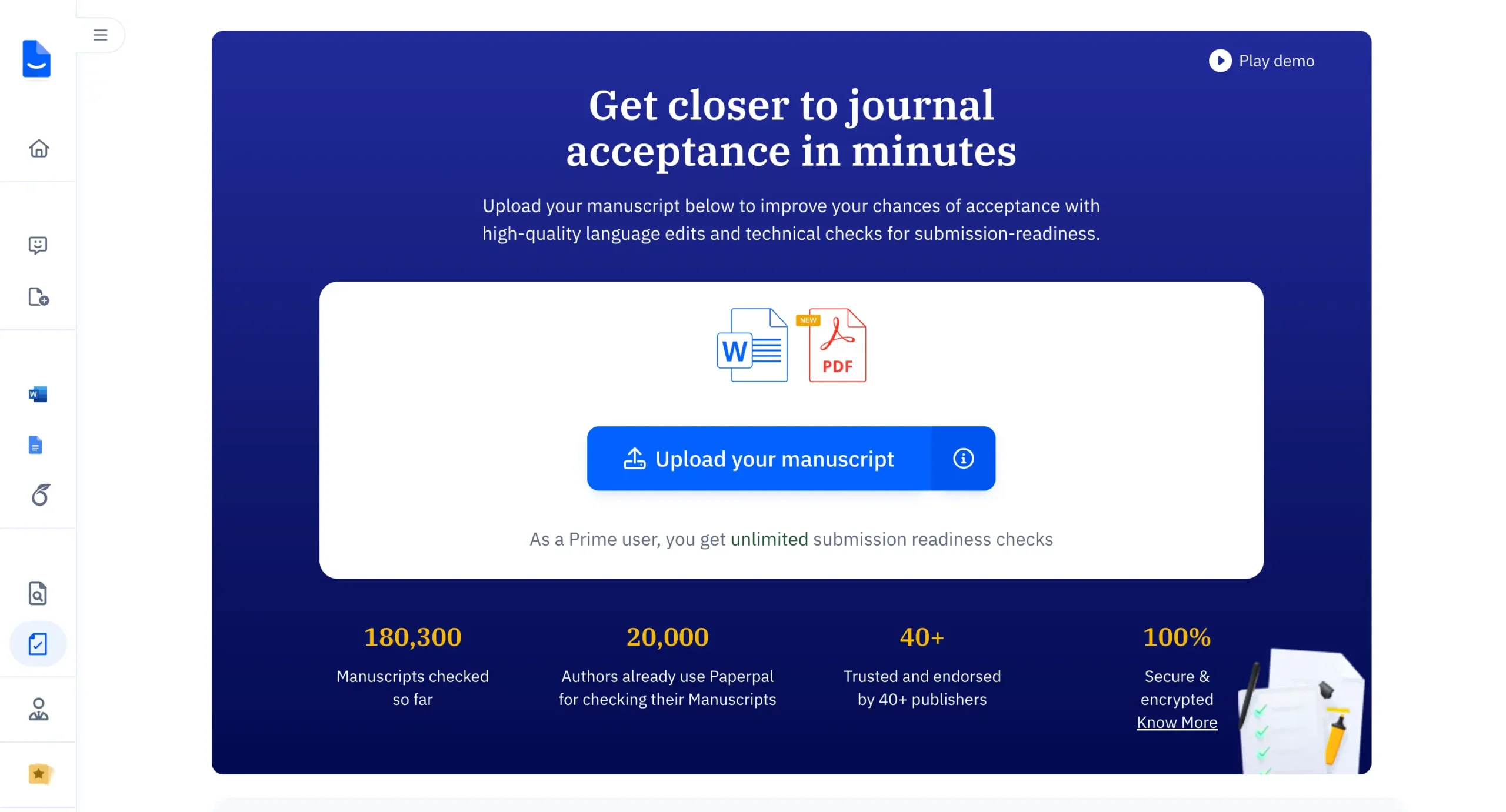
3. AI review provides feedback on structure and argument strength.
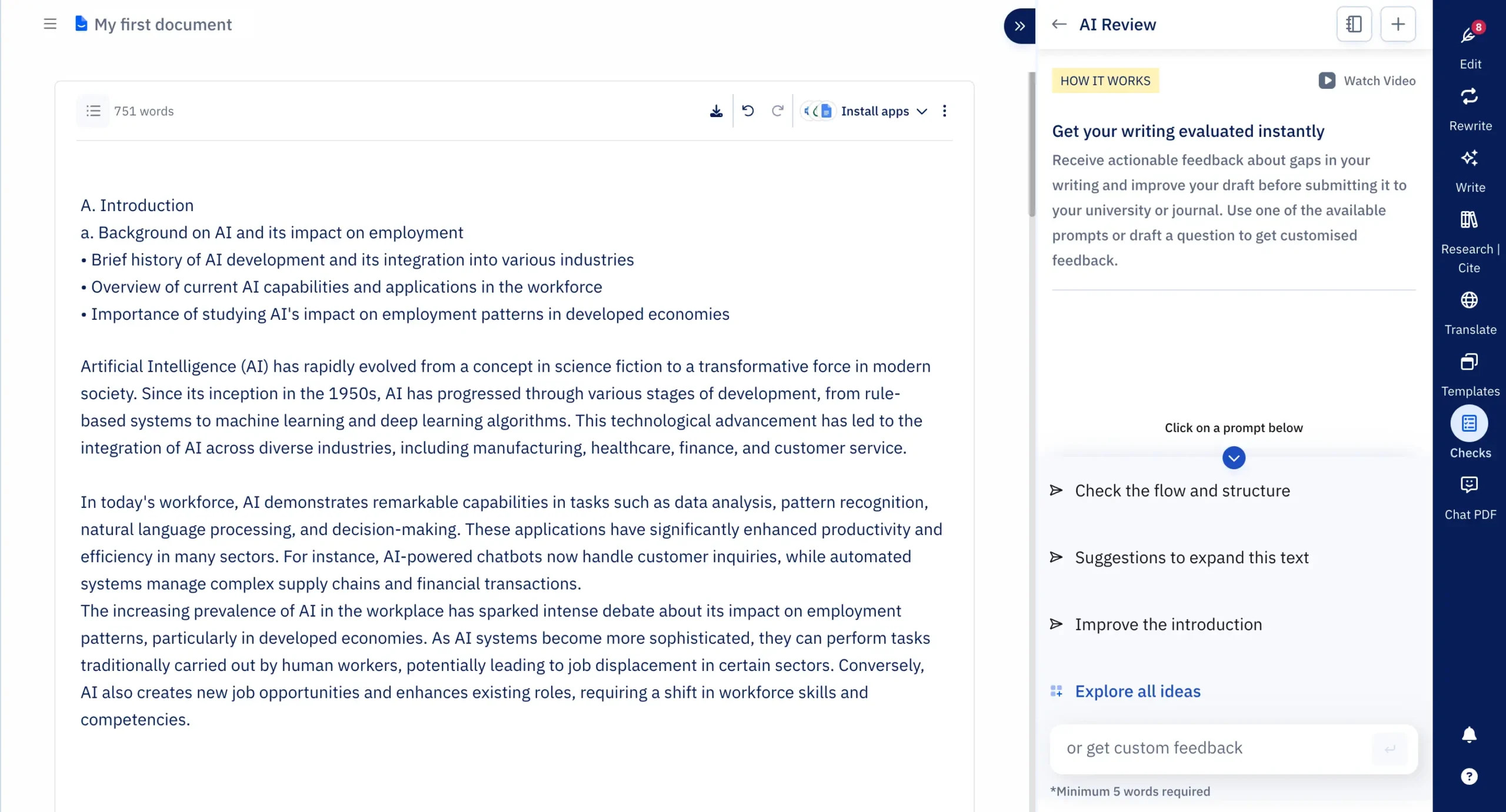
You can even hire a human expert editor affiliated with Editage (Paperpal's parent company) for assistance.
These checks catch problems before editors do.
Paperpal succeeds because it solves actual problems without pretending to be more than it is.
Graduate students struggling with thesis chapters will find genuine help. Non-native English speakers can write with confidence. Researchers can locate sources and format citations correctly.
It costs money but saves time. For serious academic work, this trade makes sense.
Most importantly, Paperpal will not write your paper for you. It will help you write it better. The thinking remains yours.
Pricing
Paperpal costs $25 monthly, $55 quarterly, or $139 yearly. The yearly plan saves money.
Simple math: $139 yearly equals $11.58 monthly, versus $25 for a month-to-month payment.
You can get 30% off your first payment. My discount code cuts the annual plan to $97.30. This beats paying $25 monthly for four months.
Here's what the money buys:
How to get the discount?
Visit my Paperpal discount link. Sign up for an account. Click Plans in the left menu. Choose your payment option. Enter code DZ30 at checkout.
Confused? Learn exactly how to avail the discount here.
The 30% discount applies to the first payment only. After that, you pay the regular price.
Paperpal charges fairly for what it delivers. The free version proves the tool works. Prime unlocks everything you need for serious academic writing.
#2 — SciSpace
Available on: Web, Chrome extension, iOS (iPhone and iPad)

Pros
Cons
SciSpace builds tools for academic research and writing.
Like Paperpal, SciSpace offers AI tools for academic research, including a literature review generator, Chat with PDF, a dedicated AI writer, topic finder, paraphraser, citation generator, AI detector, and a PDF-to-video converter.
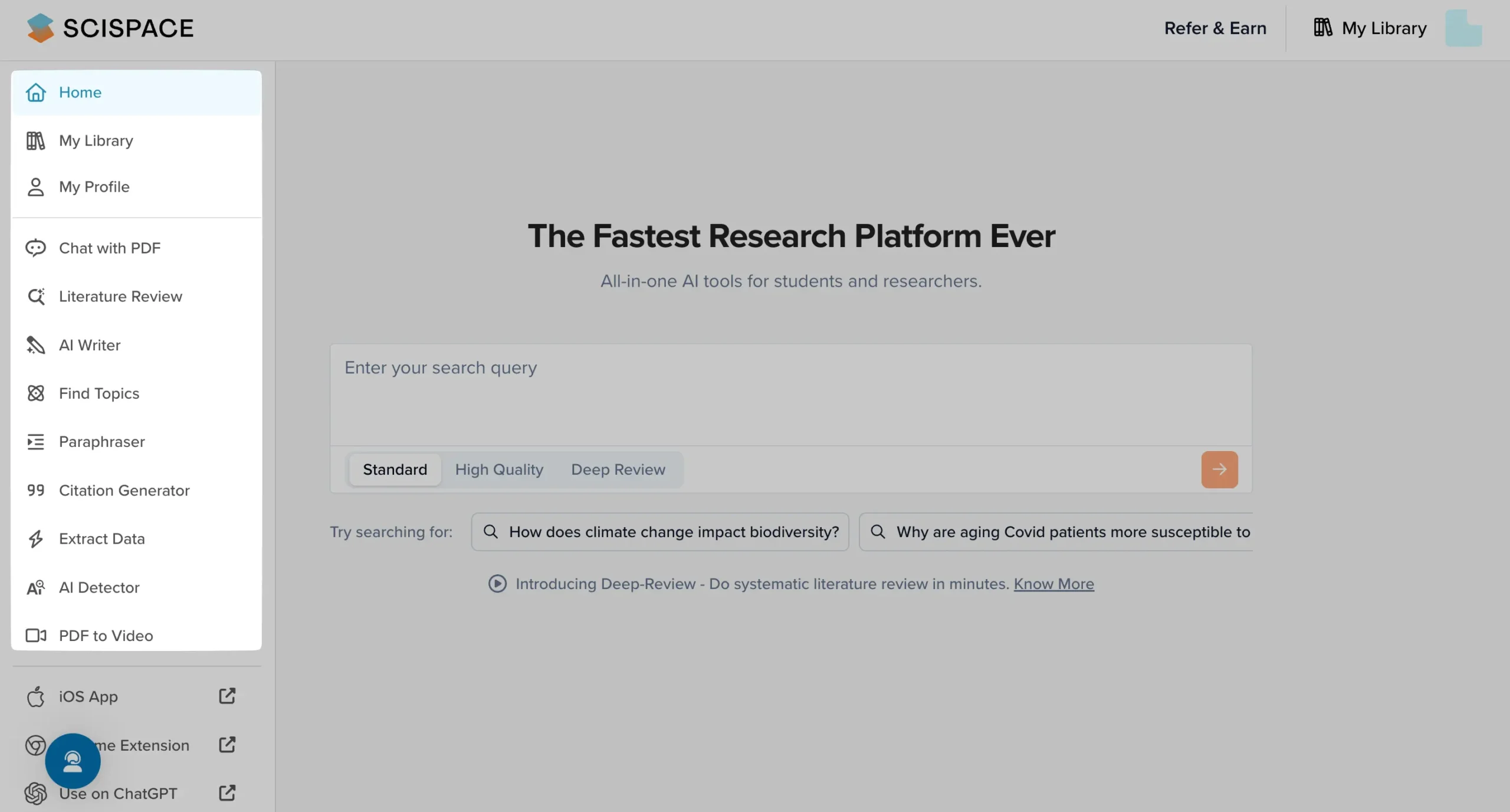
We must test three features: their AI writer, Chat with PDF, and Literature Review.
Let's begin with SciSpace's literature review capabilities.
Access it from the homepage or through the left sidebar.
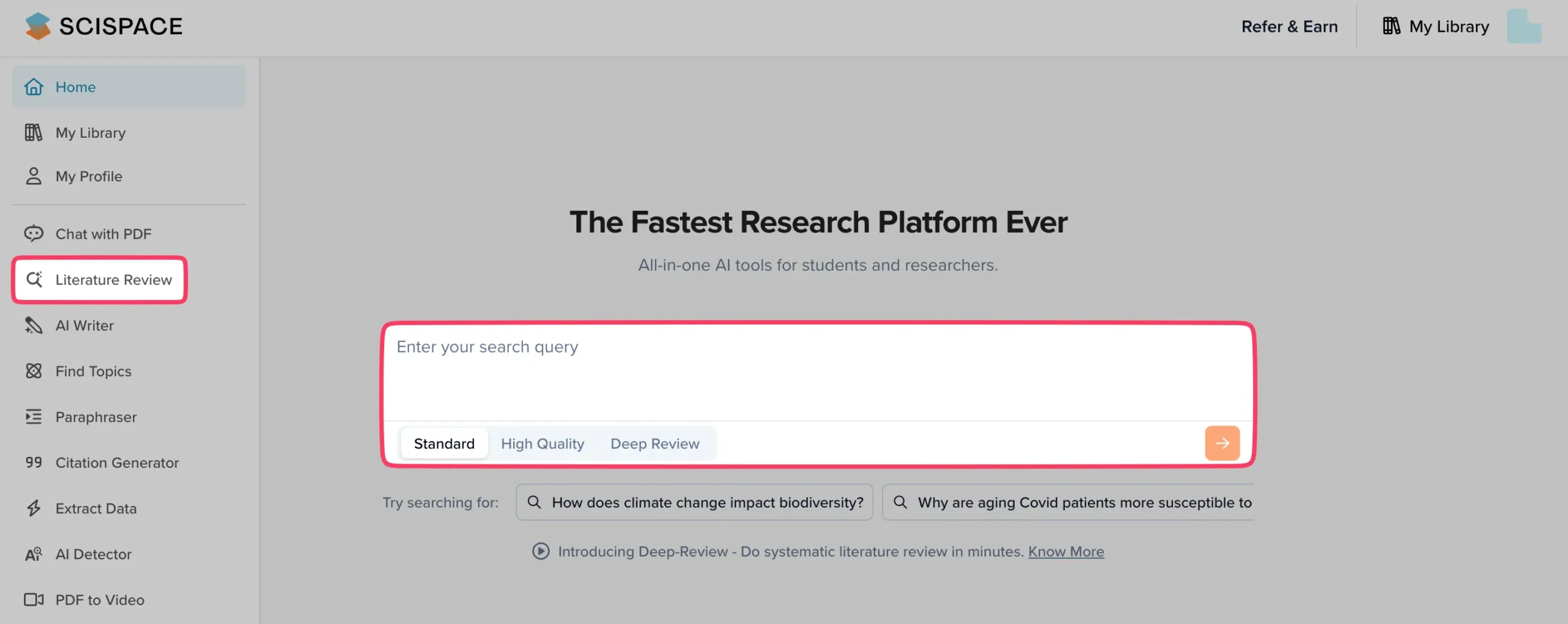
SciSpace's Literature Review has three search modes:
- Standard (free plan users)
- High Quality (Premium plan users)
- Deep Review (Advanced plan users)
I tested all three modes with this prompt:
"Review the last ten years of research on active learning in undergraduate science education. Find what works, what doesn't, and what we still don't know. Use at least twenty studies. Tell me straight."
SciSpace's Standard mode returns answers from up to 10 papers within seconds. You get summary paragraphs, effective active learning strategies, challenges and limitations, and areas for further research.
Like Paperpal's text insertion feature, SciSpace lets you 'Save to Notebook.'
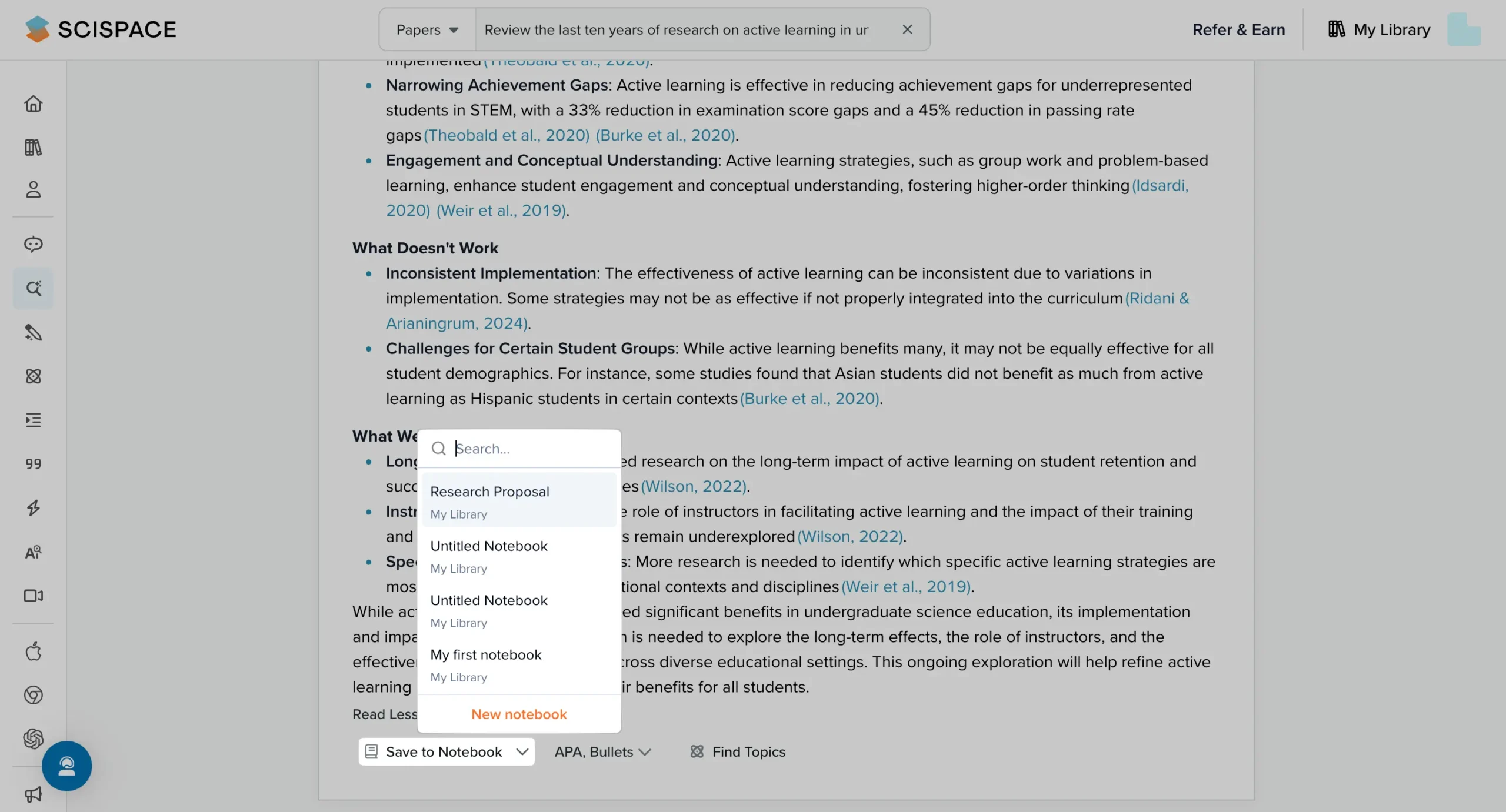
SciSpace's most powerful feature appears below the output: the AI-powered dynamic table.
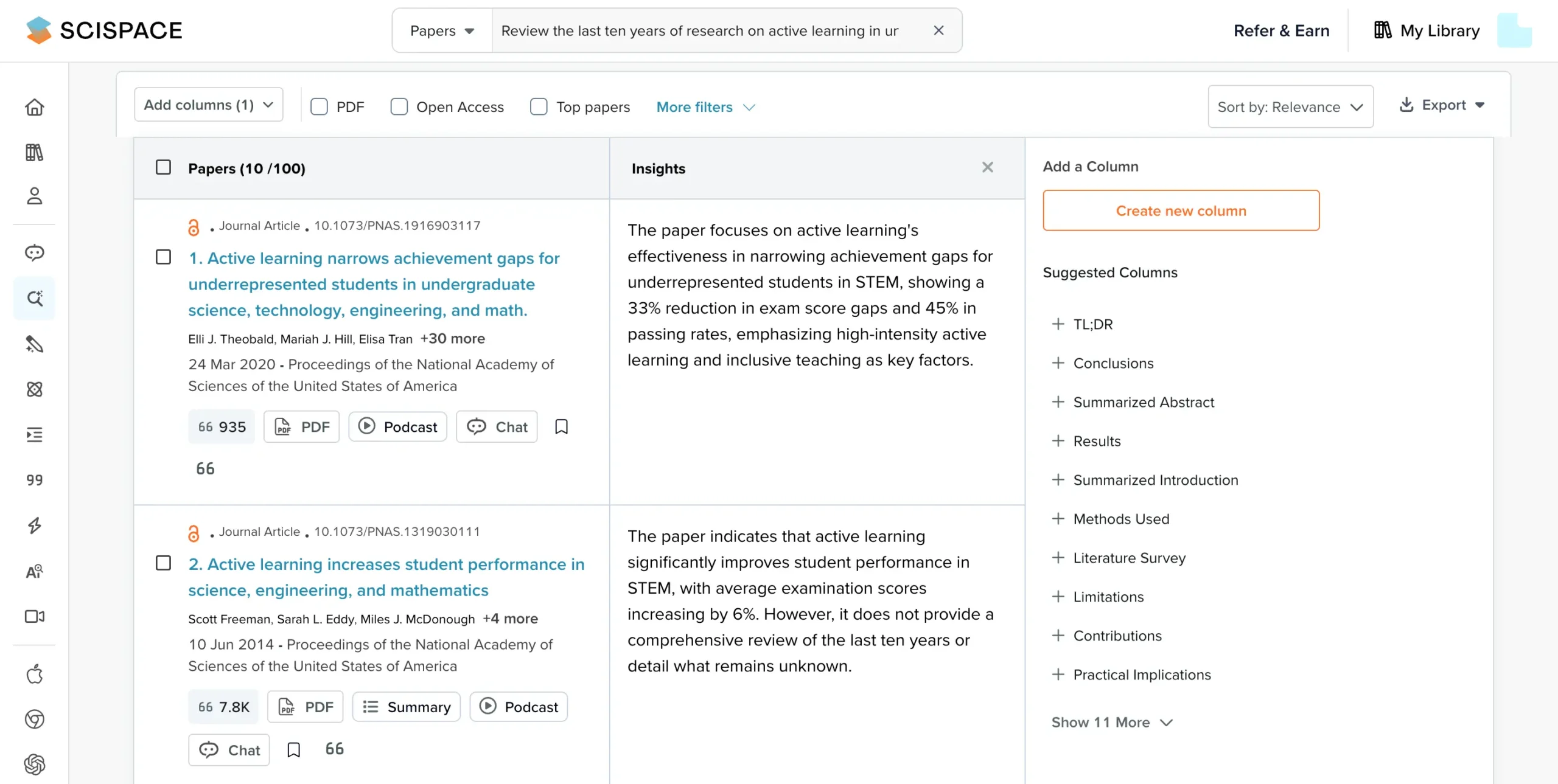
By default, it shows the top 10 papers with two columns: Paper details and Insights.
On the right, you can add columns for TL;DR, Conclusions, Limitations, and more.
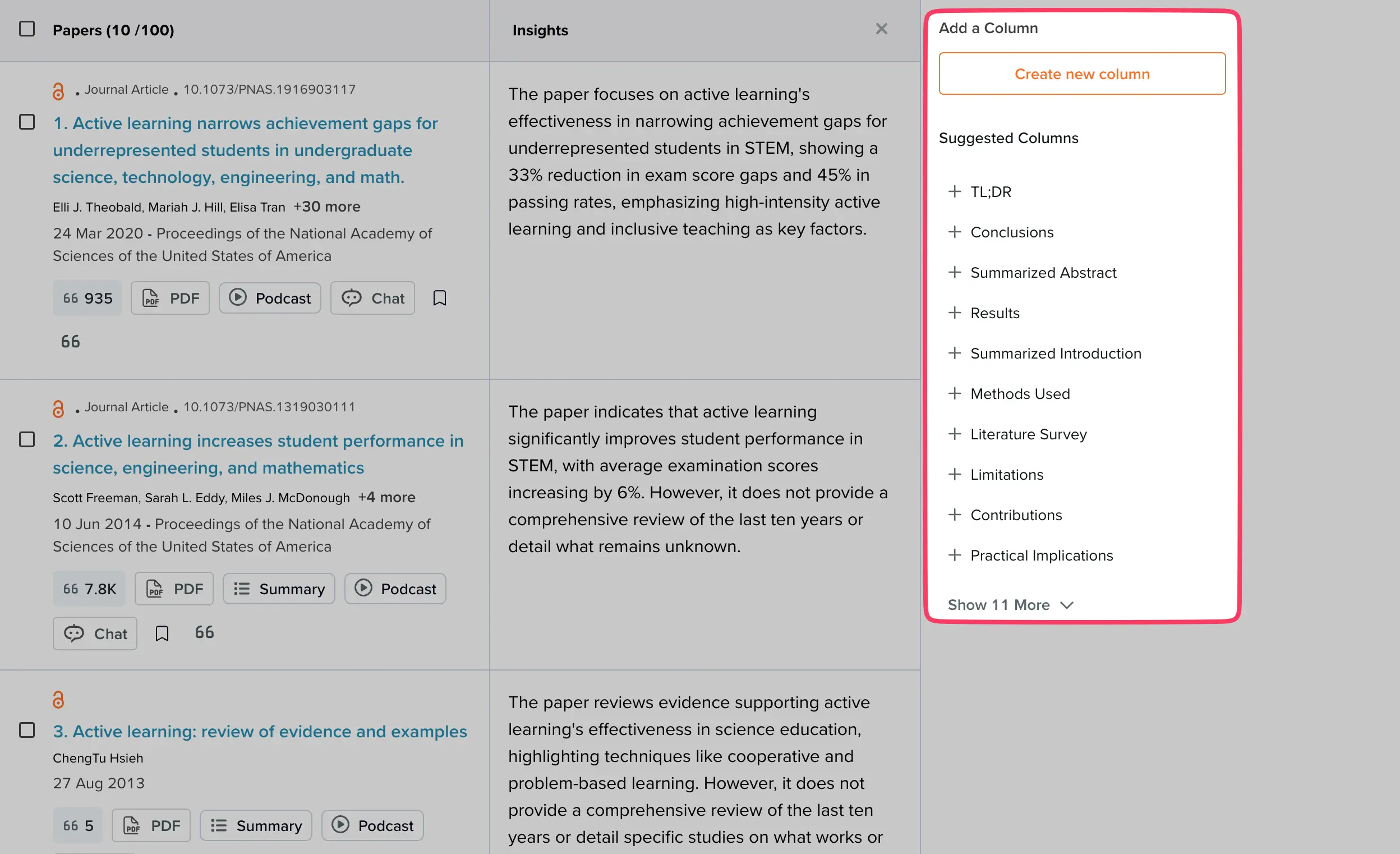
The AI populates new columns automatically.
This works well.
You can load up to 100 papers in this table.
Below the table, you find 'Related Questions.'
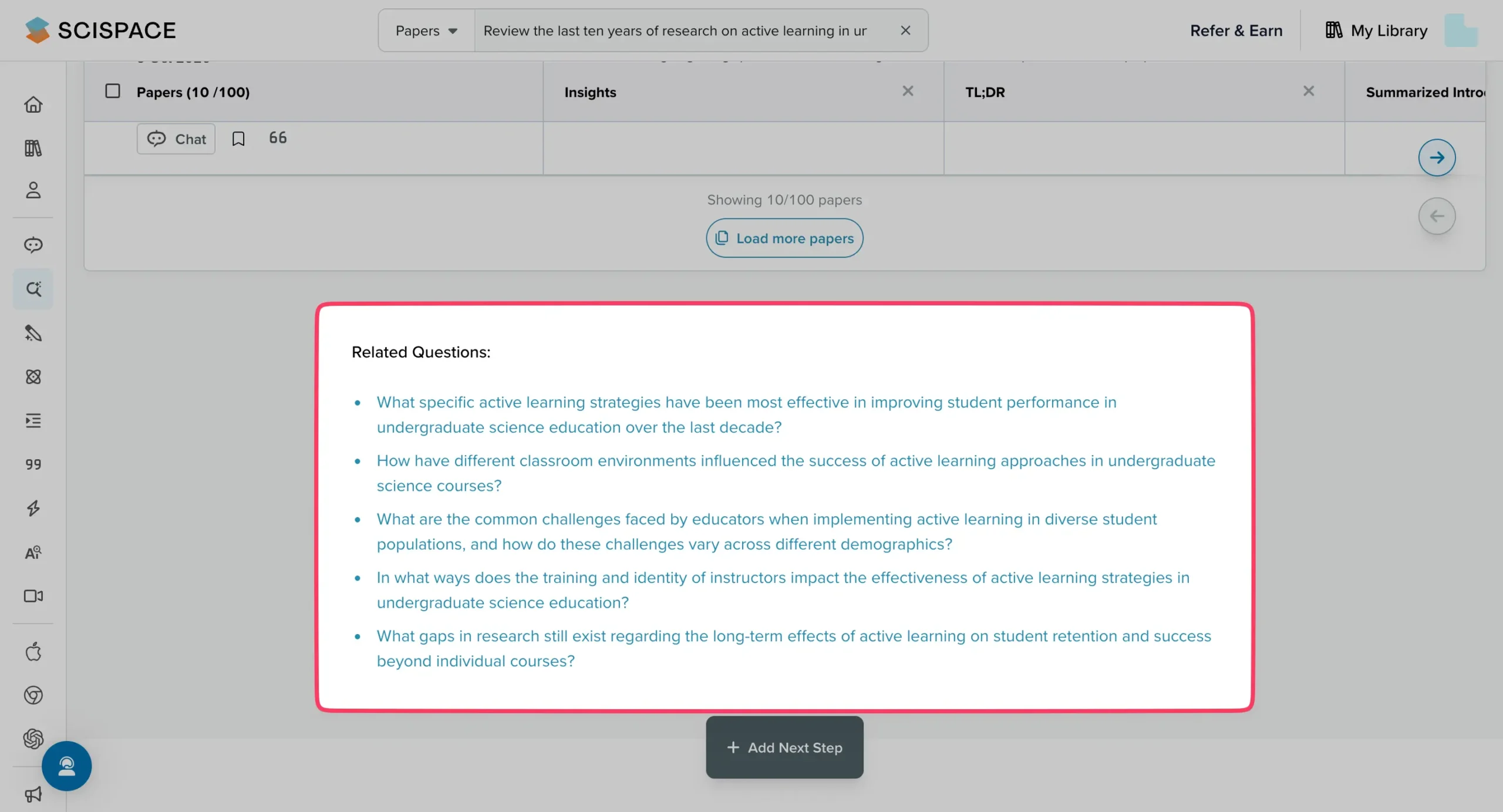
High Quality mode looks identical at first glance. Most of it is.
The output quality improves significantly. Inside the summary container, you see greater detail than Standard mode provides.
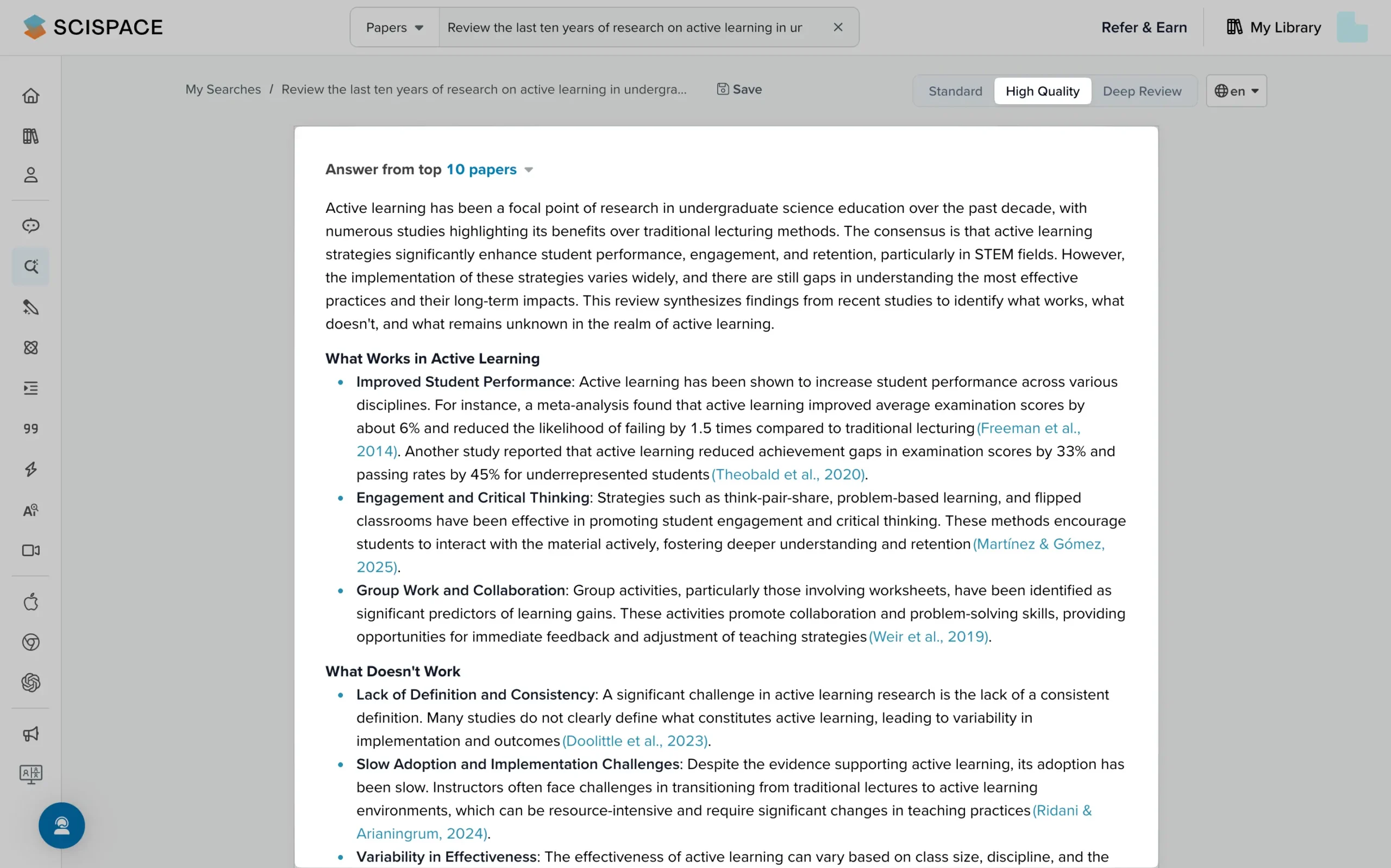
Everything else remains the same.
Deep Review mode works differently.
After entering your prompt, SciSpace enters deep thinking mode and asks clarifying questions.
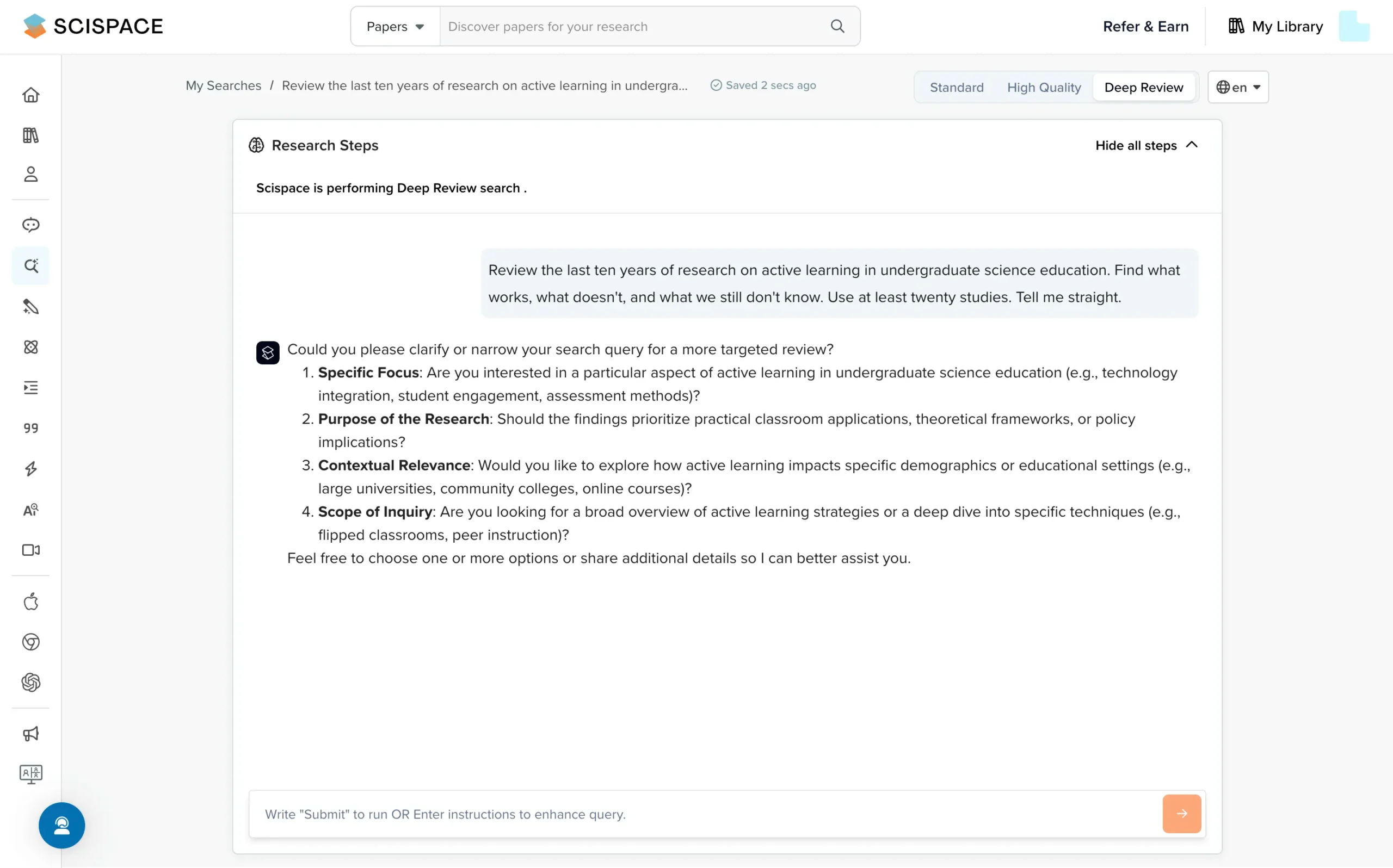
Once you answer, it begins the necessary steps.
After finishing all tasks (this takes several minutes depending on complexity), SciSpace reports how many papers it found from the total reviewed.
In my case, it found 325 relevant papers after reviewing 1,750 papers.
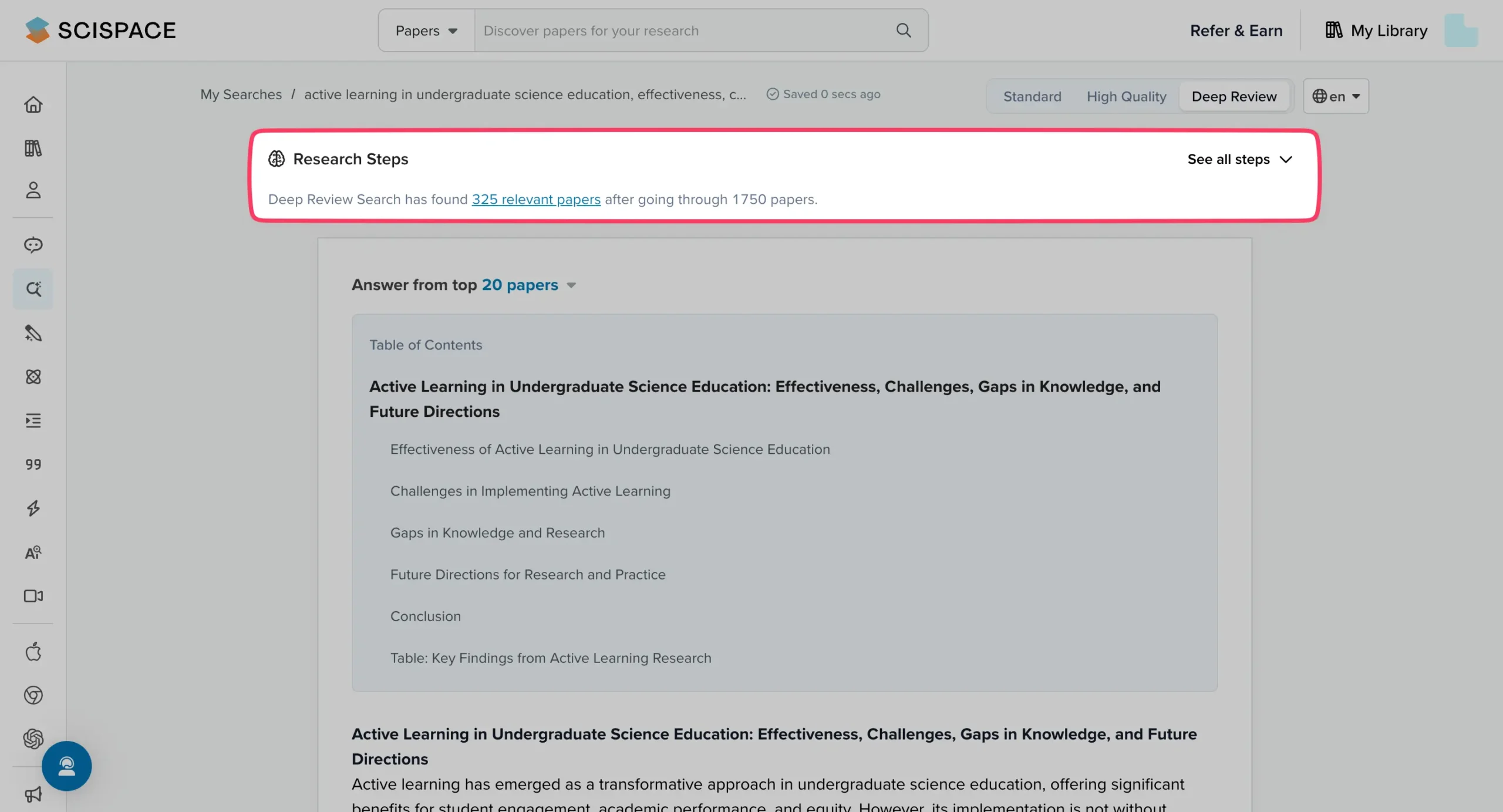
This took about three minutes.
Below, you see the usual elements: output summary from up to 20 papers, the dynamic table, and related questions.
This summary provides the most detail of all three search modes.
SciSpace's Literature Review feature works well.
Now let's test the AI writer.
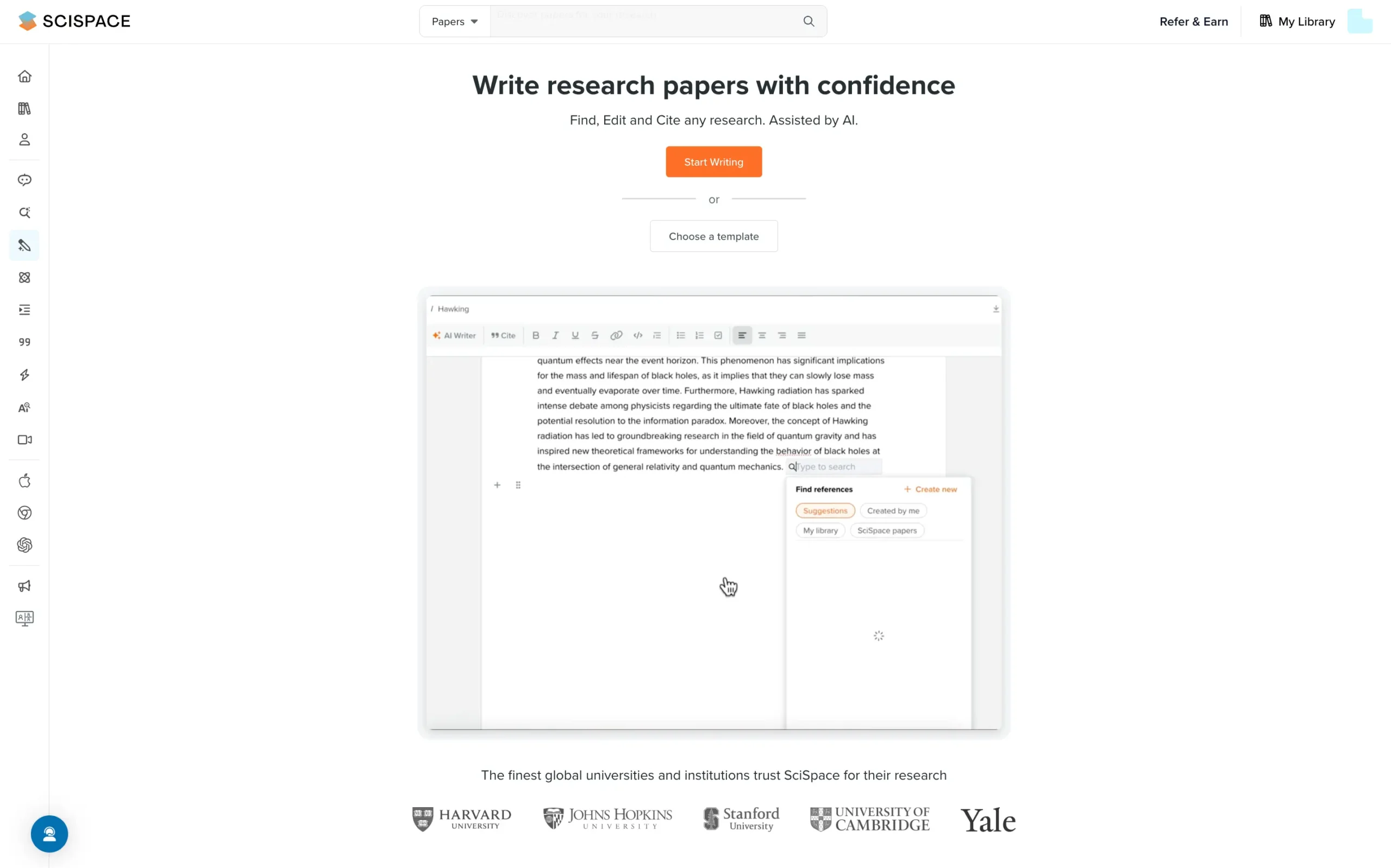
Click 'Start Writing' to open a blank text editor. Or click 'Choose a Template' for pre-built options:
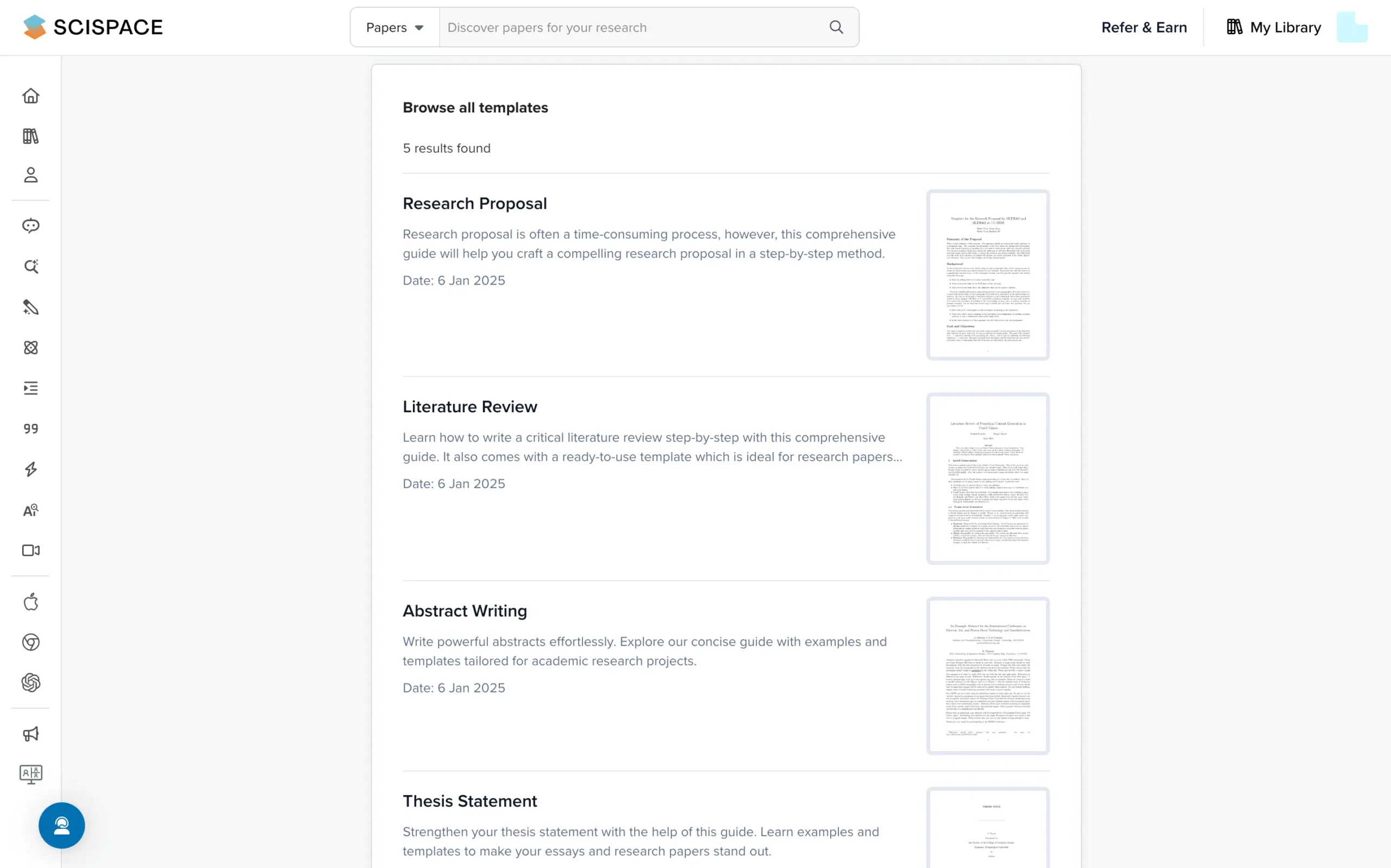
SciSpace's AI writer looks like this:
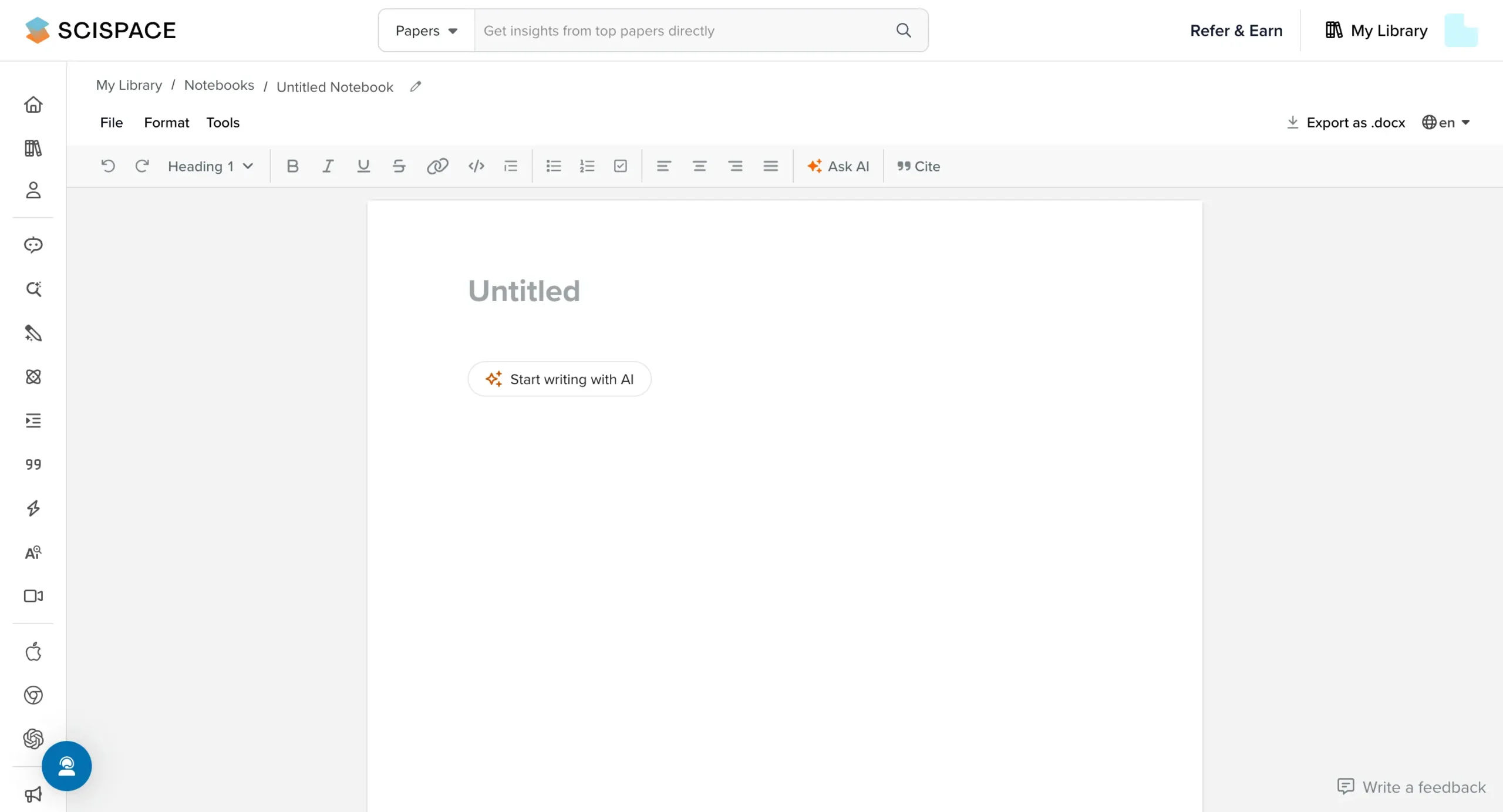
Clean and Google Docs-like.
Like Paperpal, press '/' to access all editor and AI functions.
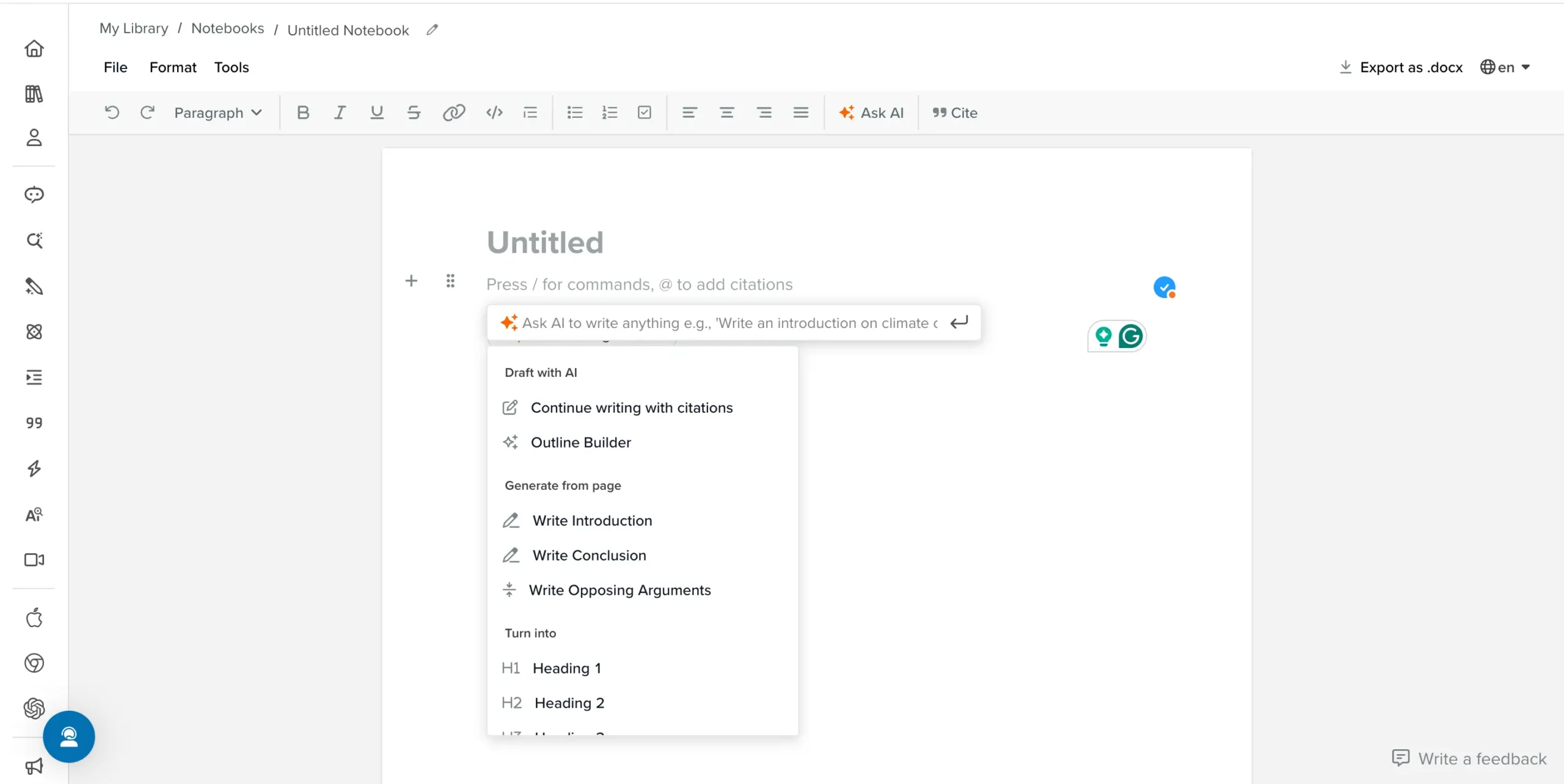
Use '@' to add citations.
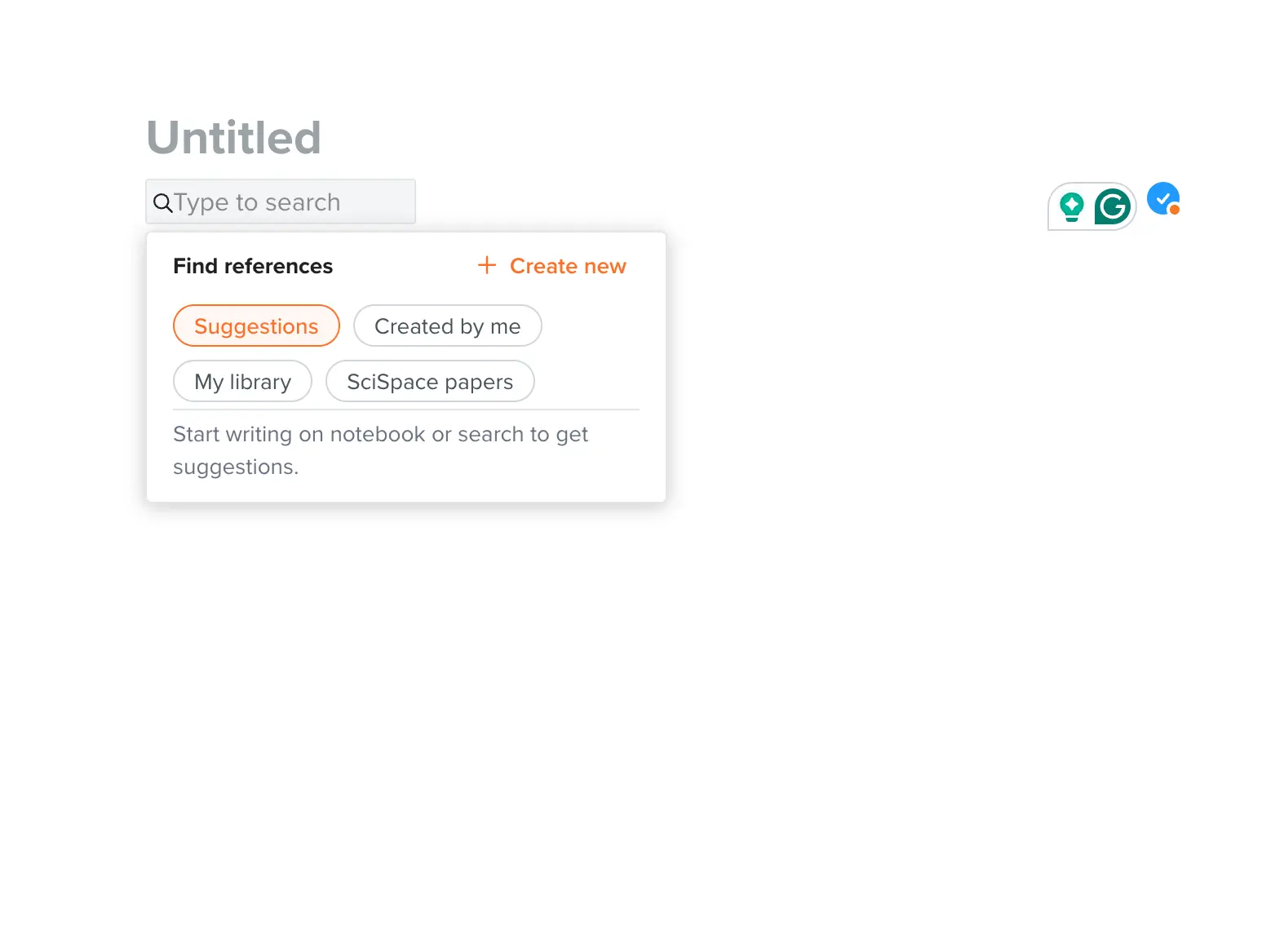
Standard formatting options appear at the top bar.
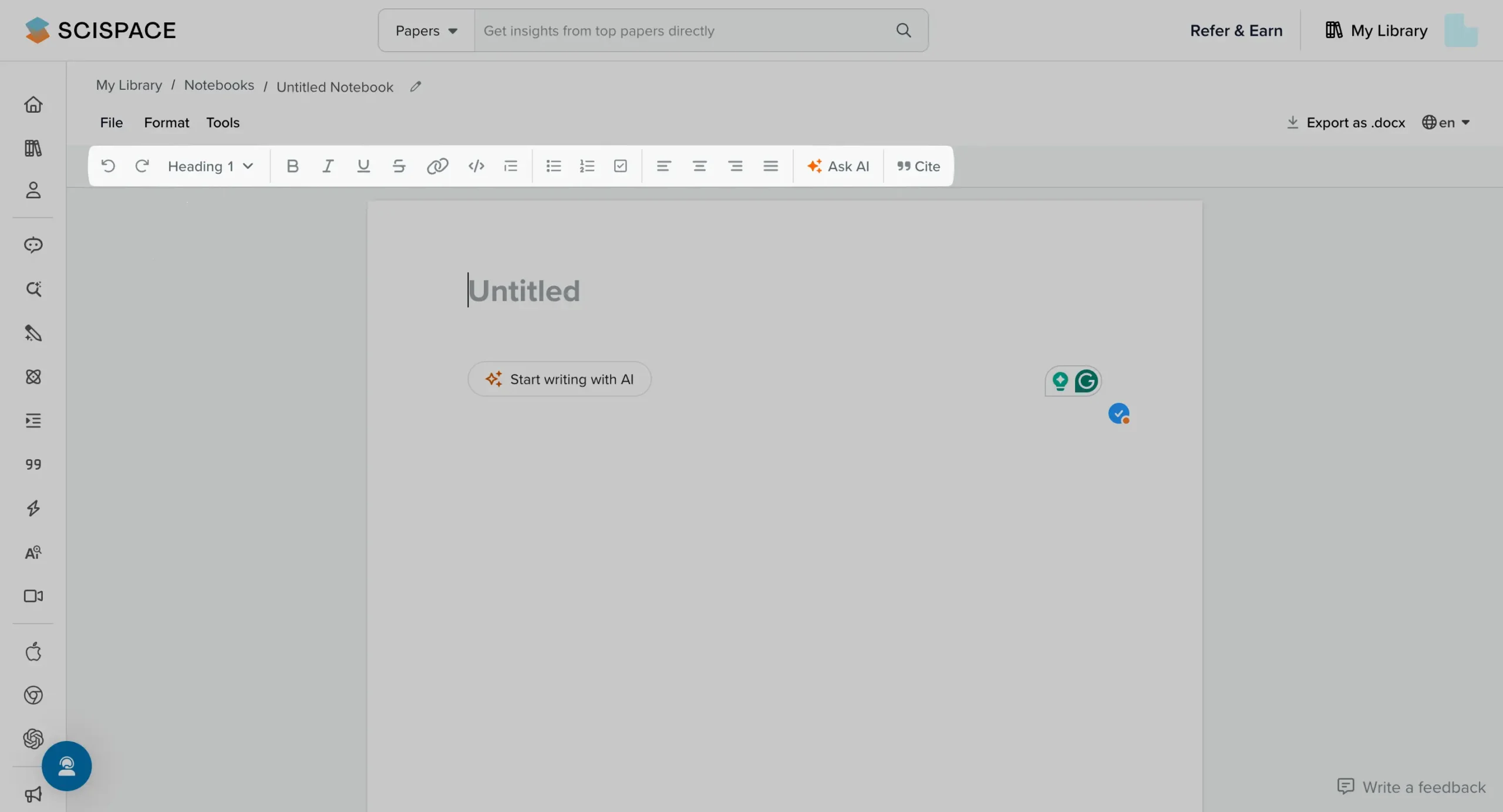
SciSpace's AI writer provides accurate auto-suggestions.
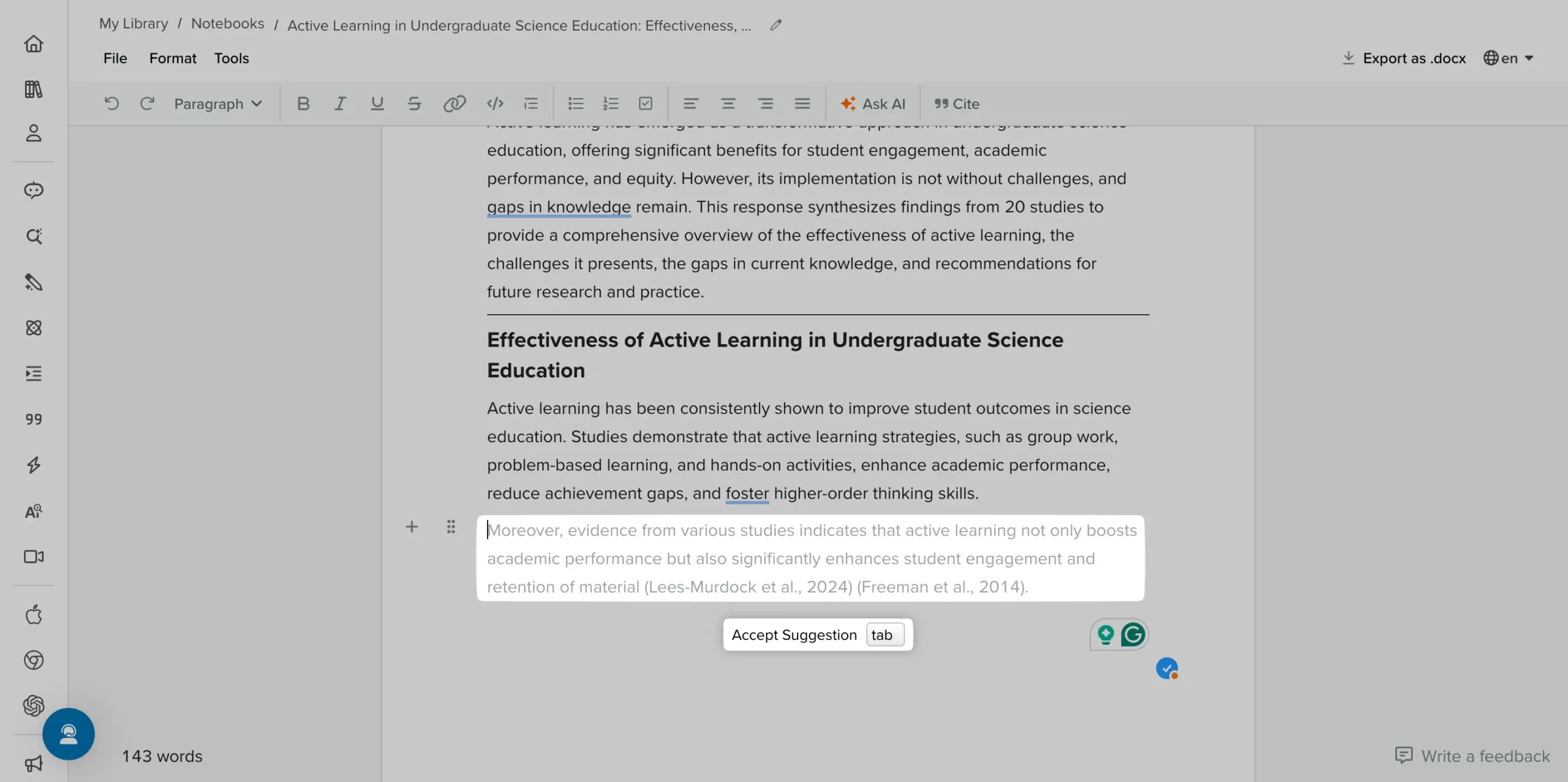
Everything works smoothly.
Finally, let's test Chat with PDF.
Unlike Paperpal, SciSpace's PDF reader loads slowly after upload.
The structure matches Paperpal: PDF content on the left, AI chat features on the right.
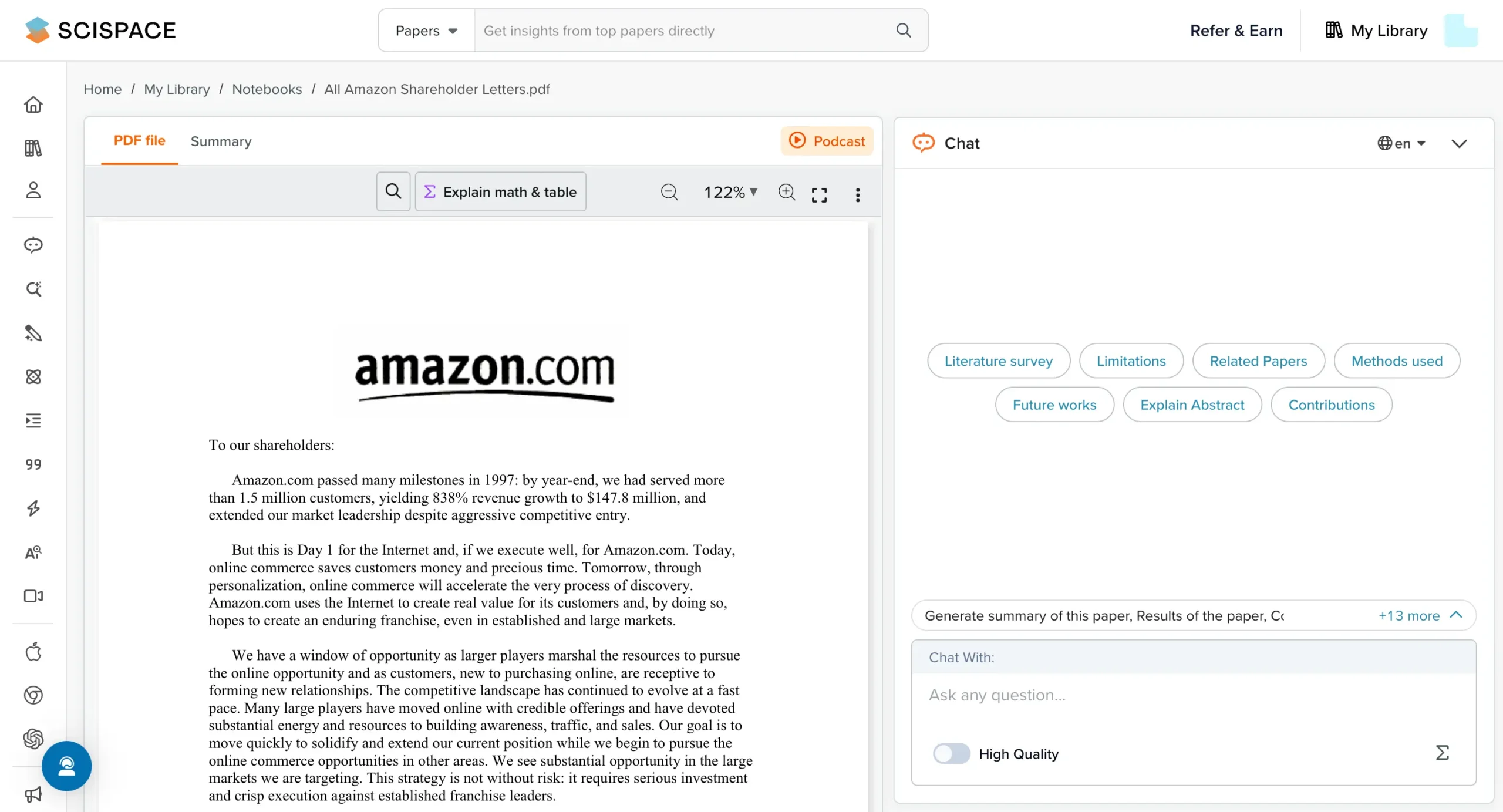
SciSpace offers something Paperpal lacks: the Podcast feature. You can convert your PDF to high-quality audio within seconds and listen on the go.
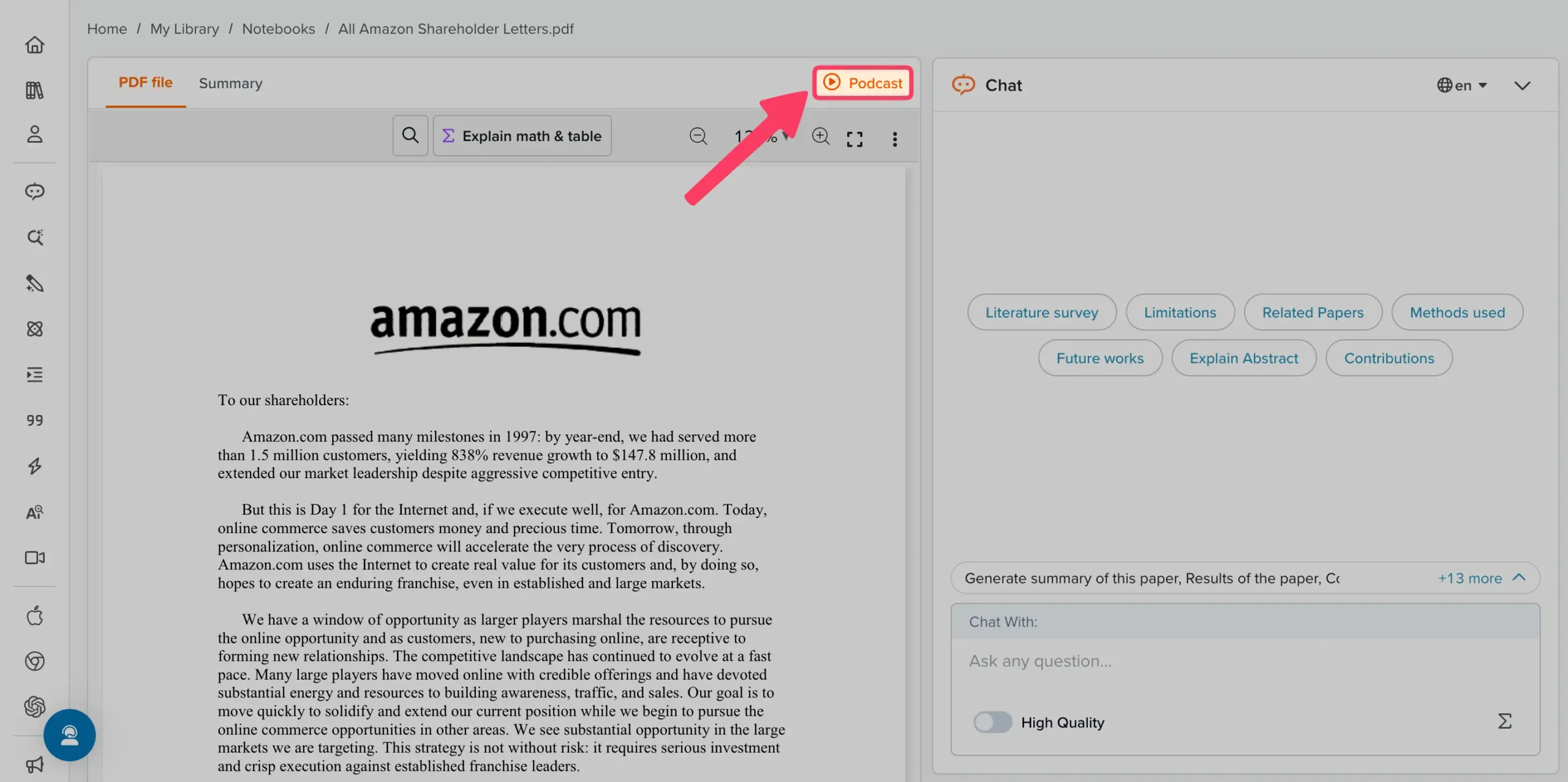
You can take notes, highlight and annotate, and ask the AI to explain specific paragraphs, just like Paperpal.
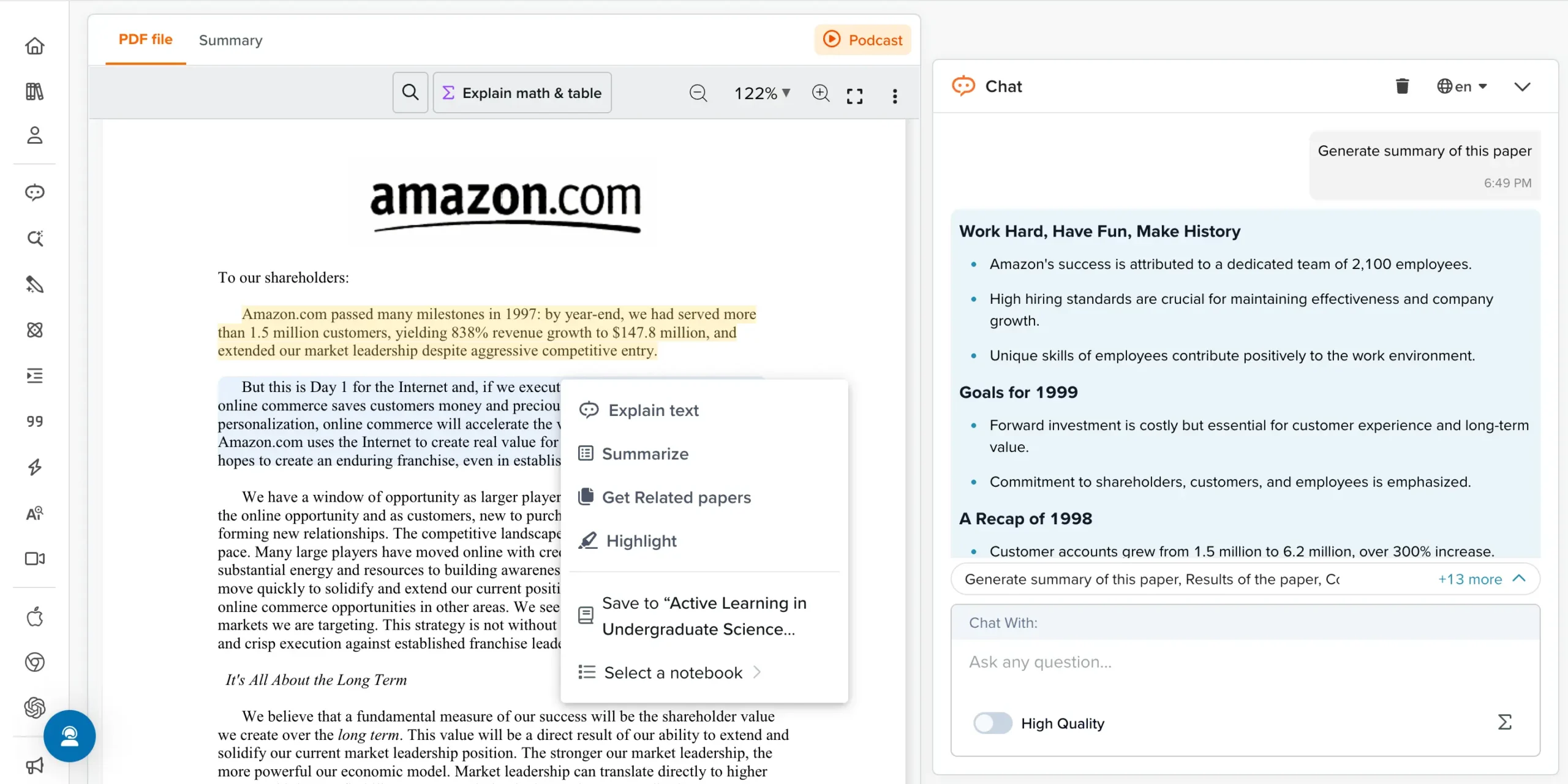
But the uploaded PDF file takes too long to load. Mine did. It was 50-100 pages.
NOTE: Those AI-powered dynamic tables have limitations. The free plan allows 5 columns maximum. Premium and Advanced plans enable 50 columns. Exporting outside SciSpace requires paid plans.
Pricing
SciSpace offers four plans:
- Basic (free)
- Premium ($20 monthly)
- Advanced ($90 monthly)
- and Teams ($18 per user monthly).
Annual billing cuts costs. Premium drops to $12 monthly. Advanced falls to $70 monthly. Teams costs $8 per user monthly.
Basic (Free): Limited searches, five table columns, no exports. Proves the tool works, but frustrates quickly.
Premium ($20 monthly, $12 yearly): Unlimited searches, 50 table columns, full exports, unlimited PDF chats. Most users need this.
Advanced ($90 monthly, $70 yearly): Premium features plus Deep Review mode that processes thousands of papers in minutes. For literature-heavy projects only.
Teams ($18 monthly, $8 yearly per member): Premium features plus management tools for research groups.
Exclusive discounts for you:
Use code DHRUVIR40 at checkout for 40% off annual plans.
Use code DHRUVIR20 at checkout for 20% off monthly plans.
#3 — Jenni AI
Available on: Web

Pros
Cons
Jenni AI offers the cleanest interface of any AI research writing tool I have tested.
When you sign up and log in, you see this:
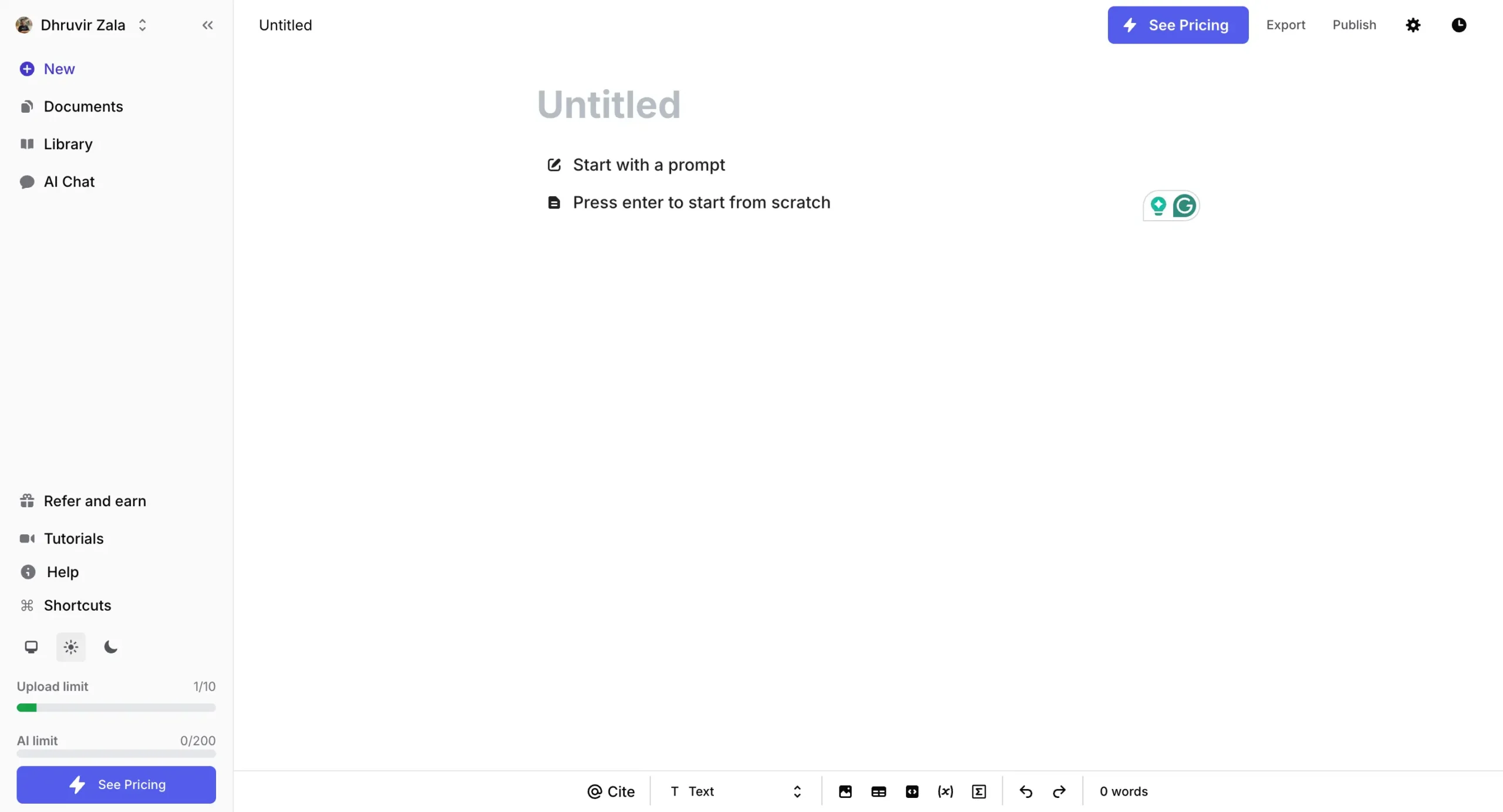
A minimal interface: collapsible left sidebar, main writing panel, and formatting features at the bottom.
Click "New" in the top left to access Jenni's three main features:
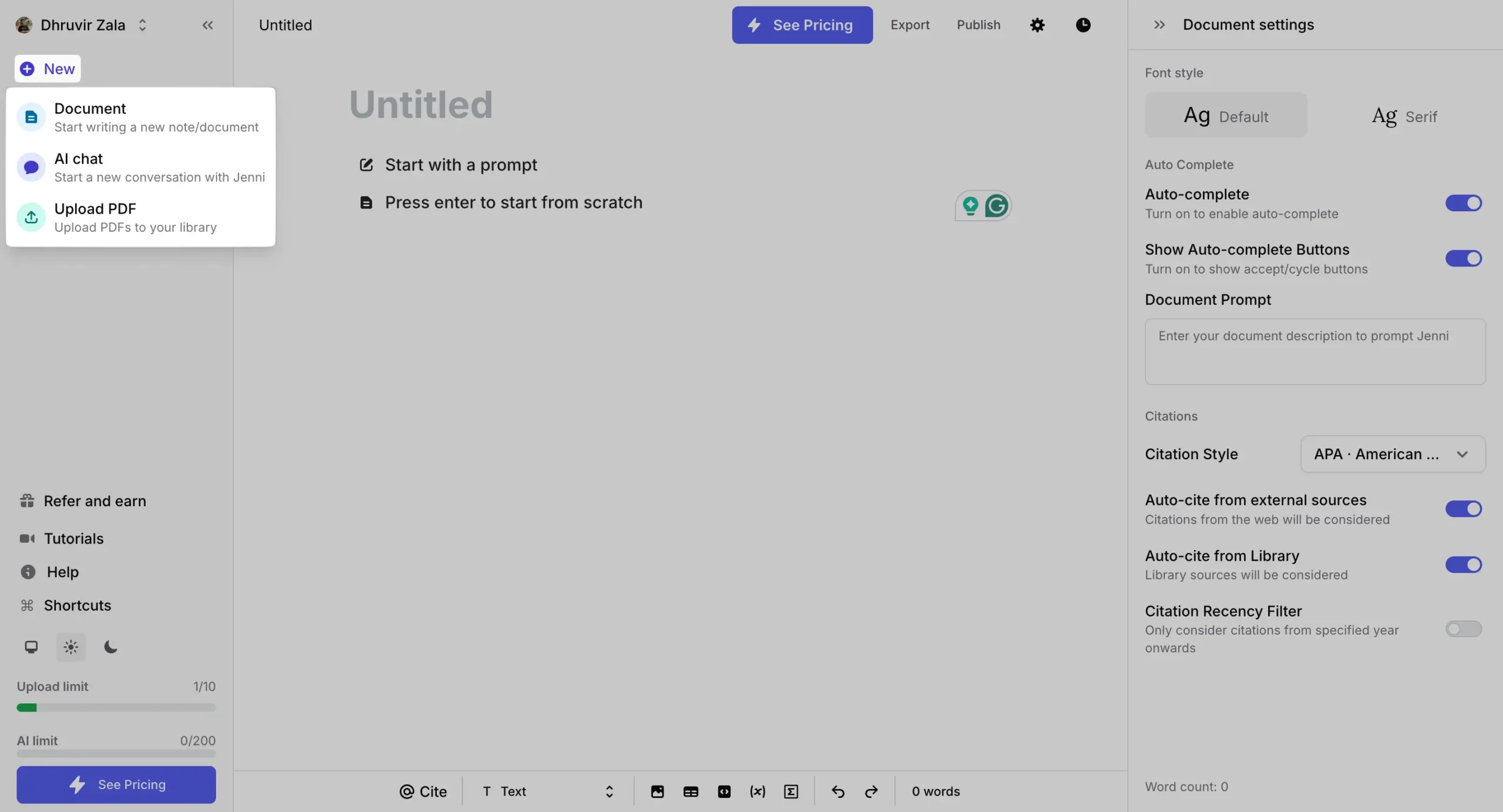
Let's examine each feature, starting with Jenni Documents.
Create a new document and you reach a blank page. A pop-up asks: "What are you writing today?"
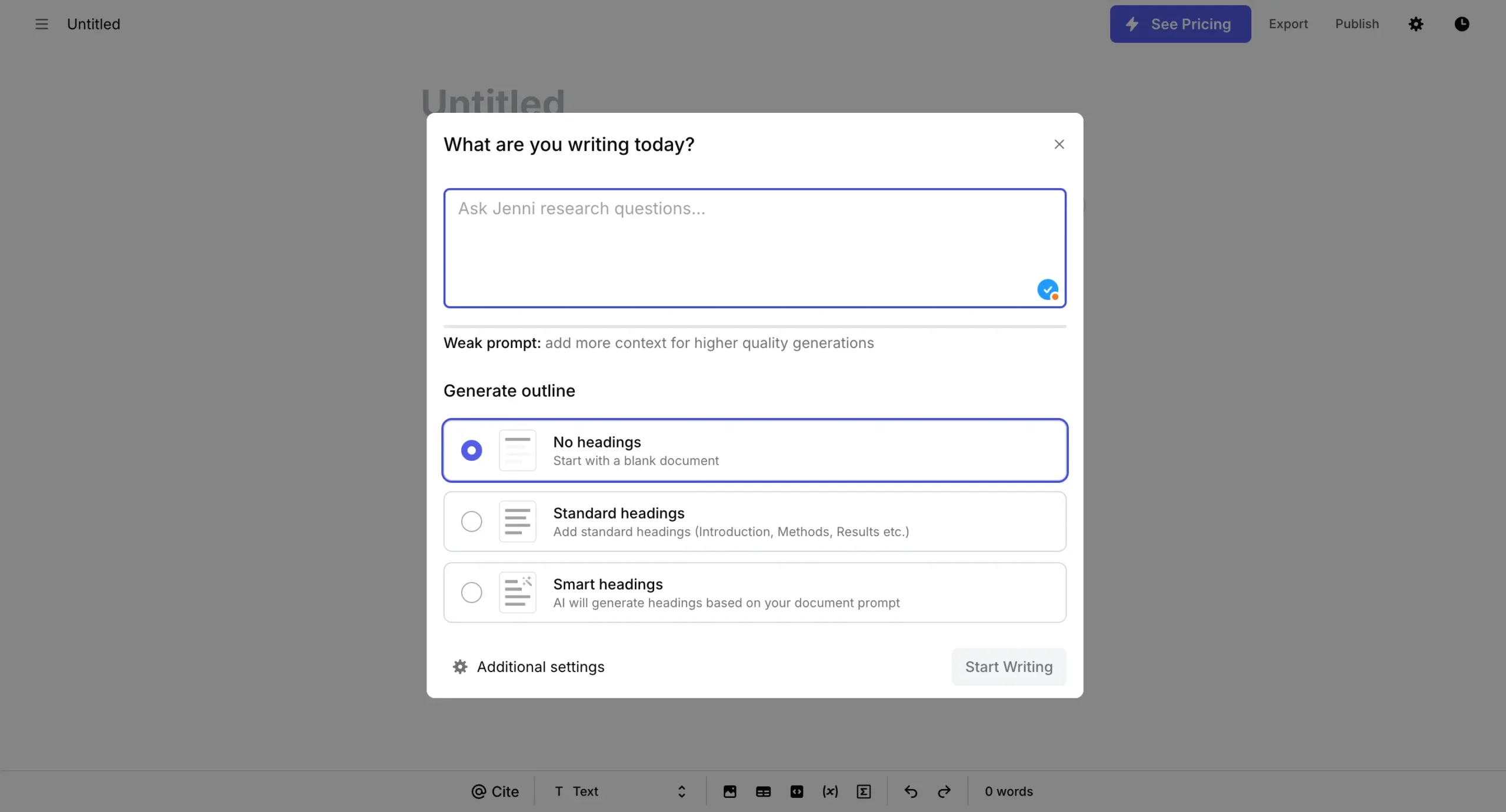
Enter your prompt, then select outline preferences: no headings, standard headings, or smart headings, where AI generates headings based on your prompt.
Additional settings deserve attention. You can enable auto-complete, choose from 2,600+ citation styles, and toggle "auto-cite from new sources/library."
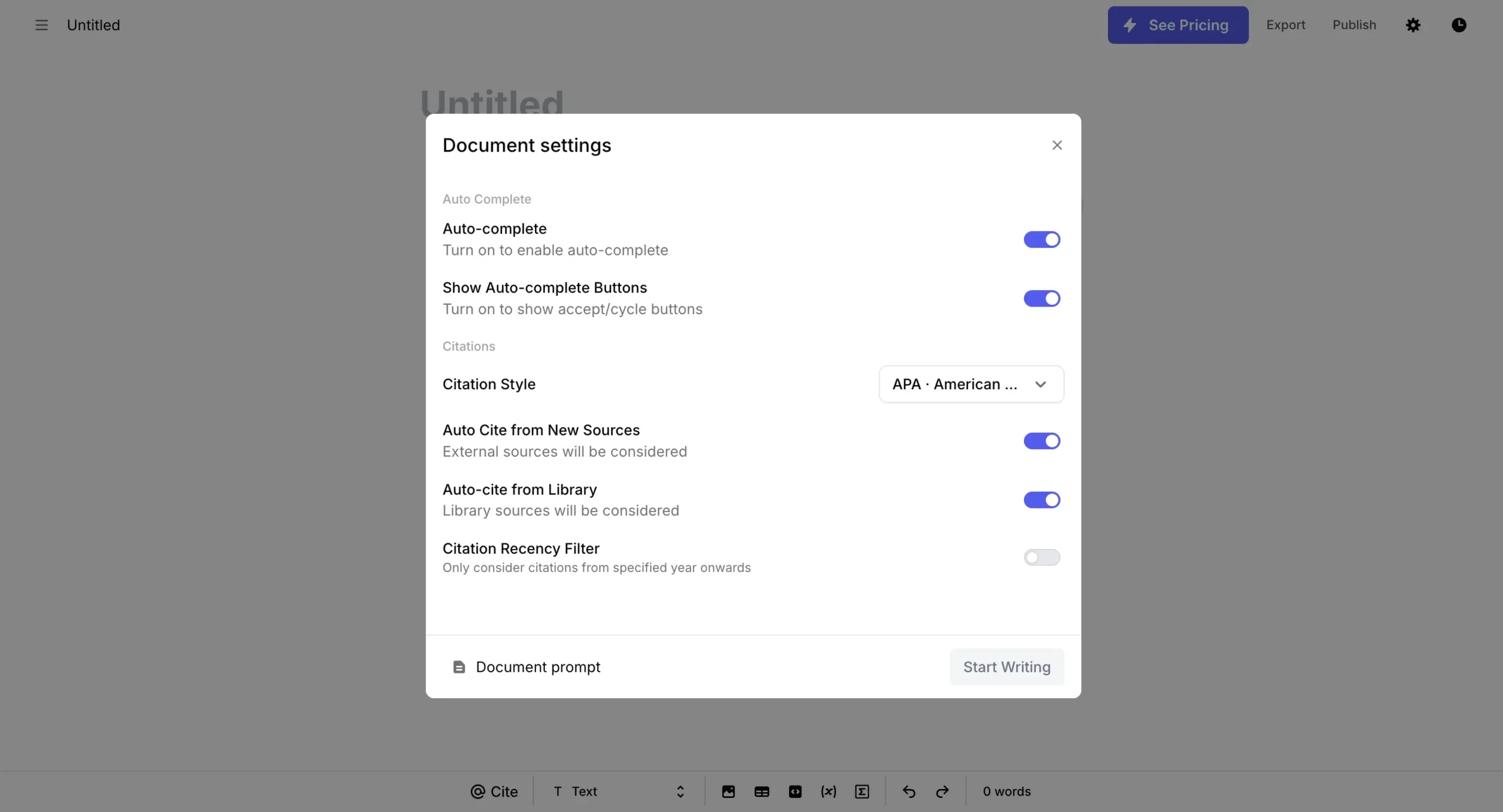
After setup, click "Start Writing."
I gave Jenni the same prompt I used for SciSpace:
"Review the last ten years of research on active learning in undergraduate science education. Find what works, what doesn't, and what we still don't know. Use at least twenty studies. Tell me straight."
Jenni generates output quickly without sacrificing quality.
Within seconds, my blank document gains a title and headings. Jenni suggests the introduction content. I can "Accept" or request "Try Again."
Once I accept the paragraph, Jenni cites it with a relevant source. Hover or click the source for details. Jenni then suggests the next paragraph as I move my cursor past the sentence's end.
This is Jenni's strength.
Instead of writing complete papers from a one-shot prompt (not recommended), Jenni helps when you feel stuck.
It acts as a constant companion, ready when needed, while leaving the thinking to you. This is how it should work.
Document editing follows standard patterns: press "/" or use the bottom bar for formatting and citations.
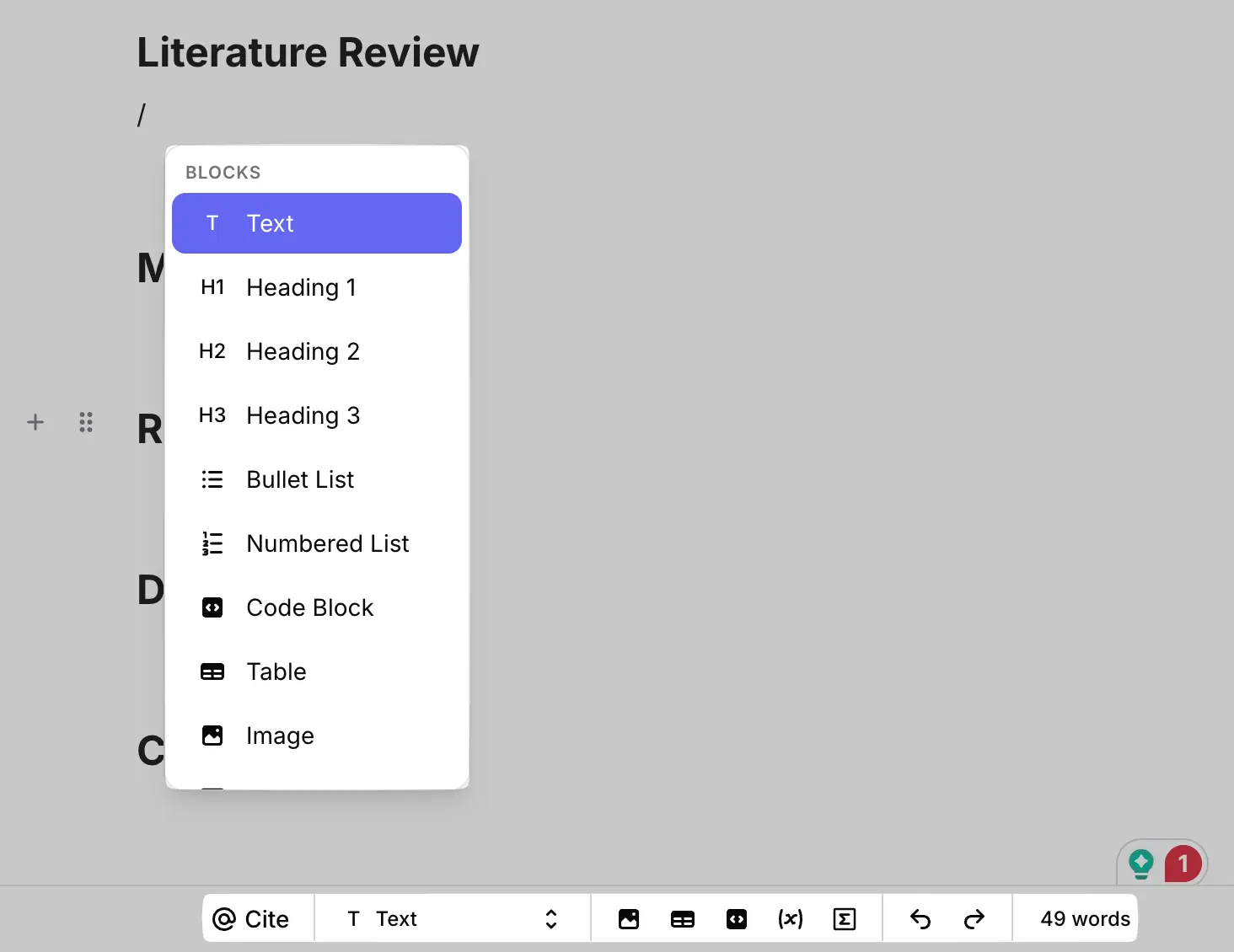
Of the top three tools mentioned, Jenni proves easiest to use and least distracting.
Now for the "AI Chat" feature. Click it, and a collapsible chat box opens on the right.
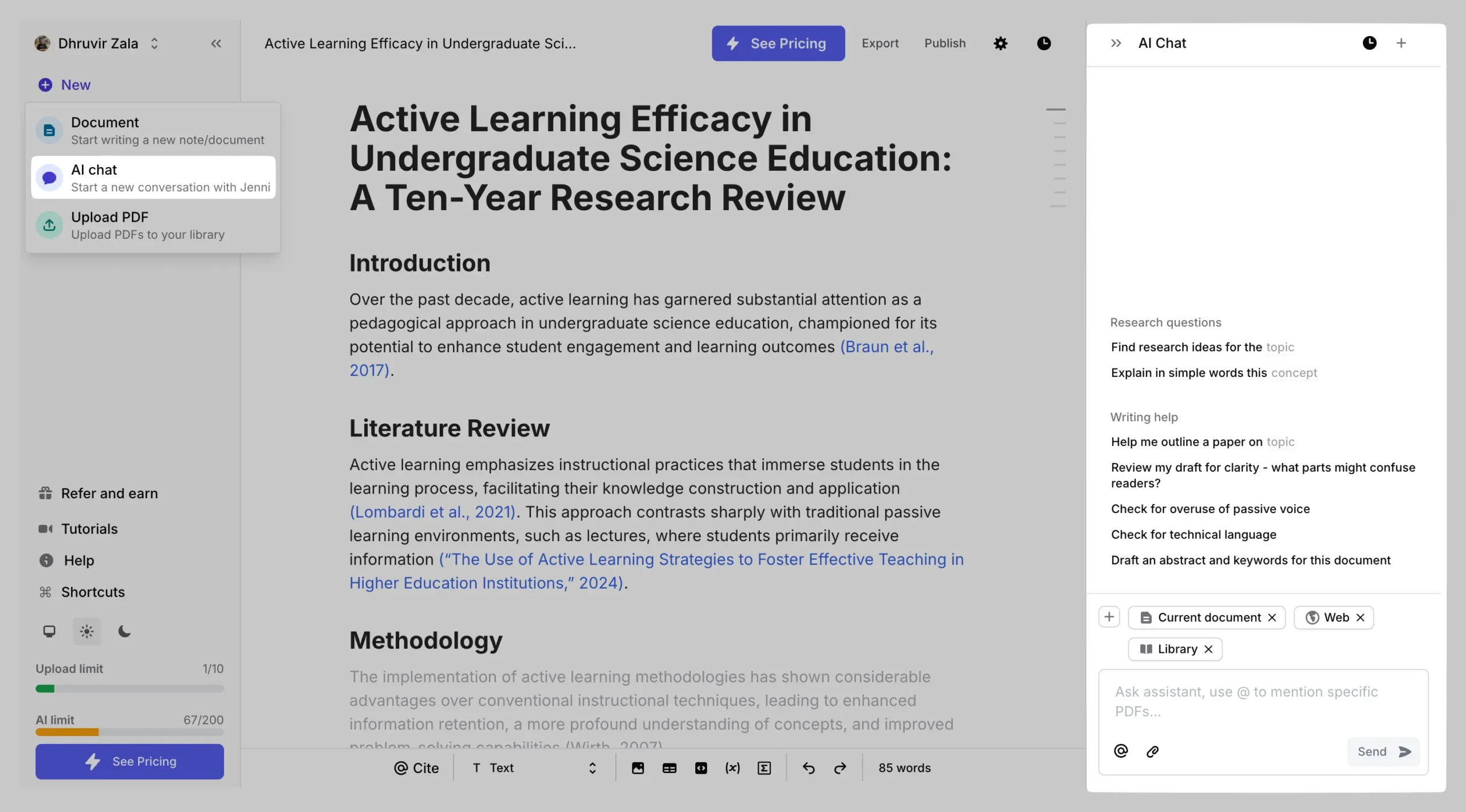
The interface looks clean, like the rest of the product. But the real value lies in the plus button, which powers the chatbot with:

You can discuss documents you create in Jenni while fact-checking through a web search. The integration works well.
Finally, Jenni offers "Upload PDF." Uploaded files join your Jenni Library.
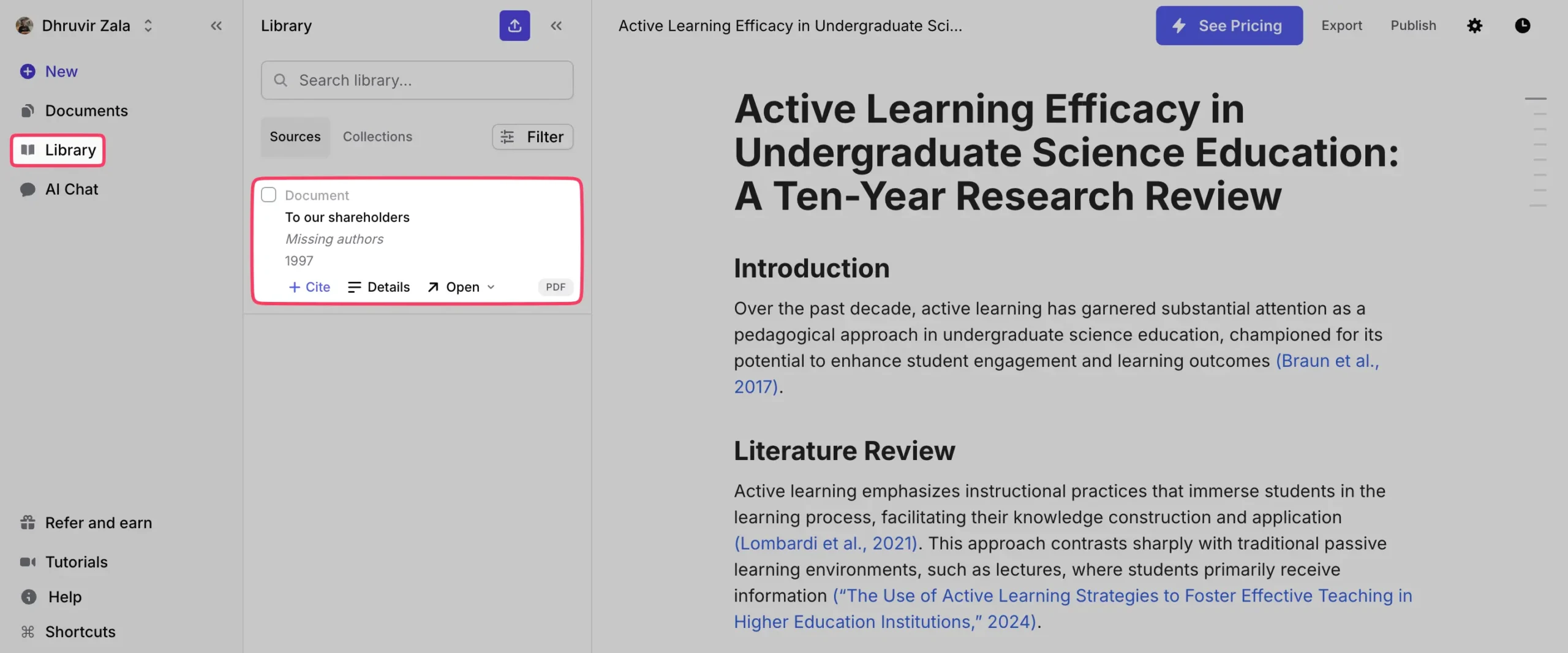
Jenni should show a progress bar during uploads. Currently, nothing happens until the file suddenly uploads, and you receive the update.
The PDF opens in a reader like this:
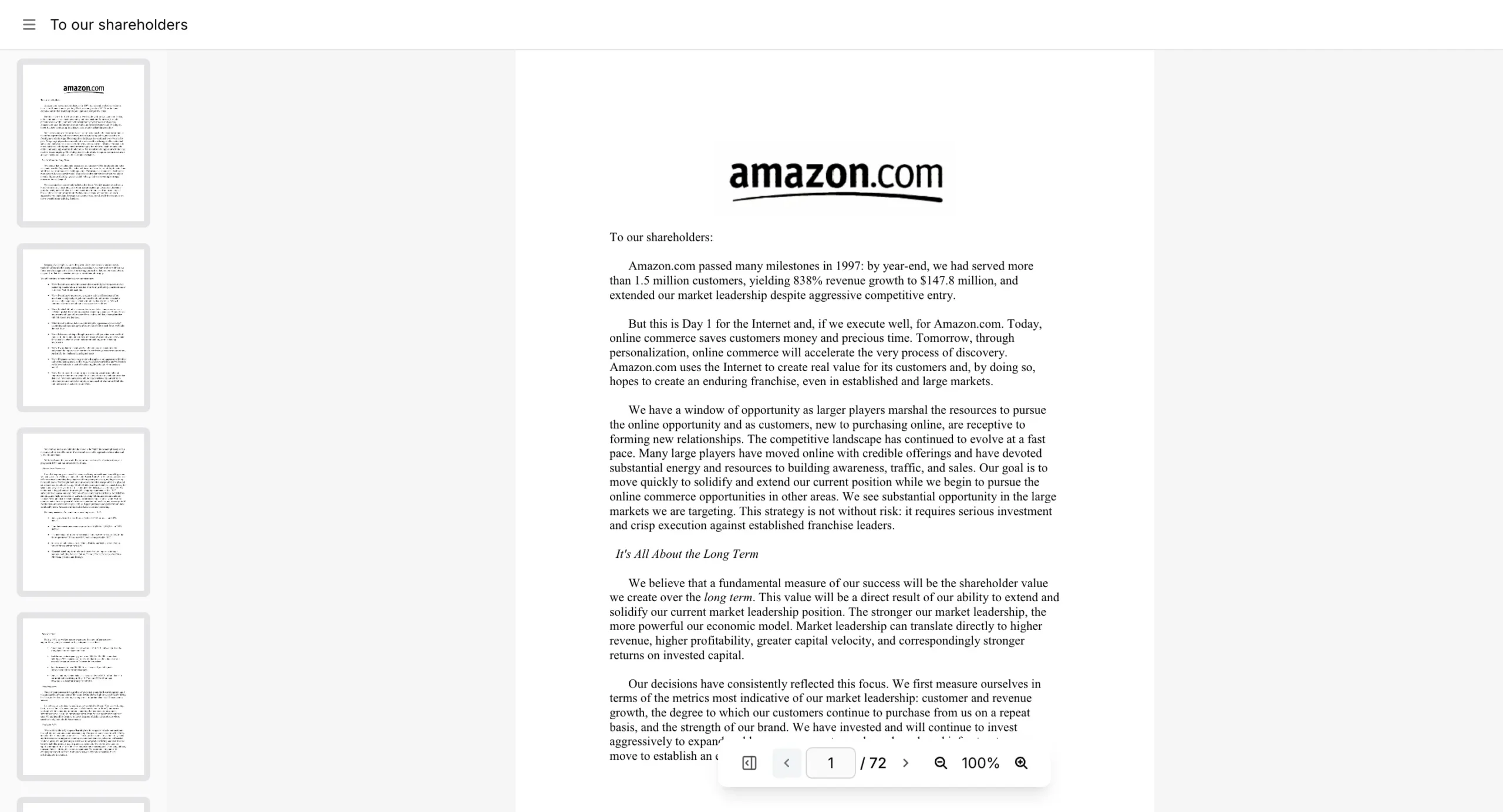
Clean and familiar: PDF on the left, AI chat on the right.
You can chat with your PDF. AI output comes fast, accurate, and high-quality.
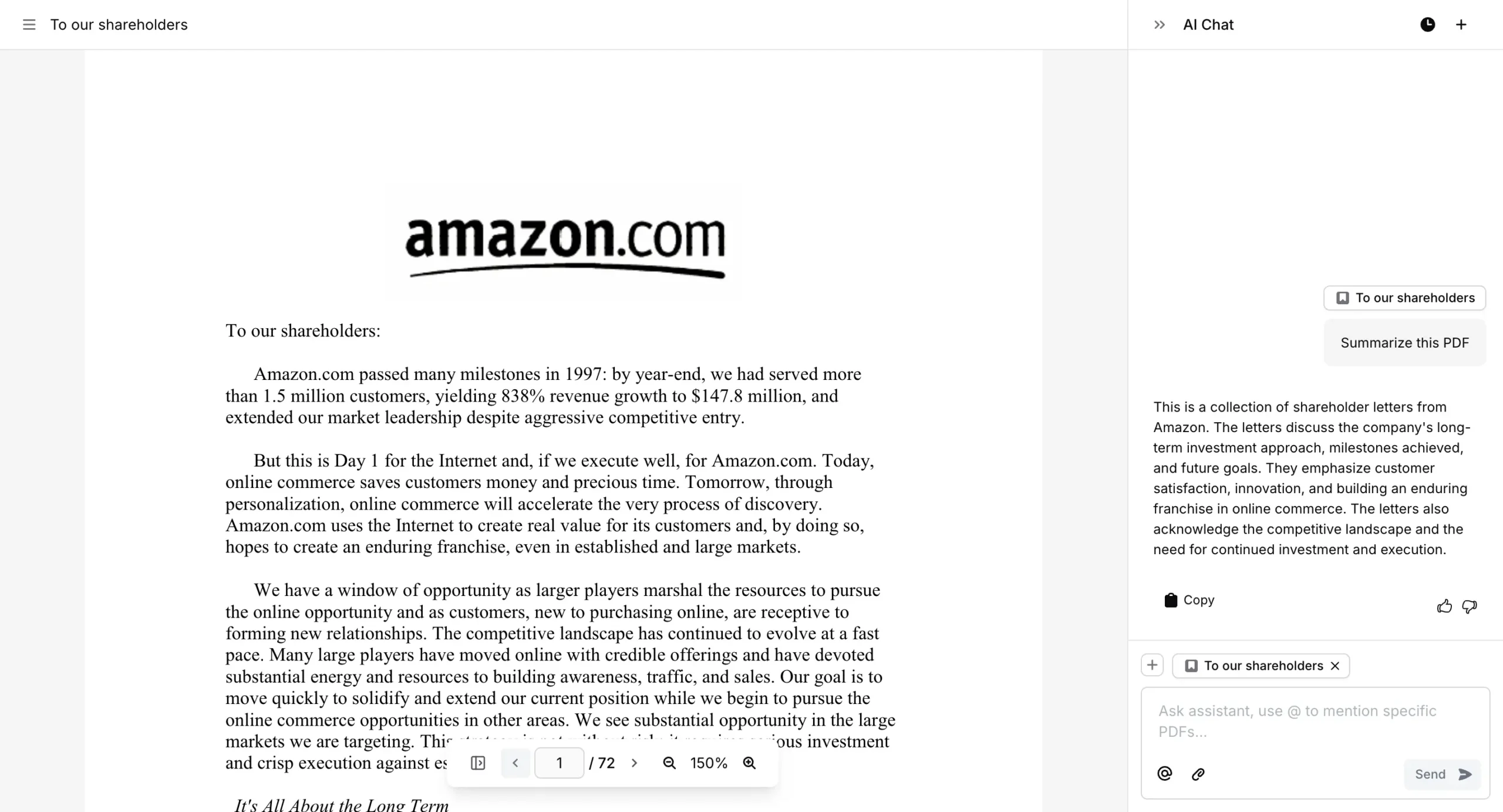
However, Jenni lacks important features.
Unlike Paperpal and SciSpace, Jenni won't let you highlight specific PDF sentences for AI analysis. It offers no note-taking, highlighting, or annotation features.
You can only "talk to the whole PDF"—something anyone can do. If PDF interaction matters to you, choose Paperpal or SciSpace.
But if you want to write serious research papers with AI help while maintaining creative control, and you value minimal interfaces, Jenni AI works well.
Pricing
Jenni offers three plans: Free, Unlimited, and Team & Institutional.
Free Plan: Costs nothing. Gives you 200 AI suggestions daily, 10 PDF uploads, 10 chat messages, and 1,700 citation styles. Document export works partially—you can get your work out, but not in full format.
Unlimited Plan: Costs $30 monthly or $12 yearly. Annual billing saves 60%. Removes all limits: unlimited AI suggestions, unlimited PDFs, unlimited chat, full document exports, and live support.
Team & Institutional: Custom pricing for universities and research groups. Adds dedicated support, usage tracking, bulk discounts, and single billing.
The math is simple. Pay monthly and spend $360 yearly. Pay annually and spend $144. The annual plan costs less than five months of monthly payments.
The question is value. Jenni gives you clean writing assistance without research features.
If you need massive paper databases or plagiarism detection, pay more for Paperpal or SciSpace. If you want simple writing help with good citations, Jenni works.
#4 — Yomu AI
Available on: Web
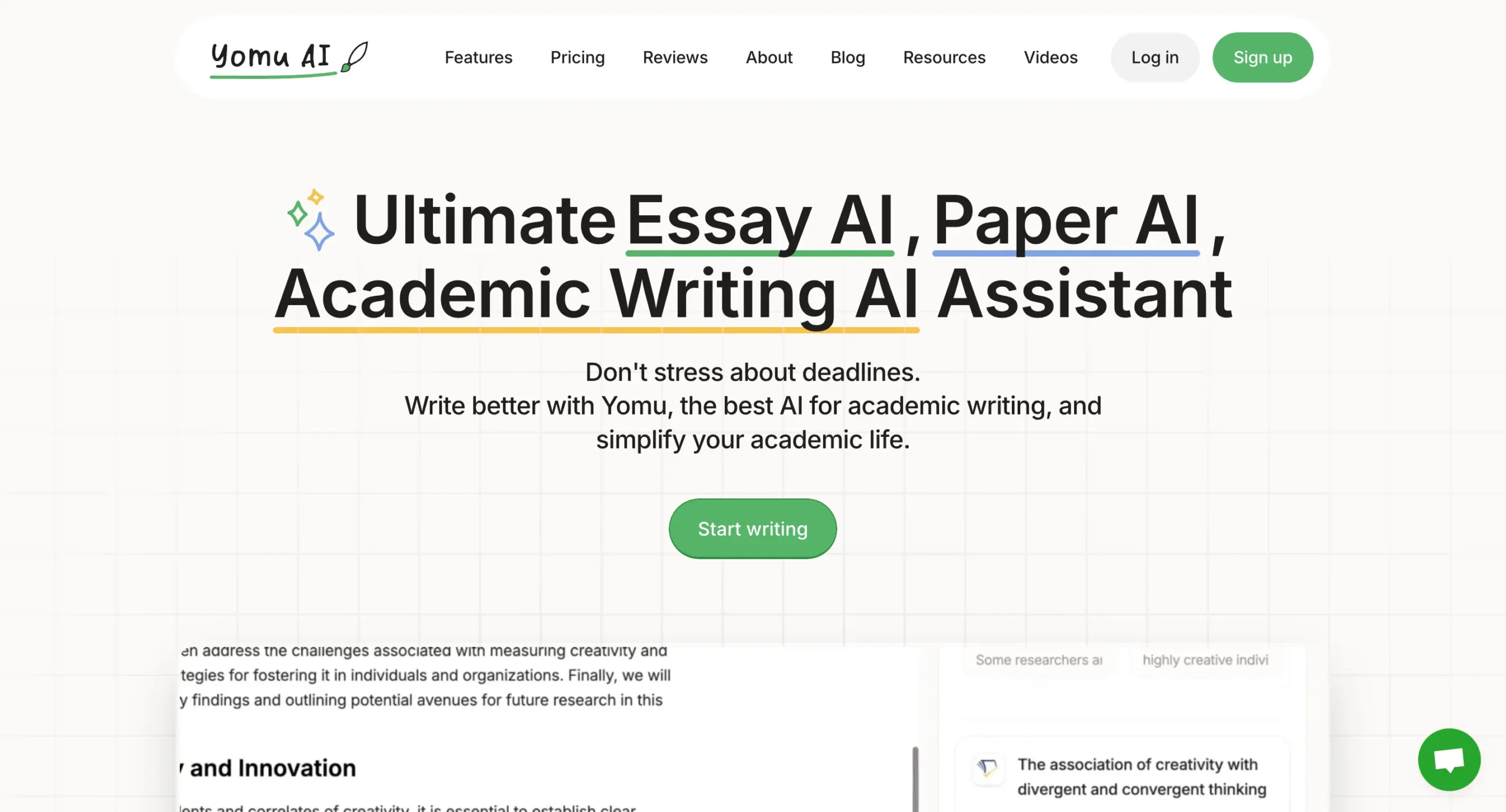
Pros
Cons
Yomu AI presents itself as a simple AI research paper and essay writing assistant.
The company states its purpose clearly in its ethics statement: "The purpose of Yomu AI is to provide assistance, not a shortcut, for academic writing." This honest positioning sets proper expectations.
The interface remains clean and basic, free from distractions.
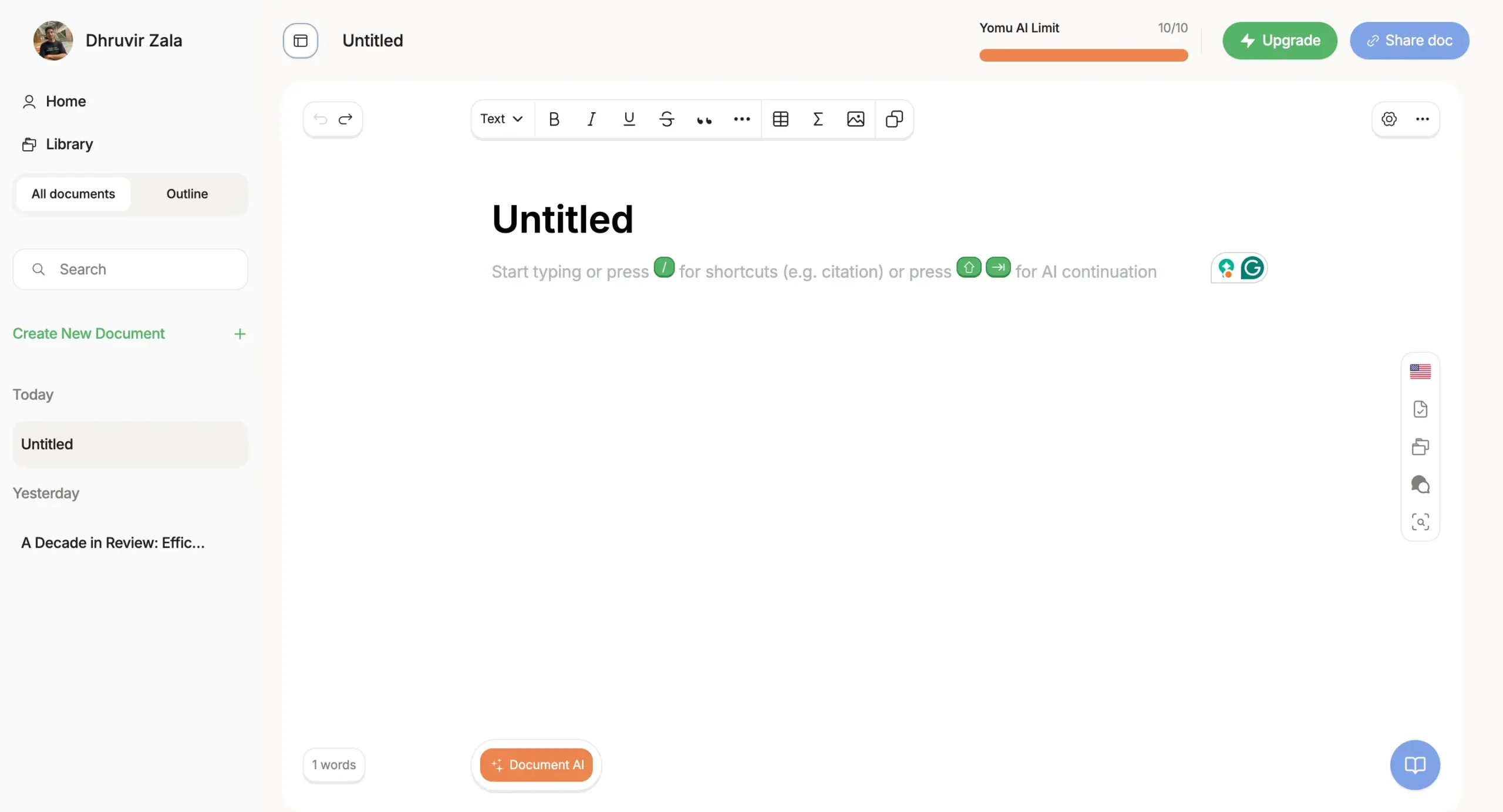
When you sign up and log in, onboarding tutorials appear in the center. A collapsible left sidebar allows you to create new documents.
Click "Create New Document," and a pop-up asks: "What are you writing today?"
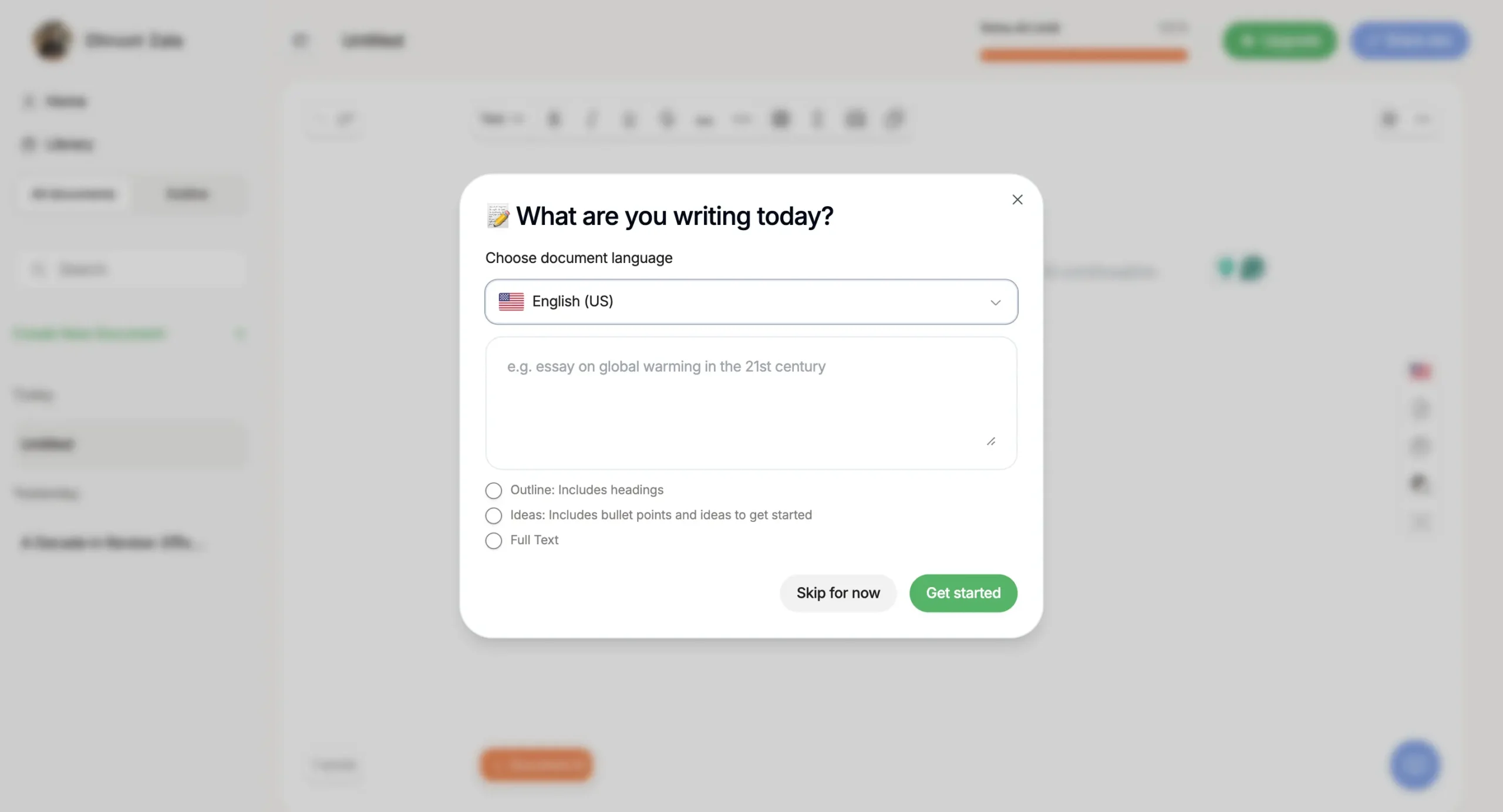
You can select your writing language, specify your topic with additional details, and choose your output format:
I tested Yomu AI with the same prompt used for other tools:
"Review the last ten years of research on active learning in undergraduate science education. Find what works, what doesn't, and what we still don't know. Use at least twenty studies. Tell me straight."
Within seconds, it produced 761 words on the specified topic.
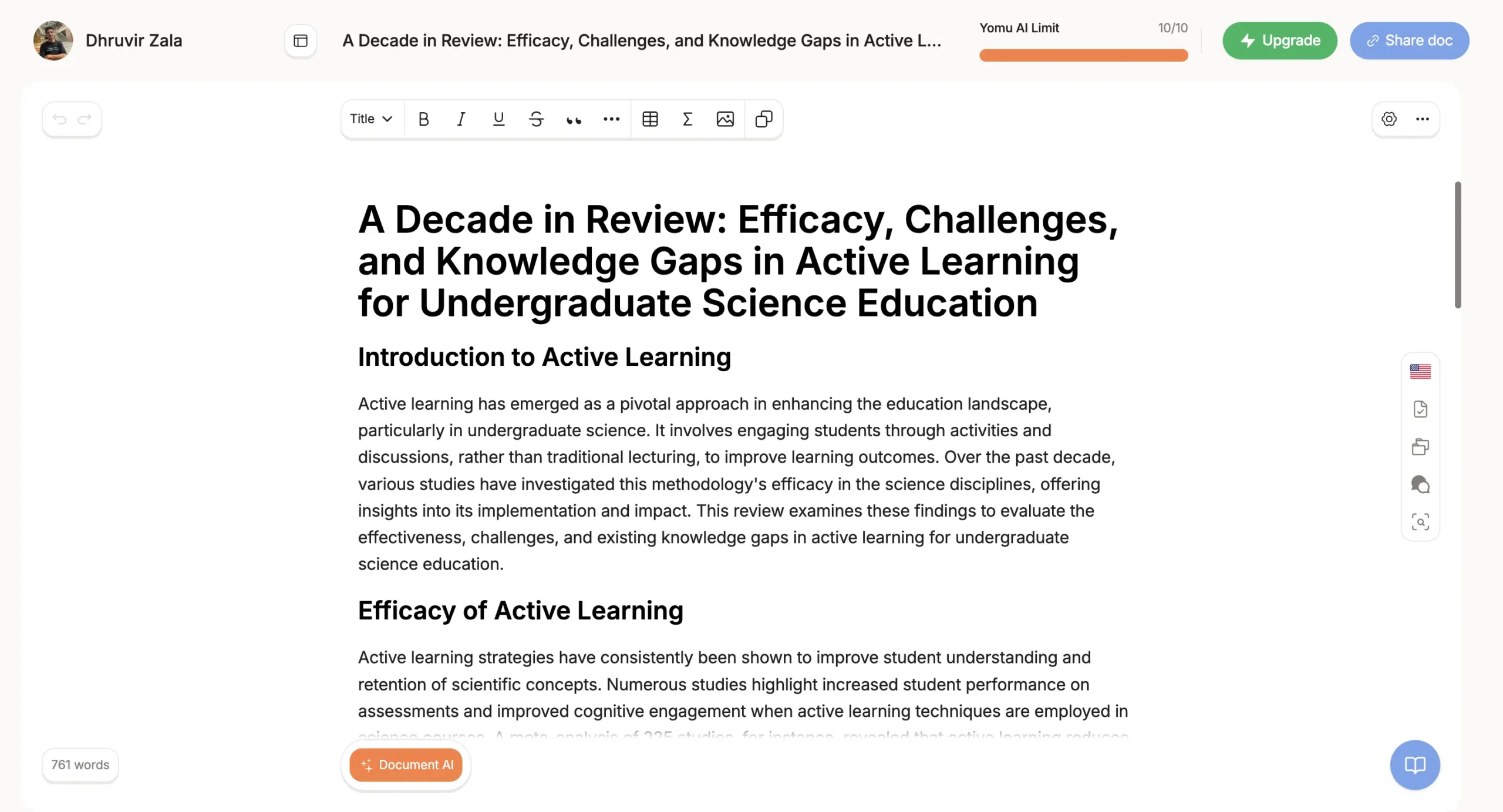
Here lies the problem: unlike Paperpal and Jenni AI, Yomu AI adds no citations automatically. The entire text contains zero citations, raising serious questions about reliability and accuracy.
Instead of direct citations, Yomu AI inserts citation placeholders where references belong.
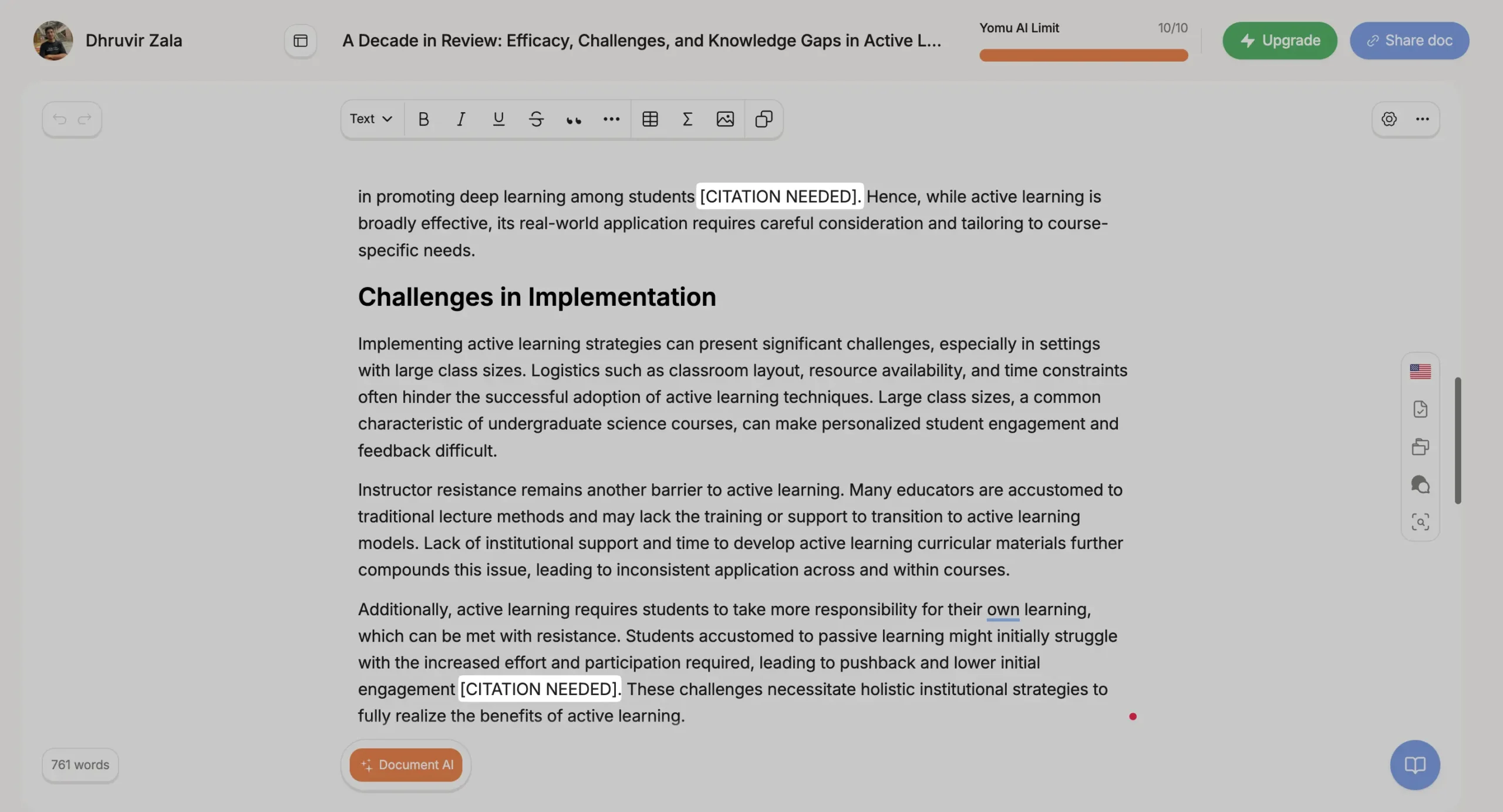
To add citations, you have to select a paragraph and click "Cite." This loads relevant citations you can insert with one click.
You can even add the citations manually, without AI.
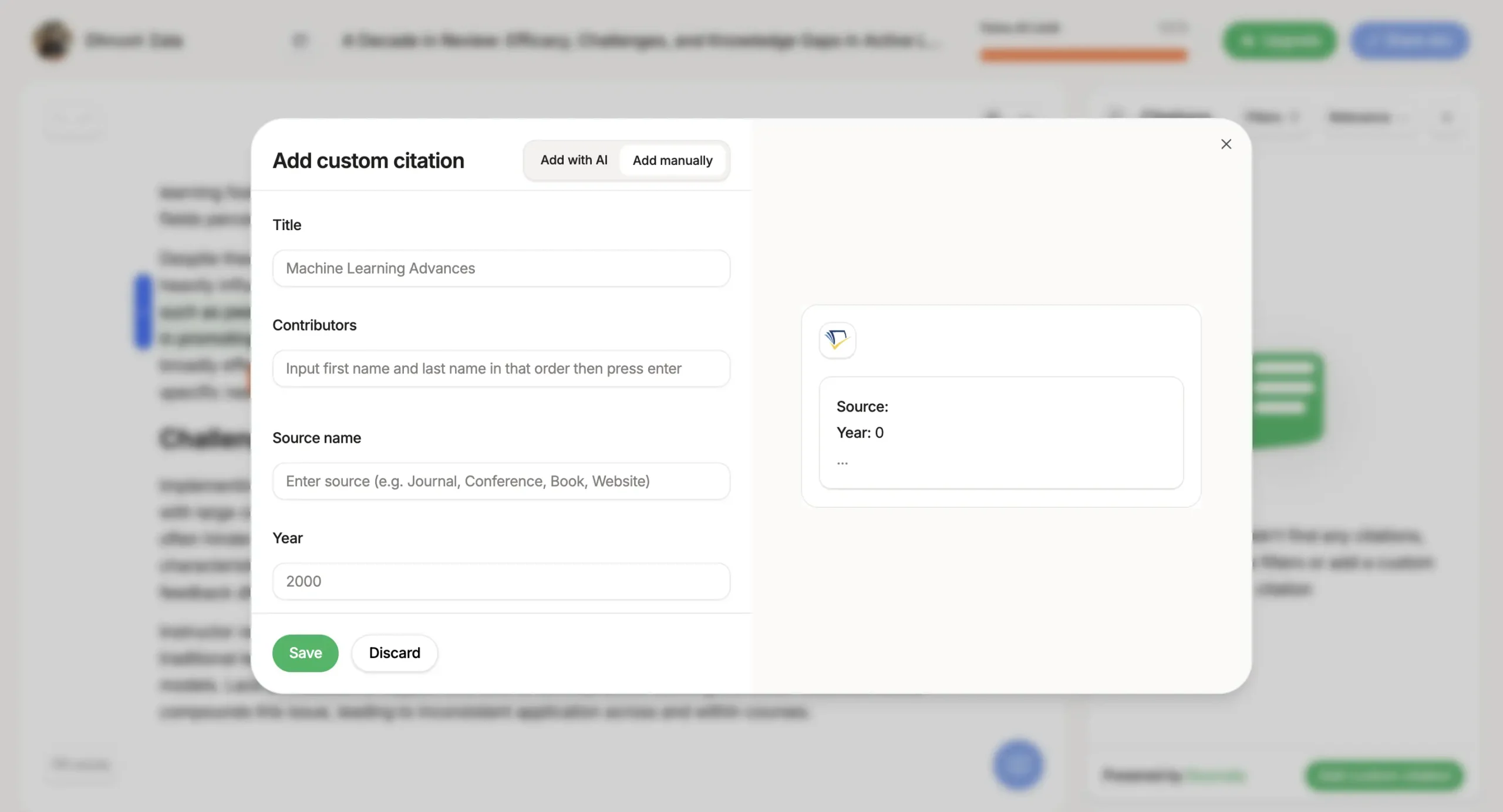
Additionally, you can chat with your document.
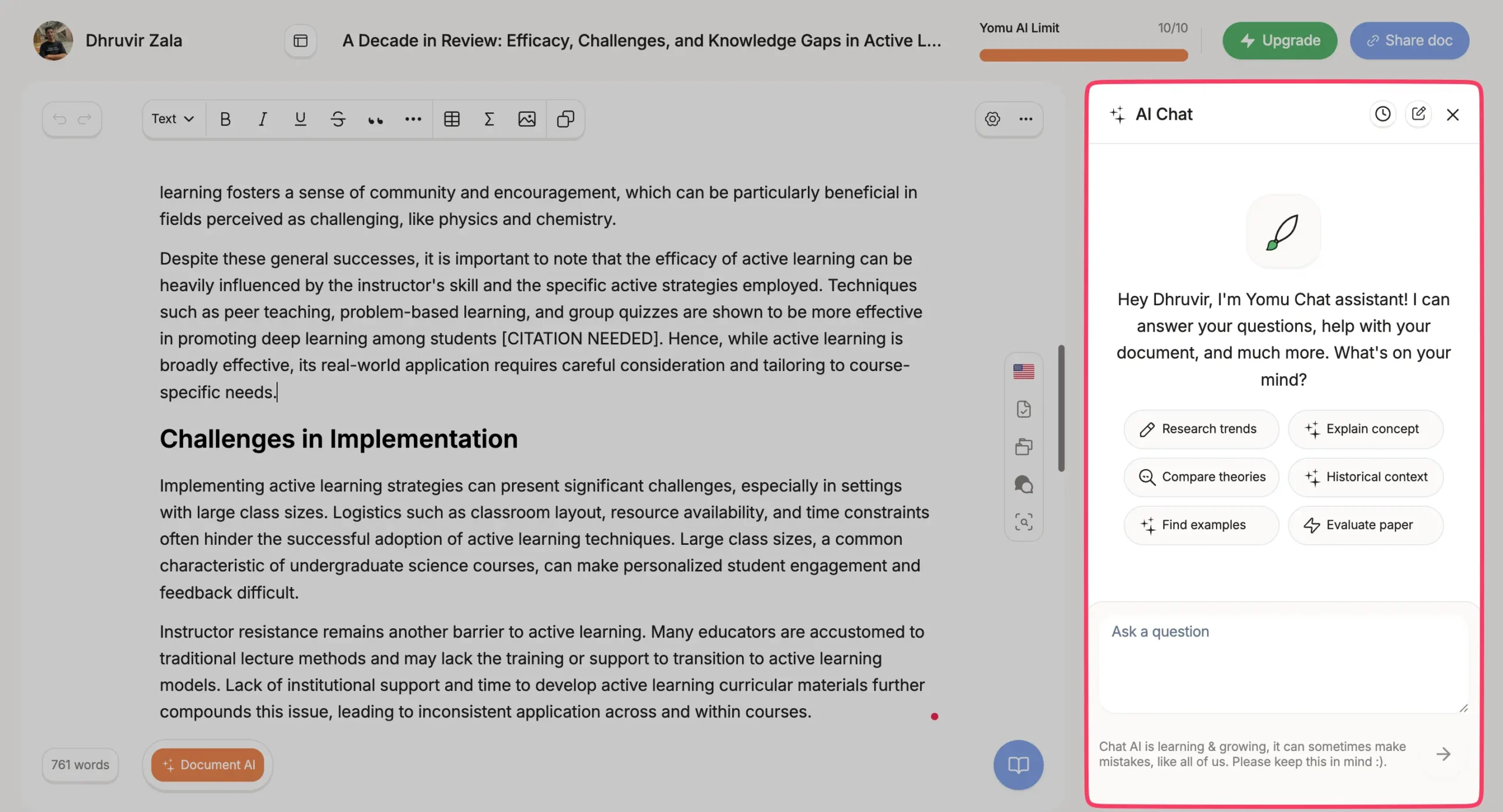
However, Yomu AI currently lacks PDF reading capabilities.
It does offer plagiarism checking.
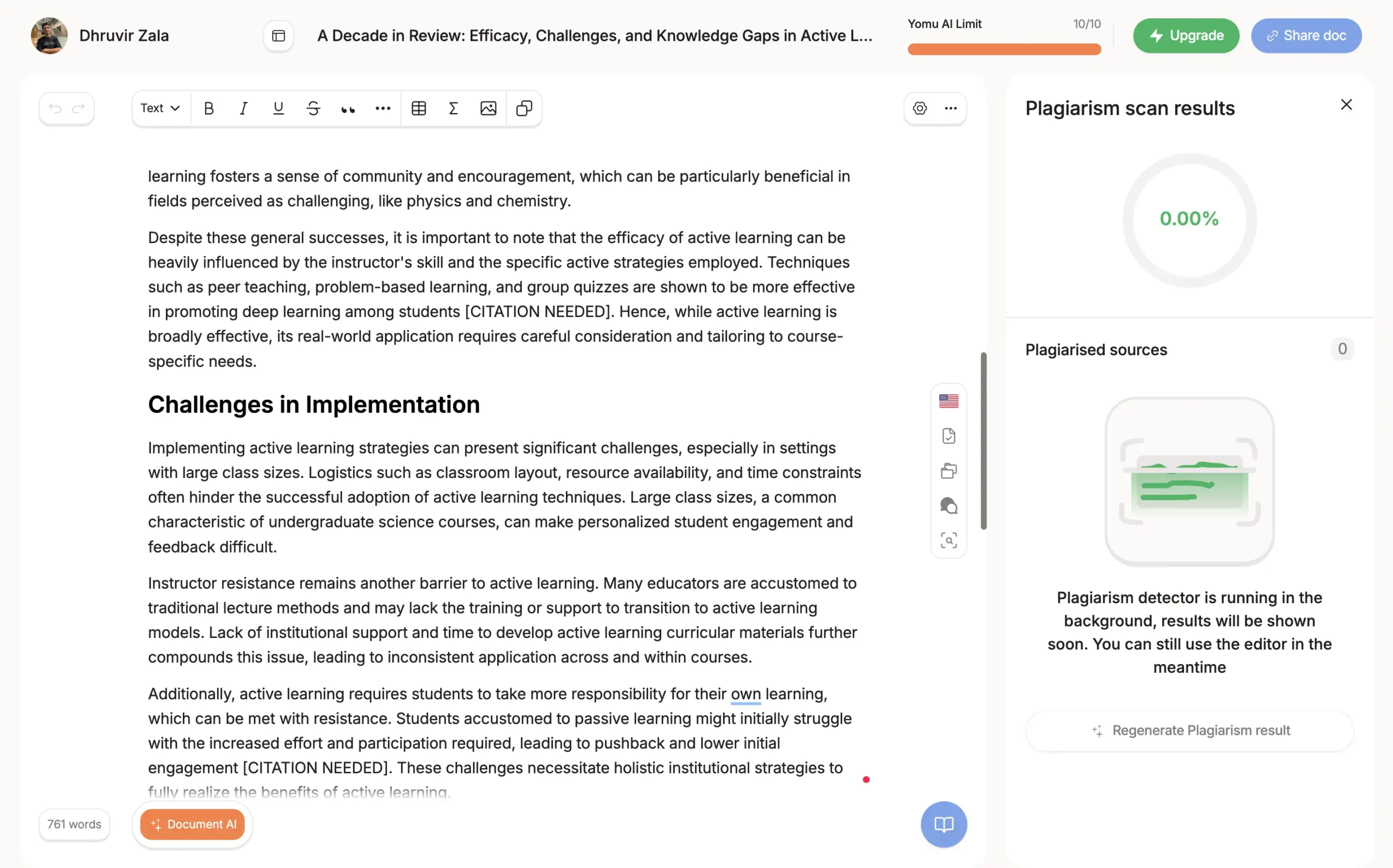
And export options: LaTeX (.tex), MS Word (.docx), and HTML (.html).
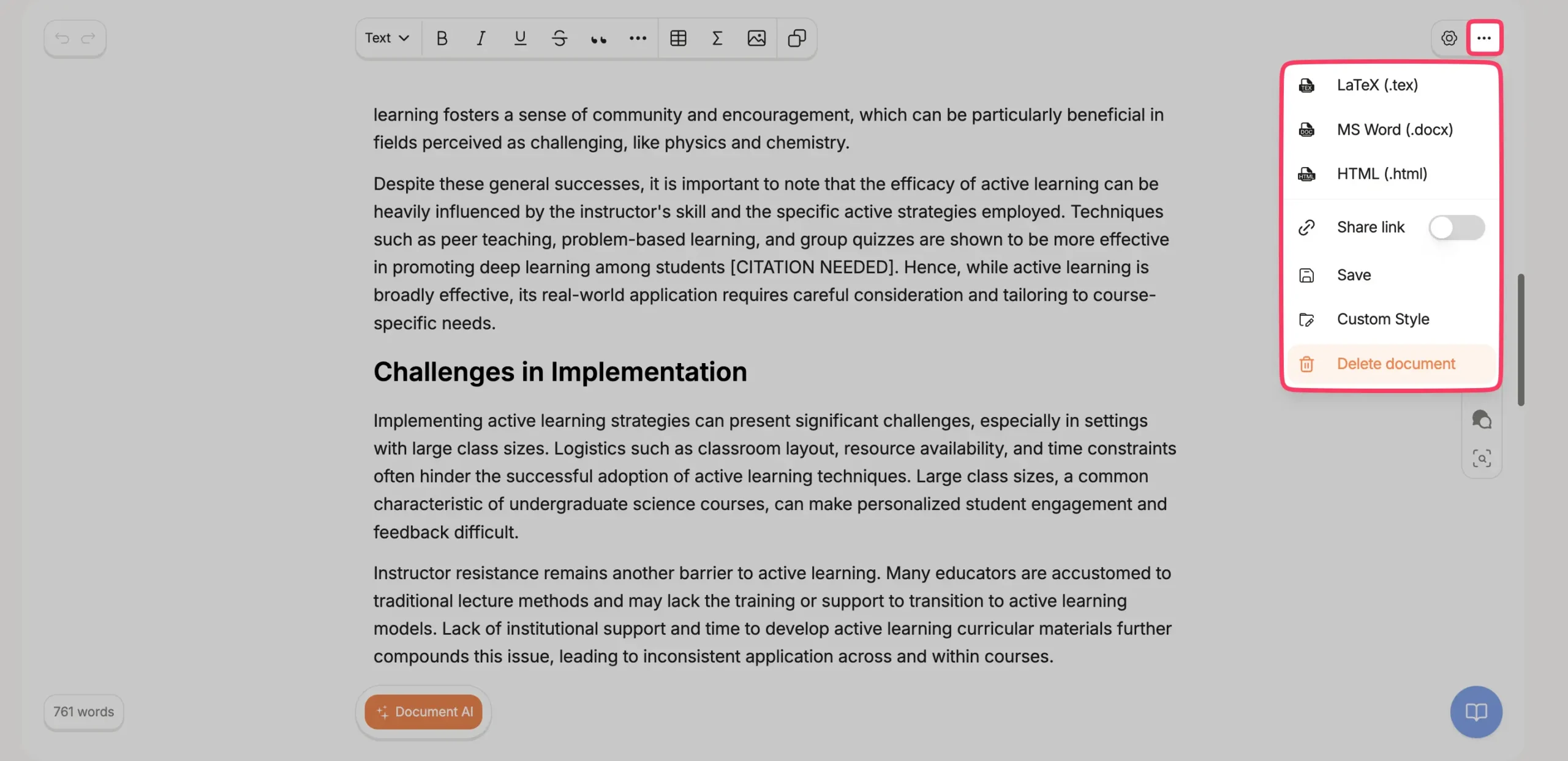
Like other tools, Yomu AI allows you to select text and apply AI assistance.
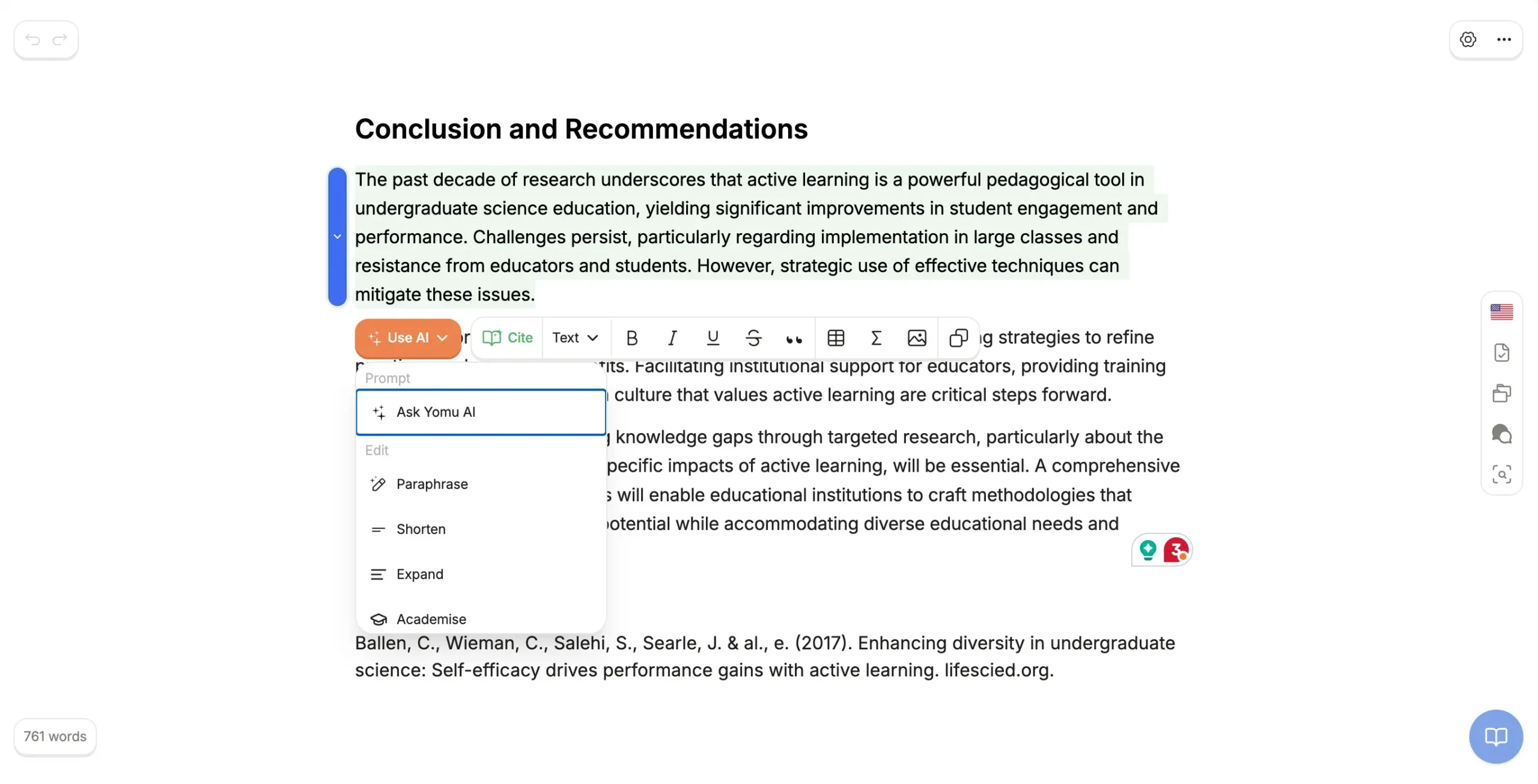
However, after everything being said, Yomu AI fails where it matters most.
Academic writing without proper citations is not academic writing. It is dressed-up blogging. When a tool produces 761 words on scientific research without a single source, it teaches students to write like charlatans.
Who should use Yomu AI?
Students who want to practice basic writing structure might find it useful, but only if they add their own citations from real sources.
Anyone writing actual research papers should look elsewhere.
Yomu AI remains miles away from being a definitive AI academic writing tool like Paperpal and others.
Pricing
Yomu AI offers four plans: Starter, Pro, Ultra, and Believer.
Starter ($9): Pay once, use until your credits run out (personal experience: they run out faster). You get basic AI commands, access to GPT-4o mini, and ten actions that never expire. No premium features, no priority support, no advanced models.
Pro ($19 monthly, $11 yearly): Unlimited AI actions, all premium features, priority support. The yearly plan cuts costs by 40%. Simple math: pay monthly and spend $228 yearly. Pay annually and spend $132. The annual plan costs less than seven months of monthly payments.
Ultra ($29 monthly, $18 yearly): Everything from Pro plus access to frontier AI models—GPT-4, Claude 3.5, Gemini Pro, and others. Custom writing styles and unlimited usage. The yearly discount saves $132 compared to monthly billing.
Believer ($499): A one-time payment for long-term access to Ultra features. Yomu promises "unbeatable value" for extended periods. The math works if you plan to use Yomu for more than two years.
The pricing makes sense if Yomu delivers what you need.
But remember: Yomu produces academic-sounding text without real citations. You pay for speed and structure, not for research accuracy.
For practice writing, the Starter plan works. For serious academic work requiring proper sources, spend your money elsewhere.
#5 — MyStylus
Available on: Web

Pros
Cons
MyStylus wants to be everything to everyone. This ambition kills focus.
When you first log in, the sidebar assaults you with options.
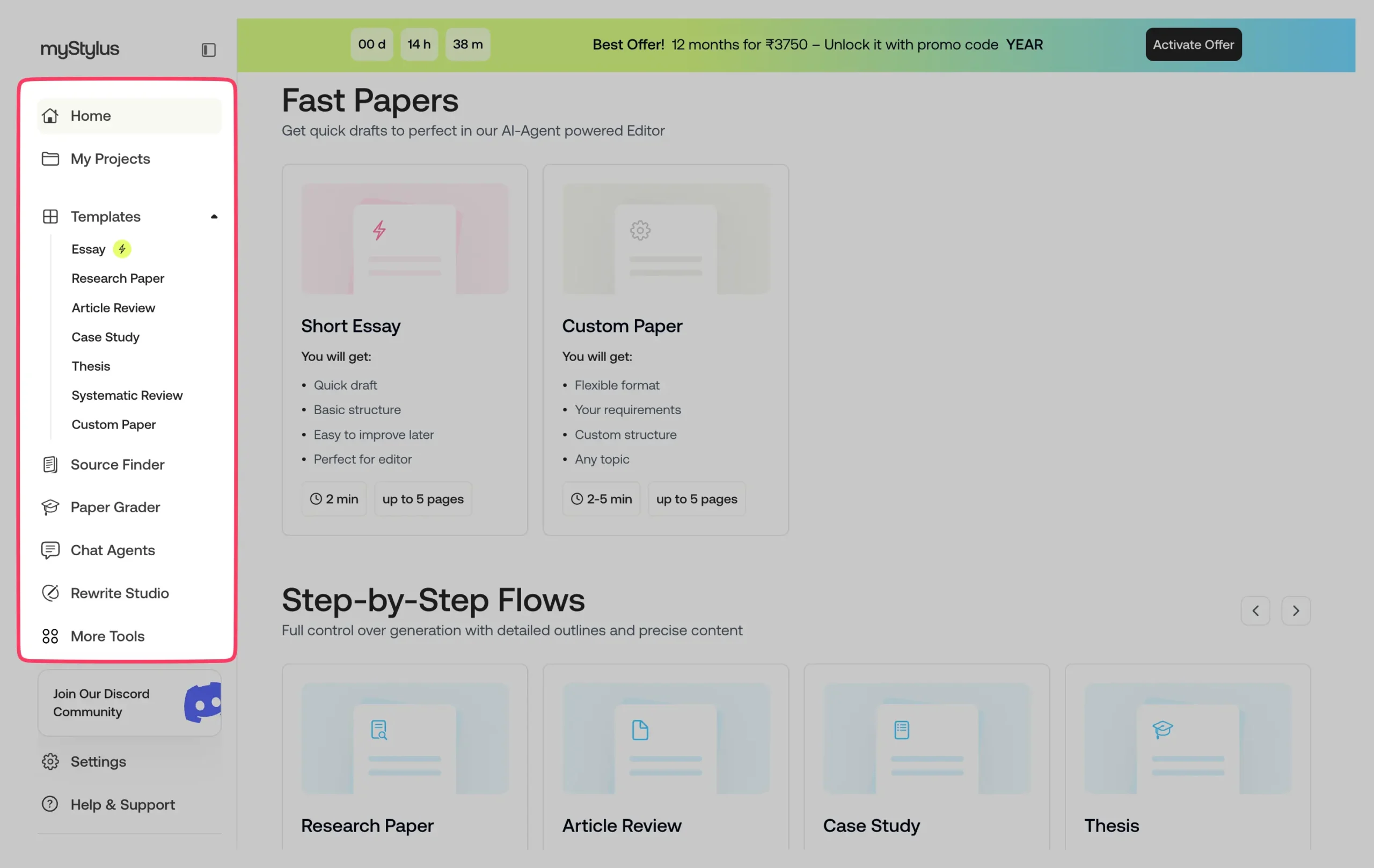
Ten main features stare back. Each promises salvation. None delivers fully.
Click "Templates" and more choices appear.
Essay, Research Paper, Article Review, Case Study, Thesis, Systematic Review, Custom Paper. Standard academic formats. Nothing wrong here, but nothing special either.
Select "Essay" and MyStylus asks what you want to write about.
The interface looks familiar. Too familiar. Like a hundred other AI writing tools, MyStylus presents a text box and waits for your prompt.
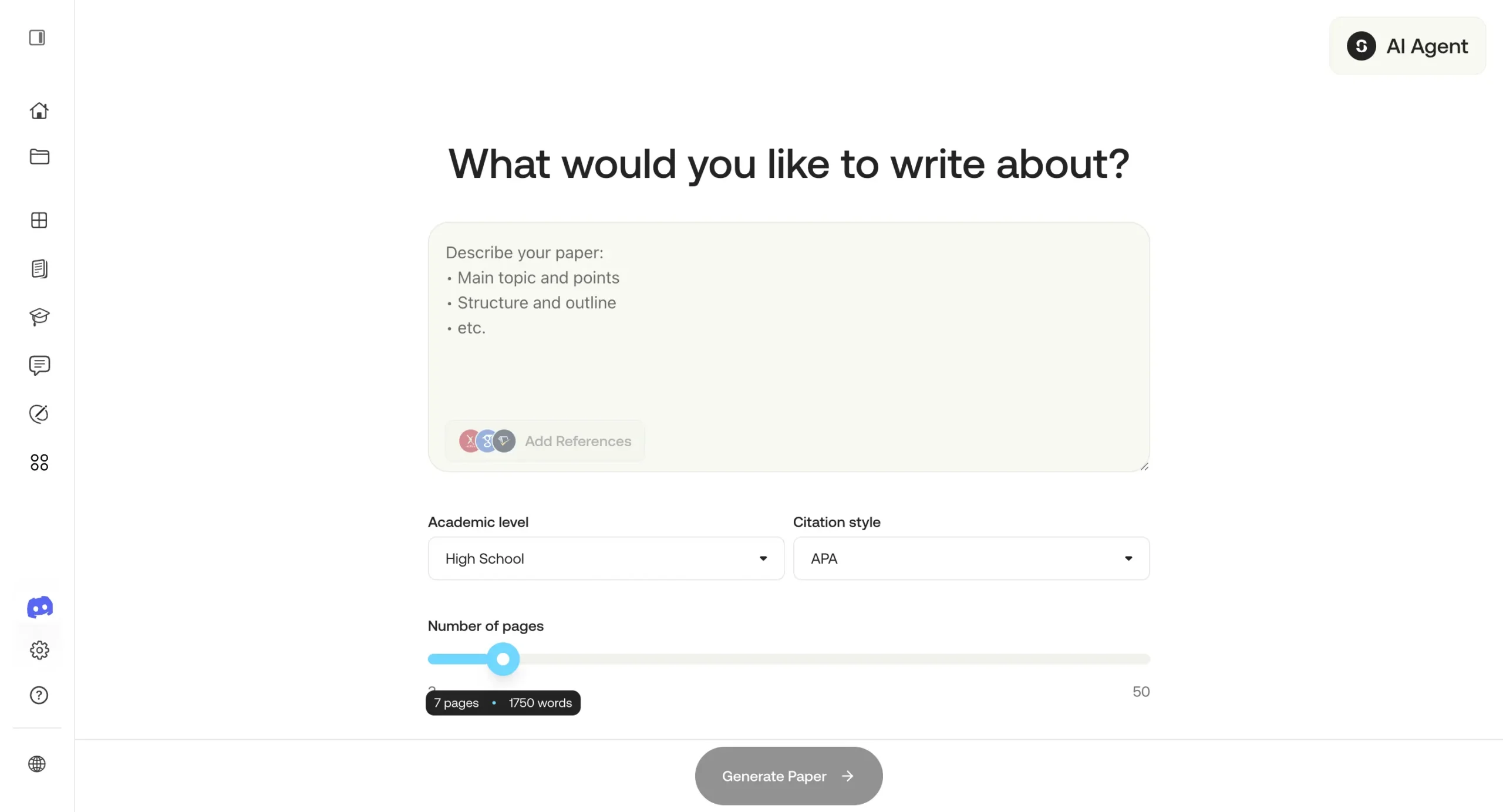
MyStylus generates competent academic prose. Paragraphs flow logically. Sentences follow standard patterns.
But where are the citations?
Like Yomu AI, MyStylus produces academic-sounding text without proper sources. You can "Add References" manually, but the AI should handle this automatically for a tool claiming academic focus.
The Source Finder promises better.
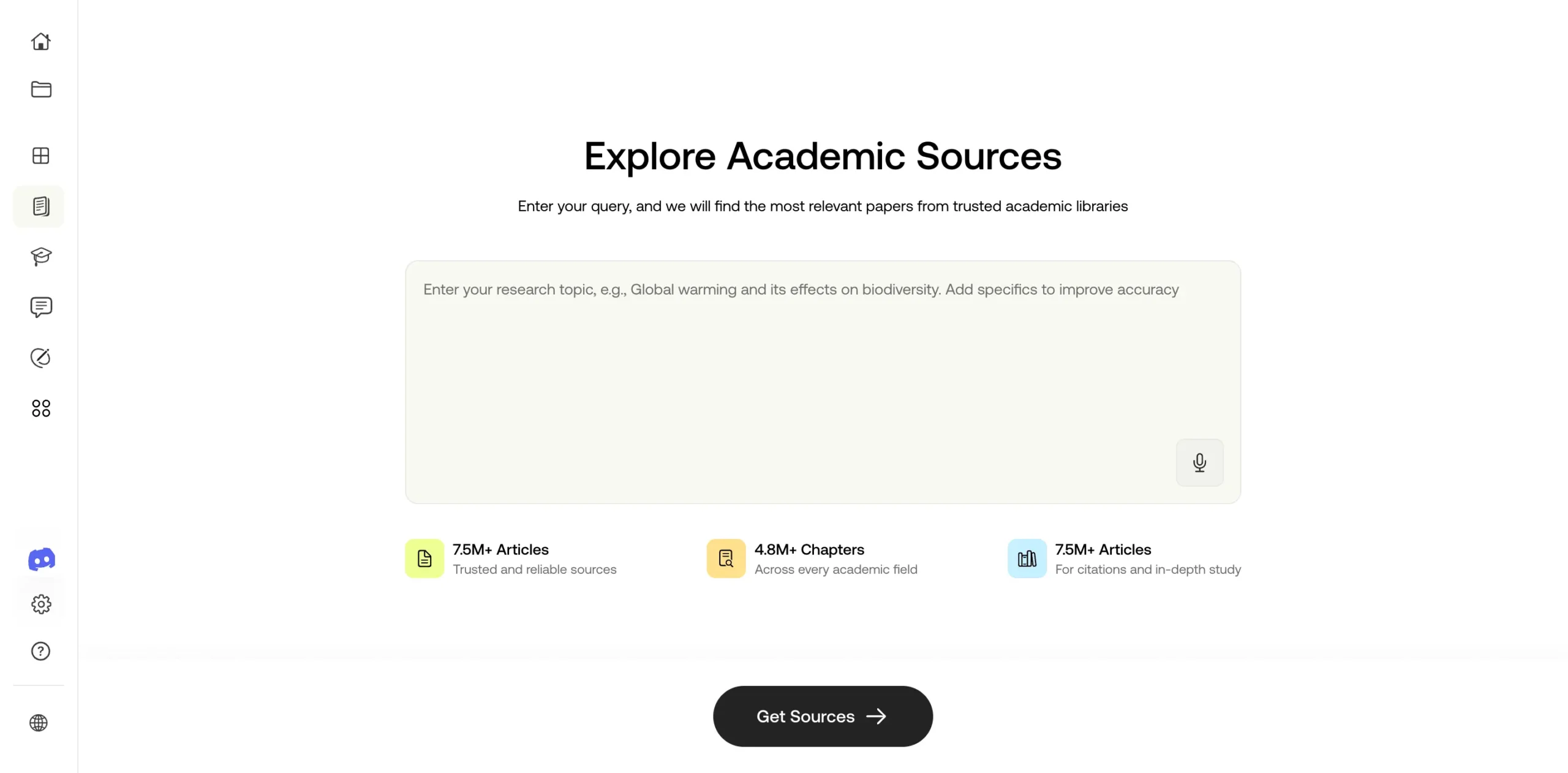
"7.5M+ Articles" and "4.8M+ Chapters" sound impressive. Numbers mean nothing without quality. I searched for recent papers on active learning.
MyStylus returned results.
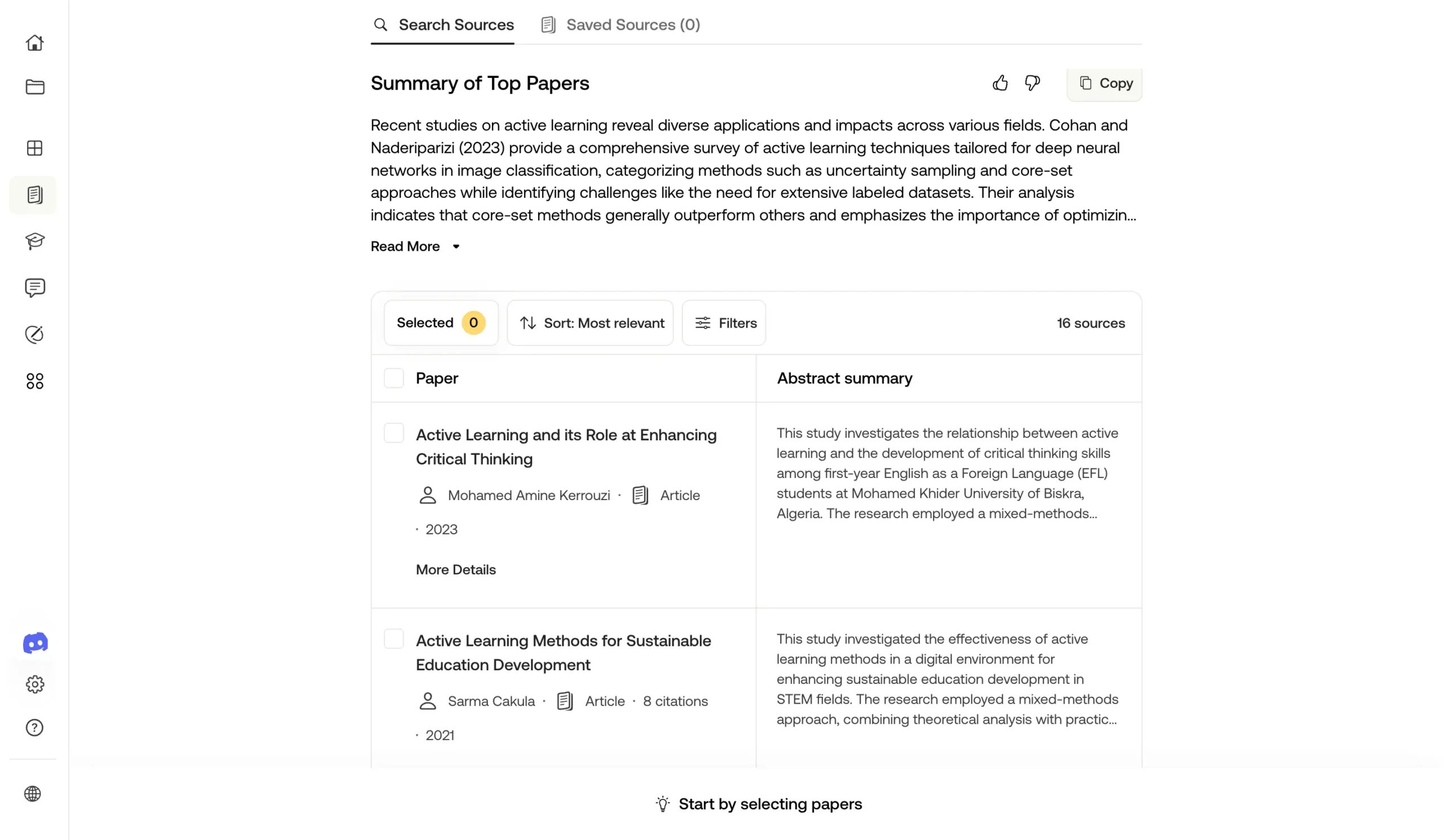
The Paper Grader accepts uploads up to 50 pages.
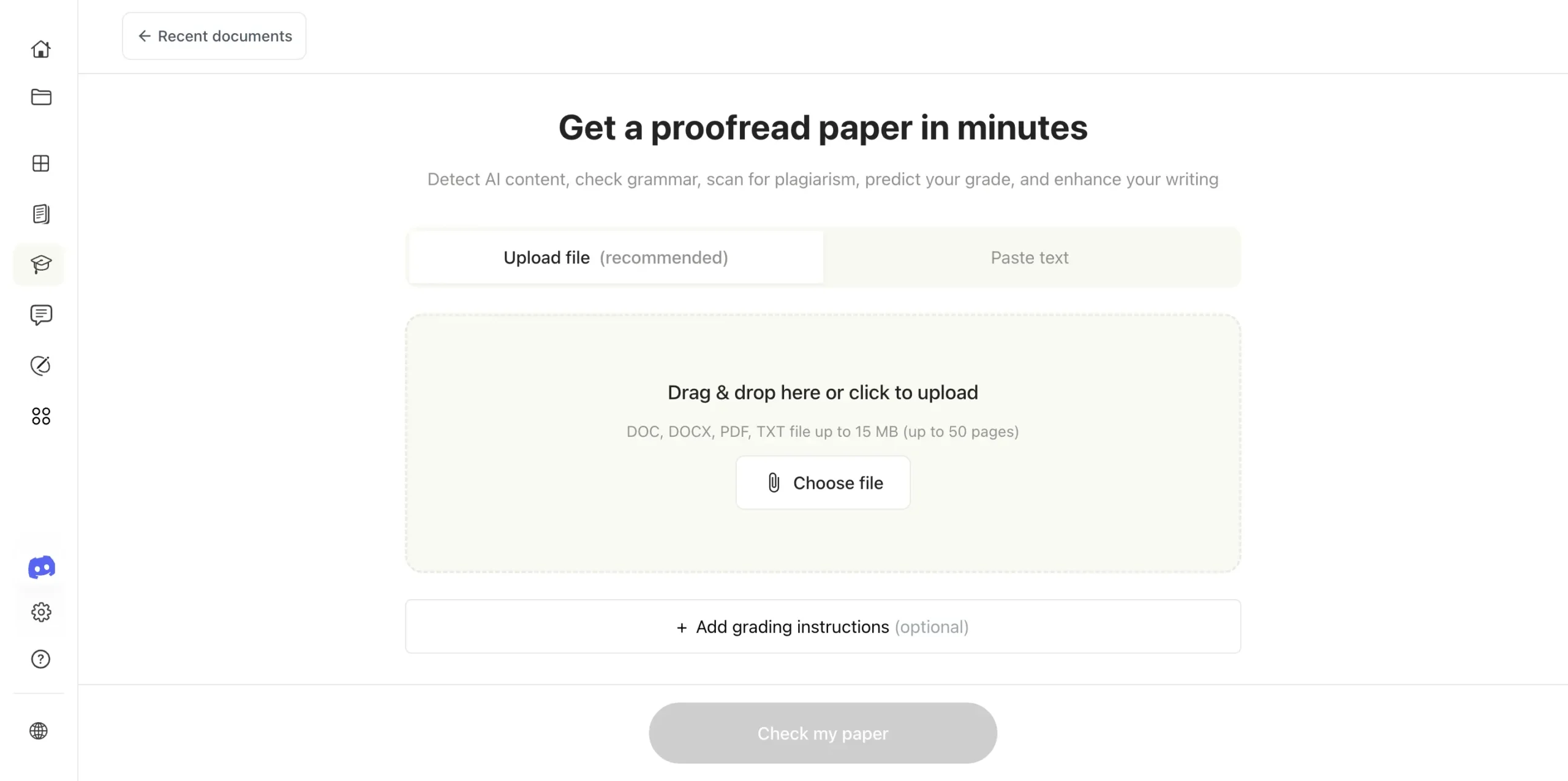
Upload your paper, and MyStylus promises to "Detect AI content, check grammar, scan for plagiarism, predict your grade, and enhance your writing."
These claims strain credibility.
Real plagiarism detection requires massive databases and sophisticated matching algorithms.
Grade prediction demands understanding of professor preferences, course requirements, and institutional standards. MyStylus cannot know these things.
The Chat Agents feature offers variety.
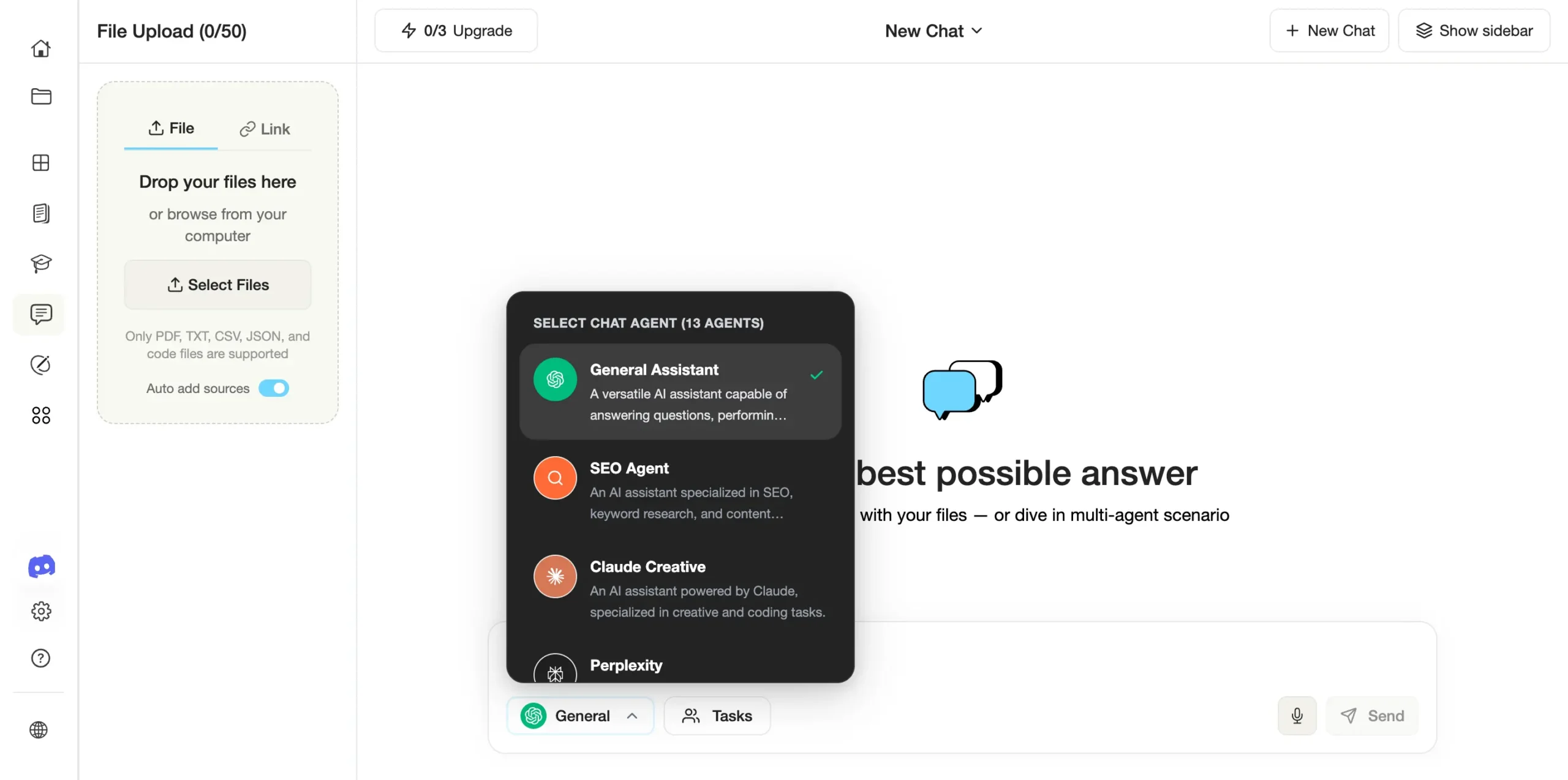
The 13 AI Agents appear, including but not limited to General Assistant, SEO Agent, Claude Creative, and Perplexity.
This transparency helps. You know which AI model handles your request.
But why include an SEO Agent in an academic tool?
Students writing research papers do not need search engine optimization. This feature reveals MyStylus's identity crisis—it cannot decide whether to serve students or content marketers.
The "More Tools" menu confirms this confusion.
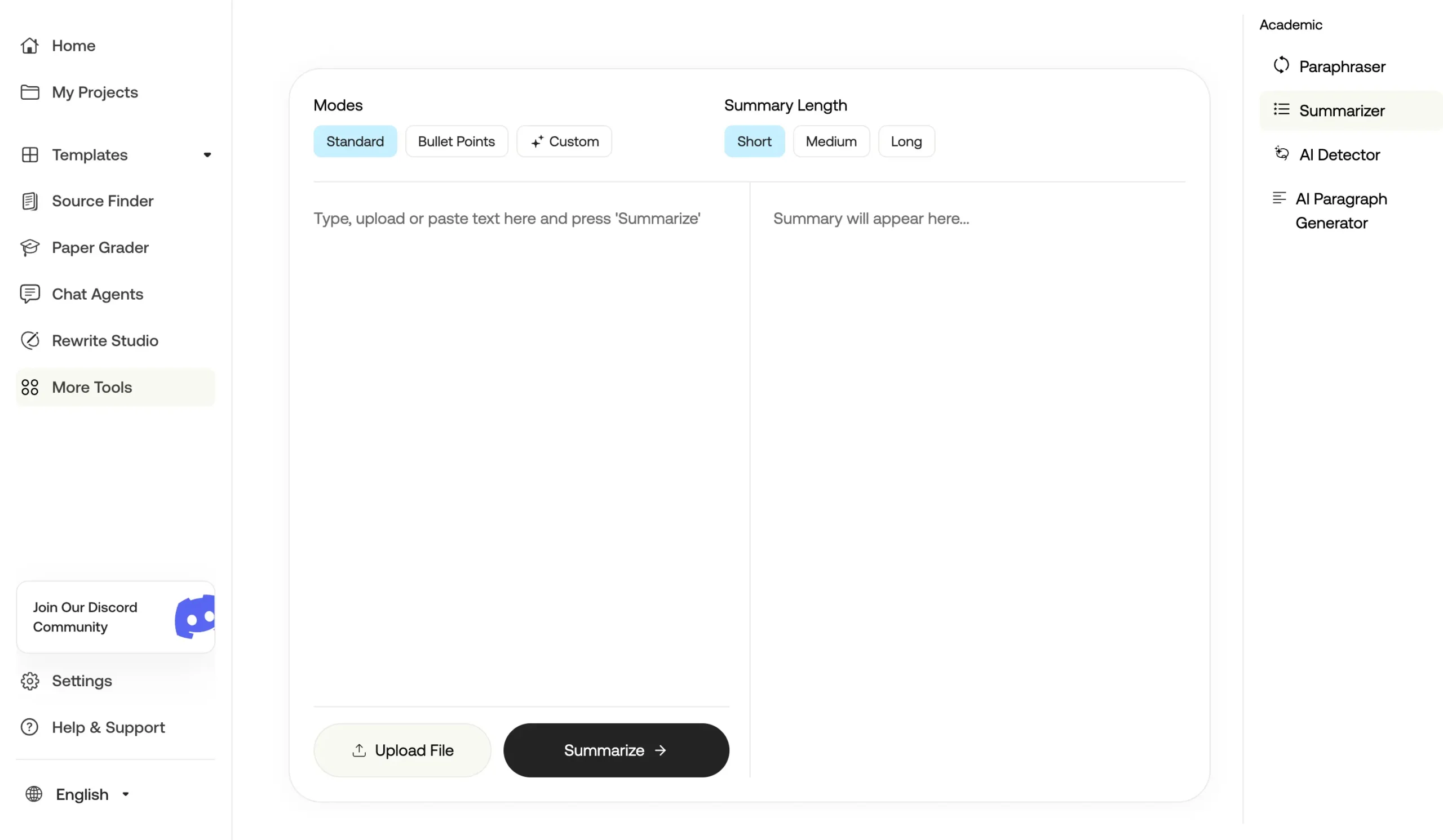
Paraphraser, Summarizer, AI Detector, AI Paragraph Generator. Useful features are buried in a submenu. Poor information architecture reflects poor strategic thinking.
Students needing serious research assistance should choose Paperpal or SciSpace.
Those wanting clean writing help should pick Jenni AI. MyStylus serves those who want many adequate tools rather than few excellent ones.
Pricing
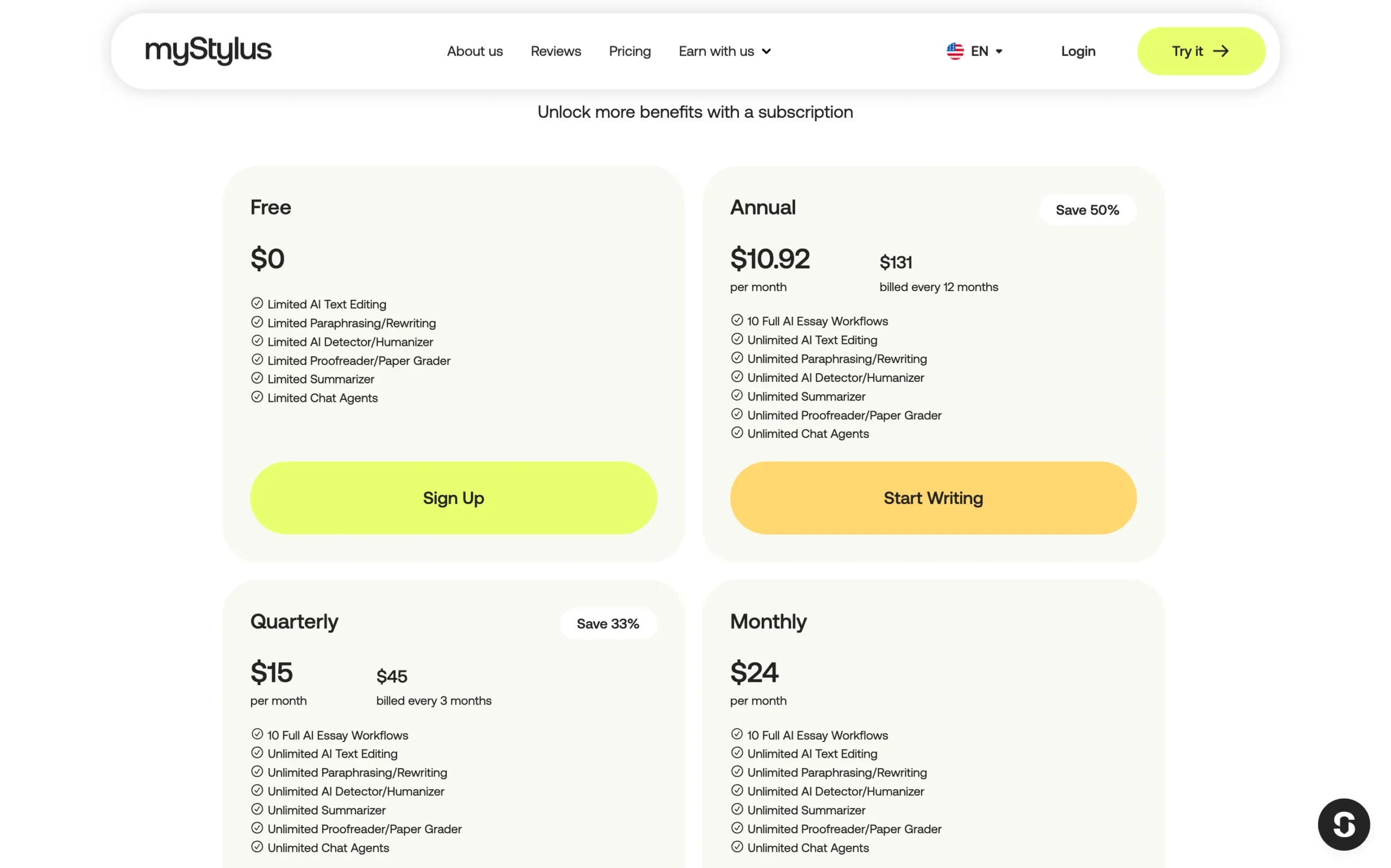
MyStylus offers four pricing tiers:
The math favors annual payment. $131 yearly beats paying $24 monthly for six months. But consider value, not just price.
Paperpal costs $139 yearly and delivers focused excellence. MyStylus costs $131 yearly and delivers scattered adequacy. Eight dollars buys a significant quality difference.
The free tier deserves credit.
Unlike competitors who hide features behind paywalls, MyStylus lets you test everything with limitations. This honest approach helps students make informed decisions.
But honest pricing cannot fix unfocused products.
MyStylus needs to choose its identity: a comprehensive academic platform or a general AI toolbox.
Until then, it remains a budget option for students who need everything and excel at nothing.
Which is the best?
You have read about five tools.
Three work.
Yomu AI and MyStylus generate academic-sounding nonsense without citations. Avoid both until they solve the fundamentals.
The three that matter:
The blank document no longer needs to mock you.
Pick your tool. Start writing. Your ideas deserve better than silence.
Disclosure: Our content is reader-supported. If you click on certain links we may make a commission.
Meet your guide
Dhruvir Zala
I help businesses and professionals stop wasting money on the wrong software. Most software reviews are just marketing in disguise. So I started writing the reviews I wish I had: thoroughly tested, brutally honest, and focused on what matters.
Explore my top picks



